A History of Football in 100 Objects

Five years ago The MMQB—with a nod to the British Museum and the Smithsonian—presented NFL 95, telling the story of the league through 95 artifacts. For the 100th season, we’ve expanded and updated the project. Why is the NFL’s game ball called “The Duke”? Who devised the slingshot goalpost? Whatever happened to that Ford Bronco? From the Hupmobile to Shad Khan’s yacht, Tom Dempsey’s boot to Deion’s bandana, Don Hutson’s cape to Tom Brady’s draft card to the notorious corset that introduced the phrase “wardrobe malfunction” into the American lexicon, here’s a century of the NFL as told through things.
Capsules by the MMQB staff and Damichael Cole, Mitchell Gladstone, Torrey Hart, Bobby Sullivan, Ethan Thomas and Morgan Turner.

“The Duke” Football
It’s hard to think of anything more iconic in football than the “pigskin” itself (which, of course, is really cowskin.) The story behind its nickname: Future Giants owner Wellington Mara was named after the Duke of Wellington by his father, Giants founder Tim Mara. In the 1920s, when Wellington was a ball boy, the players dubbed him “The Duke.” While at the helm of the team, Tim Mara inked the NFL’s deal with game ball supplier Wilson. Following that monumental agreement, Chicago Bears owner and coach George Halas suggested the ball take on a moniker in Wellington’s honor, and it officially did so in 1941. That ball remained standard until the merging of the National Football League and American Football League in 1970.
Wellington Mara fought in World World II, then returned and was named team vice president of the Giants under his brother, Jack. After Jack’s death in 1965, Wellington took over as Giants president. Through the years he earned a reputation among players, fans and colleagues for level-headed leadership and dedication to the Giants and the league.
After his death in 2005, the NFL returned “The Duke” name to the league’s Wilson balls in his honor, while Mara’s legacy lives on through his son, Giants co-owner John Mara. In a time when the league is adopting new rules and has been rocked by controversy, “The Duke” is an homage to simpler times. You wouldn’t really notice if it changed—the label is merely ornamental, after all—but knowing it’s there makes it all the better.

The Frozen Tundra of Lambeau Field
When the Packers and Cowboys awoke on Dec. 31, 1967, the day of the NFL Championship Game, they were greeted by temperatures of minus-15 degrees with the wind chill around minus-48. Lambeau Field, which had fine footing during the walkthrough the previous day, had become a sheet of ice because the turf-heating system had malfunctioned. When the tarps were taken off the field, the moisture on top flash-froze.
Temps warmed to a balmy minus-13 and minus-38 wind chill by kickoff. The conditions would negate one of Dallas’s biggest assets, its team speed. The game went back and forth, and with Dallas leading 17-14 with 4:50 left in the fourth quarter, the Packers had the ball at the 32-yard line. Bart Starr drove the Pack to the 1-yard line with 16 seconds remaining and no timeouts left. Starr and right guard Jerry Kramer thought they could get enough traction for a quarterback sneak. “Run it, and let’s get the hell out of here!” was Vince Lombardi’s reply. Kramer and center Ken Bowman doubled Cowboys defensive tackle Jethro Pugh to allow Starr to cross the goal line for an eventual 20-17 victory.
The game became famous as “the Ice Bowl,” but it generated another memorable phrase when NFL Films’ Steve Sabol, in his script for the highlight movie, described the Lambeau turf as the “frozen tundra.” A legend was born, one that the current groundskeepers don’t really appreciate. Lambeau now has an advanced system of tubes circulating anti-freeze to keep the surface pliant and playable amid the snow and ice of a Wisconsin winter.

The Slingshot Goalpost
Today the forked goalpost is one of the most widely recognized icons of American football. Two metal rods, standing 30 feet above the end zone, have made or broken entire seasons (just as the 2018 Bears). But the iconic goalpost has not always looked the way it now does. It’s the product of an evolving NFL.
When the league was founded in 1920, H-shaped wooden uprights stood on the goal line. The posts shifted between the front and rear of the end zone over the years as league officials attempted to either decrease or increase kicking attempts—in 1933 field goals were too few and far between, so the posts moved to the goal line; by the early ’70s, attempts had surged to the point that in 1974 the league pushed the posts to the back of the end zone in hopes of persuading more teams to prolong drives rather than go for an easy three. They’ve stood at the end line ever since, and it’s impossible to imagine a change.
But what about the shape? The forked or “slingshot” goalpost can be attributed to hobbyist, inventor and retired newspaper distributer Joel Rottman. The story goes that Rottman was having lunch with Montreal Alouettes coach Jim Trimble when he suggested the now-traditional shape after staring at the prongs of his fork. Rottman’s proposition was not only more aesthetically pleasing, but also safer, as it featured one less standard for players to crash into. The unique “gooseneck” design also allowed the post to sit farther back from the goal line, thus interfering less with play. Rottman built an aluminum prototype, which first appeared at the World’s Fair in Montreal; the display earned him a meeting with NFL commissioner Pete Rozelle.
The first forked goalpost was used in the University of Miami’s defeat of Indiana in the Orange Bowl on Oct. 21, 1966. By NFL opening day in 1967, all 16 teams were equipped with yellow slingshot uprights made by Triman (Trimble-Rottman) Tele-goal Co. The shape has since stood for decades in the end zone without issue—except for an occasional problematic post-touchdown dunk—and will continue to do so for the foreseeable future.
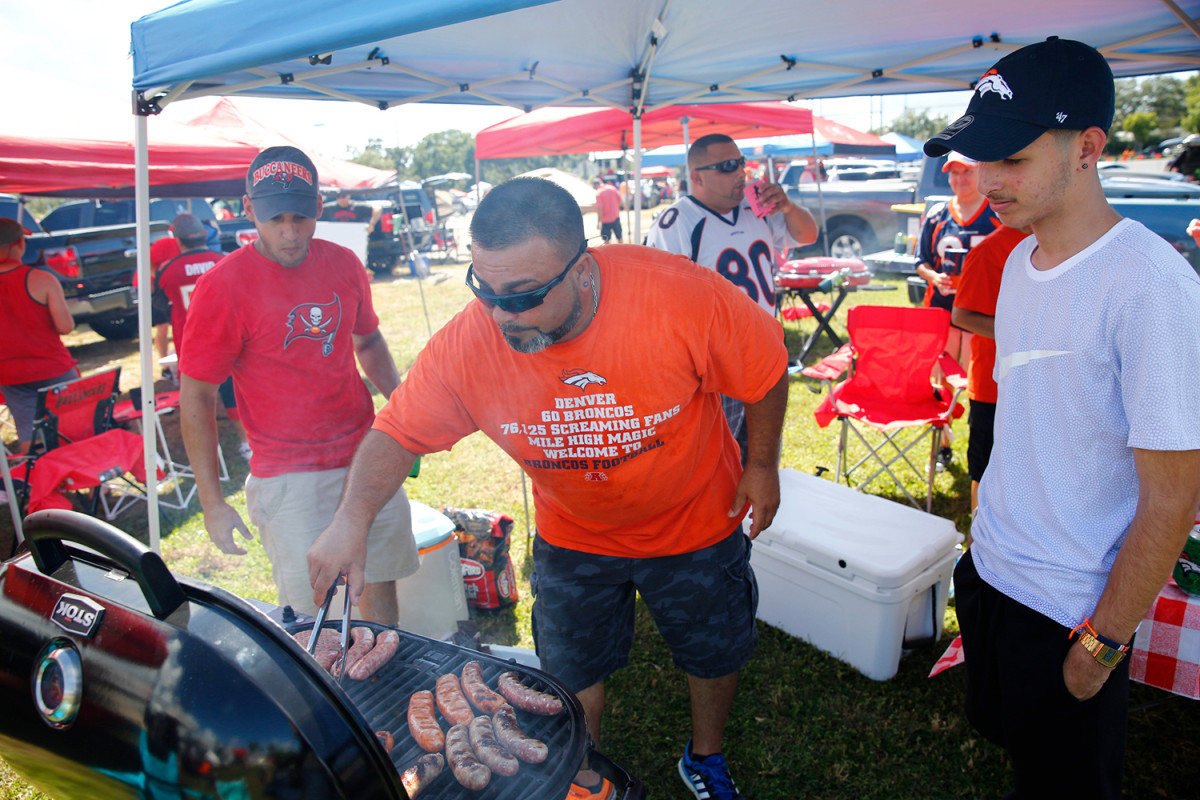
A Tailgating Grill
Ribs and burnt ends in Kansas City, kielbasa in Pittsburgh, beer-can chicken in Cleveland, beer brats in Green Bay, fish tacos in San Diego, beef on weck in Buffalo, char-grilled gulf oysters in New Orleans, smoked brisket in Houston. If this list doesn’t make your mouth water, it should at least conjure images of one of the NFL’s finest time-tested rituals: tailgating.
And where would fans be without the ultimate tool of backyard-to-stadium convenience, the grill? Enter a stadium parking lot a few hours before kickoff, and you are likely greeted with a waft of charcoal-heavy smoke. Thousands of fans congregate around parked cars, tents and grills in extreme heat, bitter cold, harsh winds, rain, sleet, snow and everything in between. It’s not a way to kill time before kickoff, but rather a football tradition epitomizing the camaraderie of a fan base. Tailgating represents the devotion not only to a team, but also to the traditions those teams have become synonymous with. Faces are painted, fight songs are recited, beverages are consumed, footballs are tossed and the aura of optimism is contagious. These few hours represent football fandom at its purest, and thanks to the grill, it’s delicious.

Stickum
Al Davis was famous for his catchphrase Just win, baby, though some Raiders of the ’70s and ’80s might have taken the owner’s words a bit too literally.
That’s one way to explain why some players smeared themselves with this dark yellow substance before games. Stickum was said to enhance the potential for sure-handed receptions—Oakland Hall of Fame receiver Fred Biletnikoff dabbed the substance on his socks so he could easily reach down for a shmear—or for members of the secondary to elongate the bump in bump-and-run coverage. Though numerous players on plenty of teams lathered up, Stickum is is probably most associated with Raiders defensive back Lester Hayes, who won the 1980 NFL Defensive Player of the Year award with 13 interceptions, then added five more en route to Super Bowl XV. Hayes smeared a half a jar (about nine ounces) on his body each game, the honey-like goo dripped from his forearms, hands and uniform. Competitive advantage, baby.
The NFL banned Stickum and similar adhesives in 1981. In his final six seasons, Hayes never tallied more than four interceptions. Of playing with Stickum, he told the Houston Chronicle in 2004: “I could catch a football behind my back on one knee. It was tremendous stuff.”
Stickum hasn’t been seen since, though the NFL opened an investigation into the Chargers in 2012 after an on-field official thought a towel on San Diego’s sideline might have a sticky substance on it. The NFL found no wrongdoing but fined the team $20,000 for not immediately complying with the official. Consider that being caught in a sticky situation.

Vince Lombardi’s Chalkboard
Vince Lombardi’s domain was Lambeau Field, but his mastery of football was evident on another expanse of green: the chalkboard. That’s where Lombardi drew up the plays that established the Packers’ dynasty of the 1960s.
Plays like the power sweep, the perfect vehicle to illustrate Green Bay’s dominance—and to characterize the coach that made the Packers great. “There is nothing spectacular about it,” Lombardi once said of the sweep that came to bear his name. “It’s my number one play because it requires all eleven men to play as one to make it succeed, and that’s what ‘team’ means.” Every player’s assignment was crucial, but it highlighted the execution of the three interior offensive linemen, the center and both guards, who normally toiled in anonymity. The center, first Jim Ringo and later Ken Bowman, had to execute a difficult cutoff block, against either a tackle or linebacker. That allowed both guards, Jerry Kramer and Fuzzy Thurston, time to pull outside the playside tackle. The off guard had the toughest duty, since he had the farthest to run. “I know it’s a difficult maneuver,” Lombardi once said. “But [the off guard] has to get there. I don’t give a damn whether he enjoys getting there or not.” Then the patience and reading of the blocks by halfback Paul Hornung and fullback Jim Taylor finished off the play.
“You think there’s anything special about this sweep?” Lombardi once asked a writer. “Well, there isn’t. It’s as basic a play as there can be in football. We simply do it over and over and over. … There can never be enough emphasis on repetition. I want my players to be able to run this sweep in their sleep. If we call the sweep twenty times, I’ll expect it to work twenty times ... not eighteen, not nineteen. We do it often enough in practice so that no excuse can exist for screwing it up.”

The Terrible Towel
“Your idea was pure genius,” Steelers president Dan Rooney once told team broadcaster Myron Cope. “But you were too stupid to know what you were doing.”
WTAE was looking for a gimmick. It was December 1975, and in two weeks the defending Super Bowl champion Pittsburgh Steelers would host the Baltimore Colts for a playoff game. The team’s flagship radio station was looking for something to both energize fans and draw the attention of sponsors. Cope, the team’s radio broadcaster, was asked to join a brainstorming session. As Cope recalled in a 1979 essay for Sports Illustrated:
“What we need here,” I said, “is something that’s lightweight and portable and already is owned by just about every fan.”
“How about towels?” [VP of sales Larry] Garrett said.
“A towel?” It had possibilities. “We could call it the Terrible Towel,” I said. “Yes. And I can go on radio and television proclaiming, The Terrible Towel is poised to strike!”
“Gold and black towels, the colors of the Steelers,” someone piped.
“No,” I said. “Black won’t provide color. We’ll tell ’em to bring gold or yellow towels.”
The concept didn’t sit well with players. (Linebacker Andy Russell: “What’s this crap about a towel? We’re not a gimmick team.”) But it was a hit with fans. Cope approximated that 30,000 towels were in attendance when Pittsburgh beat the Colts. The Steelers went on to win a second straight Super Bowl, making Cope’s gimmick a part of the team’s lore.
Before he passed away in 2008, Cope ensured that the Terrible Towel would have an impact beyond the gridiron. His son, Danny, was born severely autistic and required 24-hour care. The Copes sent him to the Allegheny Valley School, where he developed further than Myron thought possible. In 1996, Cope thanked the school by giving it the trademark rights to the Terrible Towel, along with the millions of dollars in royalties that come with it.
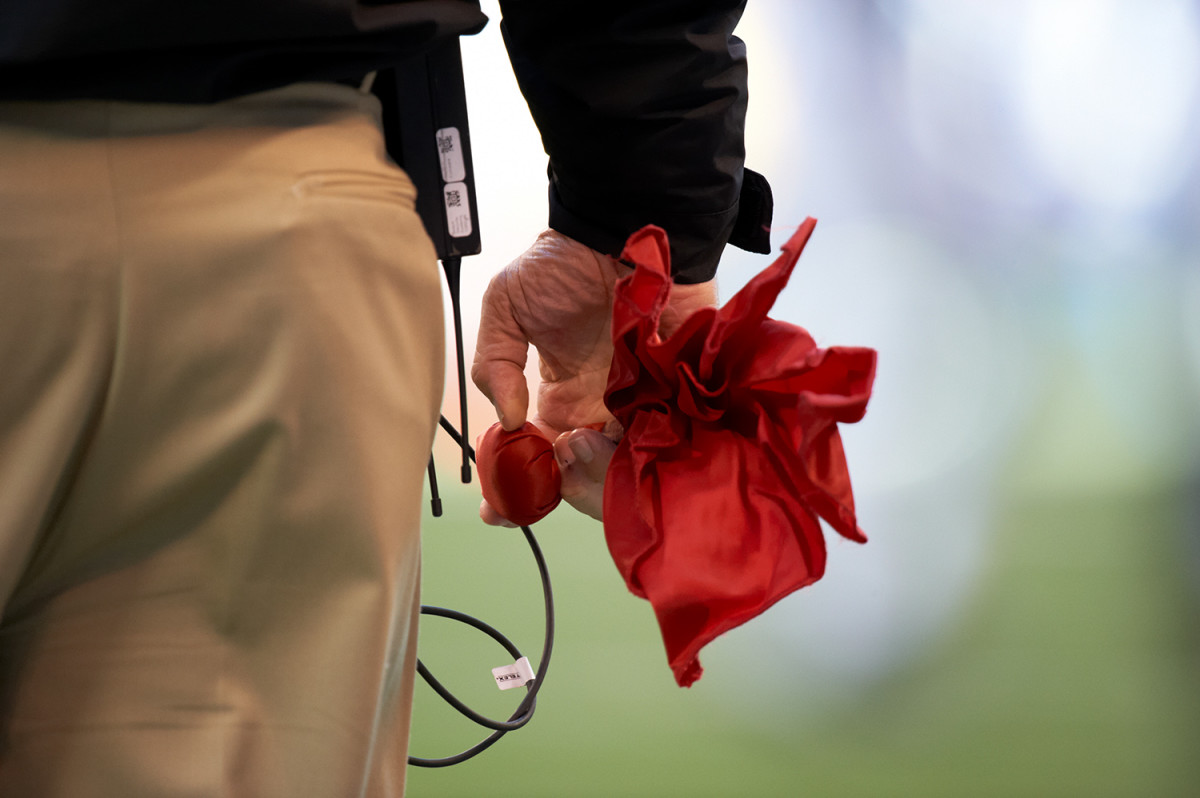
The Challenge Flag
Since its inception in 1999, the coaches’ challenge has contributed to countless game-changing moments in the NFL. With the mere drop of a hanky, NFL coaches have the power to force officials to reconsider their calls—not only once, but twice or even three times per half. The results of those challenges can break hearts, or mend them.
In replay review’s first go-round in the league, from 1986 to ’91, there were no coaches’ challenges. Reviews were initiated by an official in the booth, or occasionally by field officials who wanted a second look at a play. When replay returned to the league in ’99, coaches were given two challenges per half (except inside two minutes, when officials would take over), and would lose a timeout if a ruling was upheld. Until 2004, coaches would call for a review via a pager. That gave way to the simpler—and much more demonstrative—red challenge flag. Over the years, as technology advanced and the system was tweaked, the rate of successful challenges has climbed fairly steadily, from 29% in 1999 to 49% in 2019.
The suite of challengeable plays has evolved over the years, and some calls (scoring plays, change of possession) now are automatically reviewed, taking the pressure off the shoulders of coaches. On the other hand, they’re sometimes left itching to throw a flag when they can’t; witness Sean Payton’s impotent fury over the pass interference non-call in the January 2019 NFC title game. It’s cold comfort for Payton that, beginning in the 2019 season, he and his coaching brethren can now toss the flag to challenge pass interference.

The 12th Man Flag
It has been unfurled below the Statue of Liberty and raised above the Space Needle. President Obama posed for photos while holding it up. In the months surrounding Seattle’s Super Bowl XLVIII win, the 12th Man Flag experienced a tour-de-force of sightseeing. But for fans of the Seahawks, the electric-blue nylon piece of fabric with a white No. 12 printed in the center is as familiar as any player on the Seattle roster.
The flag—hoisted before kickoff for each game at CenturyLink Field—represents community, devotion and passion for a fan base that prides itself in having the best, and loudest, home-field advantage in the NFL.
Whether Seattle’s is the best, and whether the Seahawks even have dibs on the term “12th Man,” is up for debate. (Just ask Texas A & M, which sued the Seahawks to protect that trademark in 2006; the two parties settled.) Not in question, however, is CenturyLink’s volume, which, depending on whom you ask, reaches either righteous pandemonium or insufferable loudness. In a night game against the Saints in 2013, Seattle’s fan base regained the Guinness World Record for crowd noise with a 137.6-decibel reading (Kansas City fans at Arrowhead Stadium have been in a tug-of-war with Seattle for this distinction). Another Pacific Northwest legend was born in a 2011 playoff game when fans cheered so hard during Marshawn Lynch’s 67-yard Beast Mode touchdown run that they generated recordable seismic activity. From the field to space, from Lady Liberty to the White House, Seahawks fans and their beloved flag set new standards for fan engagement—and lung capacity.

Mel Kiper’s Draft Book
How did this happen? And why hasn’t it happened for baseball, ice hockey or basketball? Everyone watches the NFL draft. In television ratings, it blasts playoff games in every other major North American sport out of the water. With the help of Kiper and dozens of draft gurus who were spawned in his image, ESPN and the NFL turned a quiet hotel ballroom tradition begun in 1936 into the true kickoff of the season; the league even pushed back the draft a month to May to hype the hypiest NFL event other than Super Bowl even more.
Here’s how this happened: A skinny, draft-obsessed kid from Baltimore began charting the NFL’s annual talent parade at age 12 and wrote his first comprehensive draft preview in 1979 as a high school senior. He sent that guide to every team in the league, seeking feedback, and soon he had developed contacts throughout the NFL among personnel people who were impressed with the kid’s dedication, and his knowledge. Operating out of his parents’ basement, Kiper created a market basically out of nothing, selling his draft guide to subscribers and working the phones—“I’d talk to anyone who called me, two minutes to two hours,” he told SI in ’92—to build a network and a reputation. The outsider became an insider in 1983 when Colts GM Ernie Accorsi hired him as a personal assistant. Accorsi would leave the team after the John Elway episode that year, but Kiper had arrived. He made his first appearance on ESPN in 1984 and became a fixture on the network’s draft-day coverage. He also produced his Blue Book every year, until 2014.
No matter. An army of draftniks with their own websites arrived in his wake, all mulling over the same information and issuing their own mock drafts and predictions. The draft has become a landmark on the spring sports calendar. Some say it’s a non-event: No one knows whether a guy will be a Hall of Famer or a bust until he hits the field, and Kiper has had his share of misses over the years. But good on Mel for making his dream come true and helping create an entirely new industry. Not too many people can say that.

Sheet Music from “Brian’s Song”
As legend goes, sometime after Bears running back Brian Piccolo was diagnosed with embryonic cell carcinoma, he told his wife: “You can’t cry. It’s a league rule.”
In the early ’70s, that sentiment seemed to stretch from the NFL to its fan base. Then Piccolo’s story changed everything. A 90-minute ABC-TV movie on the Piccolo’s fellow Bears back Gale Sayers, a bond that only strengthened as Piccolo’s cancer progressed, tugged America’s heartstrings so hard that it’s nearly impossible to find a fan who can talk about the 1971 film without misting up. Brian’s Song was the movie that taught grown men it’s OK to cry.
What was it about the film that generated such strong emotion? Perhaps it was the nuanced performances of James Caan and Billy Dee Williams. Perhaps it’s just the tale of two men—one white, one black, with seemingly little in common besides football—who form a strong friendship, organically, that endures through tragedy. Piccolo died in 1970 at age 26, but the movie, as its tagline suggests, is “a true story about love.”
Or, perhaps, the sobs stem from the X-factor that ties it all together: music. Composer Michel Legrand (The Thomas Crown Affair, Summer of ’42) was a master of sweeping instrumentals that amplify a movie’s sentiment, and in Brian’s Song nothing tugged the heartstrings more irresistably than its theme, “The Hands of Time.” Legrand’s score builds with the story’s arc, the theme presented in countless variations, and by the time Sayers delivers his climactic, heart-wrenching speech—“I love Brian Piccolo, and I’d like all of you to love him too. ... Please ask God to love him”—the accompanying theme hits its most wistful note. Even the hardest-bitten viewer has been reduced to a blubbering heap. In a good way.
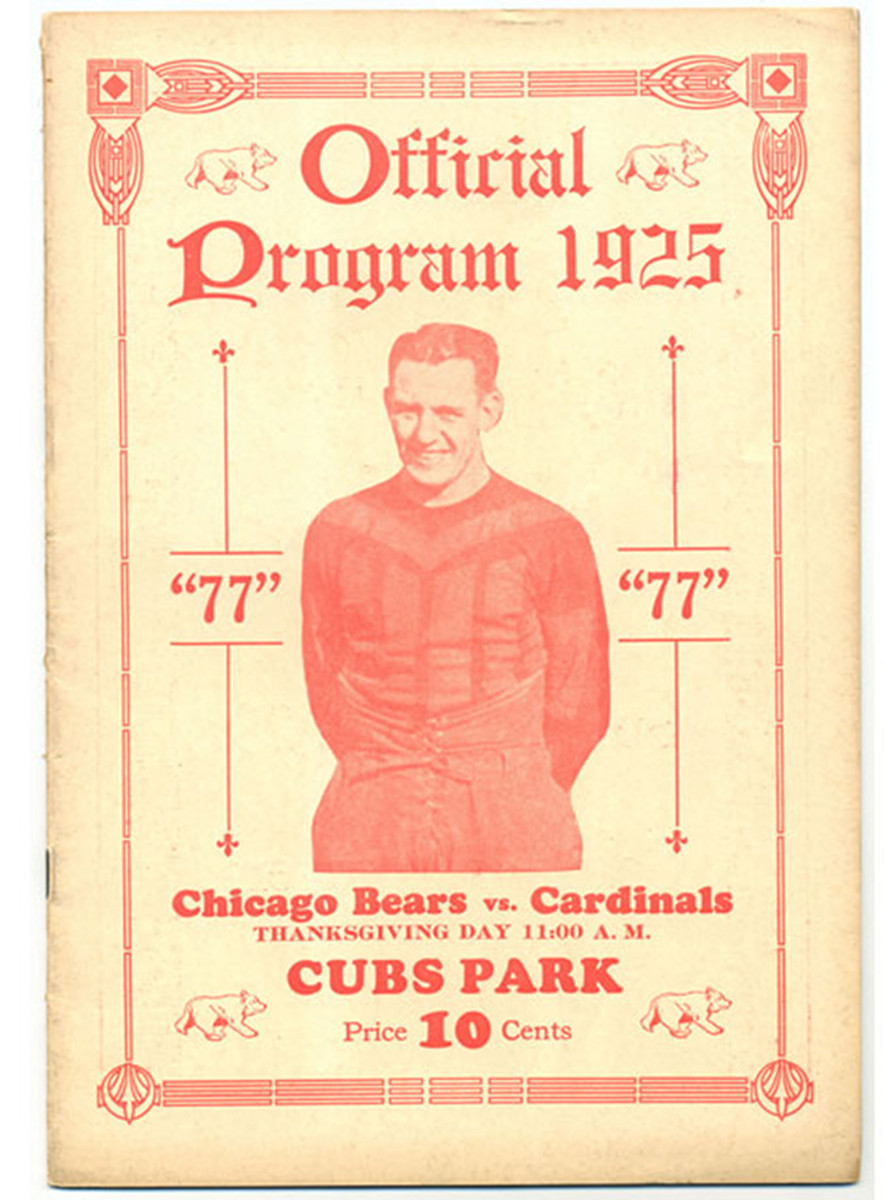
Program From Red Grange’s Barnstorming Tour
Before 1925, professional football was struggling to gain an audience. More than 20 franchises had folded in the previous four years, and attendance ranged from a few hundred on a good day to mere dozens of spectators on a slow one. That all changed when Harold “Red” Grange, who was called the Galloping Ghost by fawning reporters, became the first player to drop out of school (the University of Illinois) and become a professional football player.
Days later, Grange joined the Chicago Bears and embarked on a 19-game, 66-day tour during the winter of 1925-26. The cross-country tour was organized by C.C. Pyle, considered the first football agent, who signed Grange to a multiyear contract. In his first eight games as a pro, Grange played before an estimated 200,000 fans, including some 70,000 at the Polo Grounds against the Giants, which helped to rescue New York owner Tim Mara from $45,000 in debt. Yankees baseball legend Babe Ruth was among those in attendance in New York that day, as were more than 100 sportswriters. Professional football had finally entered the consciousness of the country, and it had Grange to thank for it.

“The Super Bowl Shuffle” Record
There will be eternal debate about the greatest NFL team of all time, but the ’85 Bears can claim one thing no other can: They produced a hit single.
Superstition be damned, the self-described Chicago Bears Shufflin’ Crew recorded the catchy “Super Bowl Shuffle” and accompanying video months before Super Bowl XX. Cocky? Sure. But that’s the way the ’85 Bears played, rattling off a 15-1 record with Walter Payton and perhaps the greatest defense ever. Receiver Willie Gault (and his swerving hips) spearheaded the music project with Red Label Records, recruiting nearly half the roster to join as rappers, backup dancers or the band. Payton was darn good at spitting rhyme, and most of the Bears were pretty bad at dancing. The jingle caught on, rising to No. 41 on the Billboard Hot 100 and selling around a half-million copies, with the profits designated for charity. But the Shuffle wouldn’t have its enduring place in history if the team hadn’t backed it up on the field. The Bears did so in convincing fashion, beating the Patriots by a historically lopsided score of 46-10 “to give Chicago,” as Payton had rapped, “a Super Bowl champ.”
The Shuffle’s success spawned a slew of imitators in subsequent years, from Mike Ditka’s Coach-tastic “Grabowski Shuffle” (in which Ditka extols the virtues of the common fan) to Key & Peele’s fabulous East/West Bowl Rap. But there’s just nothing to compare to the Bears’ trend-setting opus.

Big Dawg’s Dawg Pound Mask
The history of Cleveland’s Dawg Pound dates to 1985, when fans overheard two Browns cornerbacks, Hanford Dixon and Frank Minnifield, barking at their defensive line. Dixon called his fellow defenders the Dawgs to inspire them during the ’85 season, and fans ran with the idea. Barking was the first trademark of the Dawg Pound, but when John Big Dawg Thompson donned a dog mask, the fan section was given its face.
His nickname has no quotes around it—he legally added it as his middle name. In a way, that reflects just how important he is to the Browns. Thompson’s huge frame and droopy dog mask have served as the leading image for the Dawg Pound for decades. His passion and recognizable nature earned him a spot in the Hall of Fans in Canton, and his importance to the team allowed him to travel to Washington D.C. to lobby for the Browns to stay in Cleveland in the mid 1990s.
That effort failed, of course, as Art Modell moved the franchise to Baltimore in 1995. But it was because of fans like Big Dawg, Clevelanders fanatical about their football team, that the NFL knew it had to bring a franchise back to Northeast Ohio, which it did in 1999. To the average NFL fan, Big Dawg and his rubber mask are a fun novelty, but for Cleveland, he and his compatriots in the Dawg Pound represent the vital place the Browns occupy in the culture of the city.

Frank Reich’s 1993 Wild-Card Game Hand-Warmer
Beset by injuries, the Buffalo Bills were without their franchise quarterback (Jim Kelly), linebacker (Cornelius Bennett) and running back (Thurman Thomas) when they trailed the Houston Oilers, 35-3, at home in the second half of a wild-card playoff game on Jan. 3, 1993. What’s more, Houston had defeated Buffalo, 27-3, in the regular-season finale the week before. So it was no wonder that Bills fans (who didn’t sell out the game to begin with) headed for the exits early at Ralph Wilson Stadium.
But Kelly’s backup, Frank Reich, was just keeping his hands warm in the 24-degree wind chill that day. After falling behind by 32 points, Reich and Bills outscored the Oilers 38-3 to win, 41-38, setting the record for biggest comeback in league history.
It started innocently enough, with a 1-yard touchdown run by Kenneth Davis to make it 35-10. Then Bills kicker Steve Christie recovered his own kickoff (dubbed a mistake by coach Marv Levy), and a controversial 38-yard touchdown pass from Reich to Don Beebe made it 35-17 (replays showed Beebe stepping out of bounds). Three more Reich TD passes in seven minutes, one after a botched snap on an Oilers’ 31-yard field goal attempt, gave the Bills a 38-35 lead with 3:08 left to play. But Houston quarterback Warren Moon marched the Oilers 63 yards to set up the game-tying 26-yard field goal.
On the third play of overtime, Moon was intercepted by Bills defensive back Nate Odomes. After two runs, Christie booted the game-winning field goal from 32 yards out. Reich completed 21 of 34 passes for 289 yards and four touchdowns. He also led the Bills to a road win over the Steelers the next week but was replaced by the recovered Kelly in the AFC title game as the Bills advanced to their third straight Super Bowl. So much for the hot hand.

Jimmy Johnson’s Hair
Anyone who watched a Cowboys game in the early 1990s surely pondered this critical question: Does Jimmy Johnson’s hair move? That shiny swirl atop his head seemed to be locked in place—an all-too-appropriate symbol of those flashy, cocksure Cowboys teams he coached. Though he couldn’t take it with him on the sideline, the coach was known to carry a canister of Paul Mitchell Freeze and Shine Super Spray in his briefcase anywhere he went.
Jerry Jones bought the team in 1989 and replaced Tom Landry with Johnson, expecting Johnson’s success at the University of Miami to transfer to the NFL. The Cowboys stockpiled talent, drafting Troy Aikman in ’89 and Emmitt Smith a year later to form “The Triplets” along with receiver Michael Irvin. America’s Team won back-to-back Super Bowls in 1992 and 1993, but the power struggle between Jones and his coach resulted in Johnson’s resignation after the Super Bowl XXVIII win. Dallas won one more championship with Johnson’s building blocks, in 1995; Johnson’s coaching career, meanwhile, ended in ’99 after four unspectacular seasons with the Dolphins. His perfectly coiffed mane can be seen on Sundays in his role as an analyst for FOX Sports.
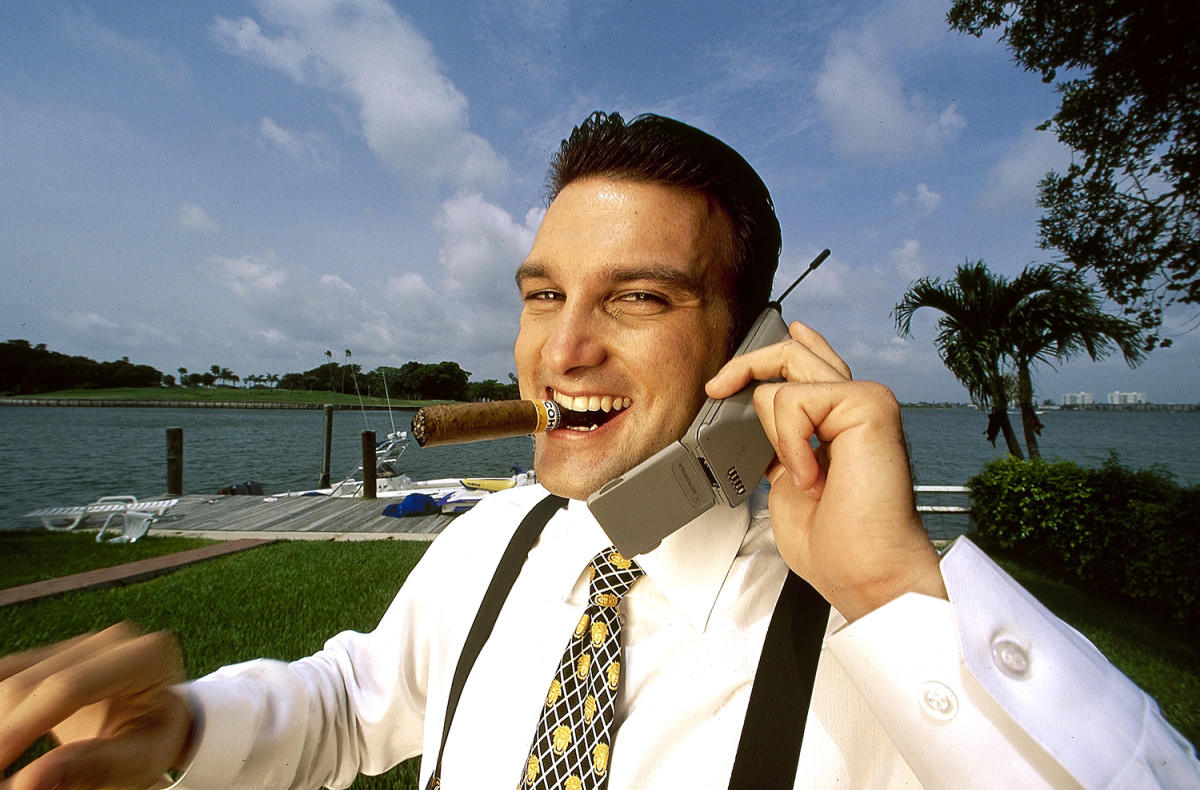
Drew Rosenhaus’s Cell Phone
Agent Drew Rosenhaus is seemingly always on his cell phone—even if some of the calls aren’t quite organic. Take, for example, the 2003 draft, when cameras zoomed in on Rosenhaus sitting next to his client, projected first-rounder Willie McGahee. As the picks rolled on, McGahee appeared nervous. Then the halfback’s cell phone rang—turns out, Rosenhaus was on the other line. “I didn’t want it to make it look like our phones weren’t ringing,” Rosenhaus told the AP afterward. “Willis and I had a little chat to create the perception that we weren’t waiting for teams to call us.” The Bills chose McGahee at No. 23.
Rosenhaus’ tactics are unconventional and at times controversial, but he perfectly illustrates the breed of super-agent that emerged in the NFL’s salary-cap era. In fact, agents like Rosenhaus have become so ubiquitous that it’s hard to imagine an NFL without them. (It did exist; Vince Lombardi famously frowned upon players who wanted to hire representation.)
Rosenhaus earned his accreditation at age 22, appeared on the cover of Sports Illustrated eight years later and accumulated a roster of A-list clients for whom he has negotiated more than $2 billion worth of contracts. He did so by working tirelessly, making countless calls to general managers, players and anyone in between to maximize potential earnings. (Rosenhaus titled his autobiography A Shark Never Sleeps.) SI’s 1996 cover story deemed Rosenhaus “the most hated man in the NFL”—his detractors include rivals and former clients—though here’s something everyone might agree on: Listening in on his phone conversations would be priceless.

He Hate Me’s XFL Jersey
In case it wasn’t obvious that a Vince McMahon-led, WWE-influenced pro football league would be different from the NFL, there was the guy with “He Hate Me” on his jersey.
Rod Smart was the poster child for the XFL, the ill-fated extreme football venture that valued the outrageous. Teams had names like the Hitmen and Maniax while Smart, a running back for the Las Vegas Outlaws, drew plenty of attention with the moniker he decided to wear on his back for the league’s lone season in 2001. (Smart would go on to play six seasons in the NFL, making a Super Bowl appearance with the Panthers in ’04.)
With trash-talking stadium announcers, cameras in the huddle and no penalties for roughness, the XFL was mostly about entertainment. Instead of starting the game with a coin toss, a ball was placed on the ground and one player on each team was sent to grapple for it. The league opened with tremendous buzz, and the February-April schedule smartly complemented the NFL calendar, but the novelty quickly wore off. When the league folded, dozens of XFL alums went on to NFL careers, from Tommy Maddox to Steve Gleason to Paris Lenon, who was the last XFLer to play in the NFL, in 2013. Both the WWE and NBC lost millions on the league—the cost of challenging the almighty shield—but McMahon is planning to resurrect the league (minus many of its extreme elements) in 2020.

A Football Air Pressure Gauge
Regardless of where you stand on the divide between the Patriots and the rest of the world, there’s no denying that “Deflategate” was one of the wildest and most bizarre controversies in the history of American sports. Did Tom Brady and the Patriots conspire to deflate the footballs used in the January 2015 AFC title game against the Colts at Gillette Stadium, sucking the air out of the balls to make them softer and presumably provide the home team with a competitive advantage? Or was the hubbub prompted and promulgated by jealous opponents and a league looking to humble Belichick, Brady and the New England dynasty?
After a Colts interception in the first half, Indy staffers checked the ball and reportedly found it to be under 12.5 psi, the minimum pressure allowed by league rules. Concerns were expressed to referee Walt Anderson, and two alternate officials, using two separate gauges, checked 11 Pats’ balls at halftime, finding all of them under the 12.5 lower limit. A league investigation proceeded, litigation ensued, and Brady was ultimately suspended for four games, and the Patriots fined $1 million.
Never mind that the two gauges used did not agree on any of the readings, or that the league had never previously checked balls at halftime to see how environmental and playing conditions affected inflation levels, or that NFL vice president of football operations Troy Vincent admitted he was unaware of the Ideal Gas Law, the scientific principle that governs air pressure. Or that that Patriots actually did better after the balls were brought back up to regulation—scoring 28 unanswered points in the second half to win 45–10. The punishment would stand.
Throughout the process the NFL looked both petty and ignorant of basic science. MIT professor John Leonard was one of many who ridiculed the league’s arguments and testing protocols. After the saga played out, Brady ultimately sat out the first four games of the 2017 season—then led New England to a Super Bowl victory.

Mean Joe Greene’s Coke-Ad Jersey
The premise was brilliant: After he drank a Coca-Cola, Joe Greene would be revealed to America as a man who wasn’t so mean after all. The TV commercial captured viewers’ hearts when it aired in October 1979, and then again during Super Bowl XIV—the fourth championship won by Greene’s Steelers.
A cornerstone of Pittsburgh’s famed Steel Curtain defensive front, Mean Joe had a reputation that matched his hulking 6'4", 275-pound frame. But as he’s limping to the locker room in the commercial, more vulnerable than he’d ever been seen on the field, he’s offered a Coke by an awestruck kid and suddenly turns sunny. Greene tosses the boy his jersey while intoning the classic line, “Hey kid … catch!” Greene’s surge in popularity lasted well beyond his 13-year, 10-Pro Bowl career—and the fact that a Steelers player was picked to sell Coca-Colas (and a smile) meant something, too. The ’70s were the Steelers’ dynasty years, when Chuck Noll, Terry Bradshaw, Franco Harris and Greene won four championships together in six seasons, and the team’s tough, blue-collar image was embraced far beyond Western Pennsylvania.
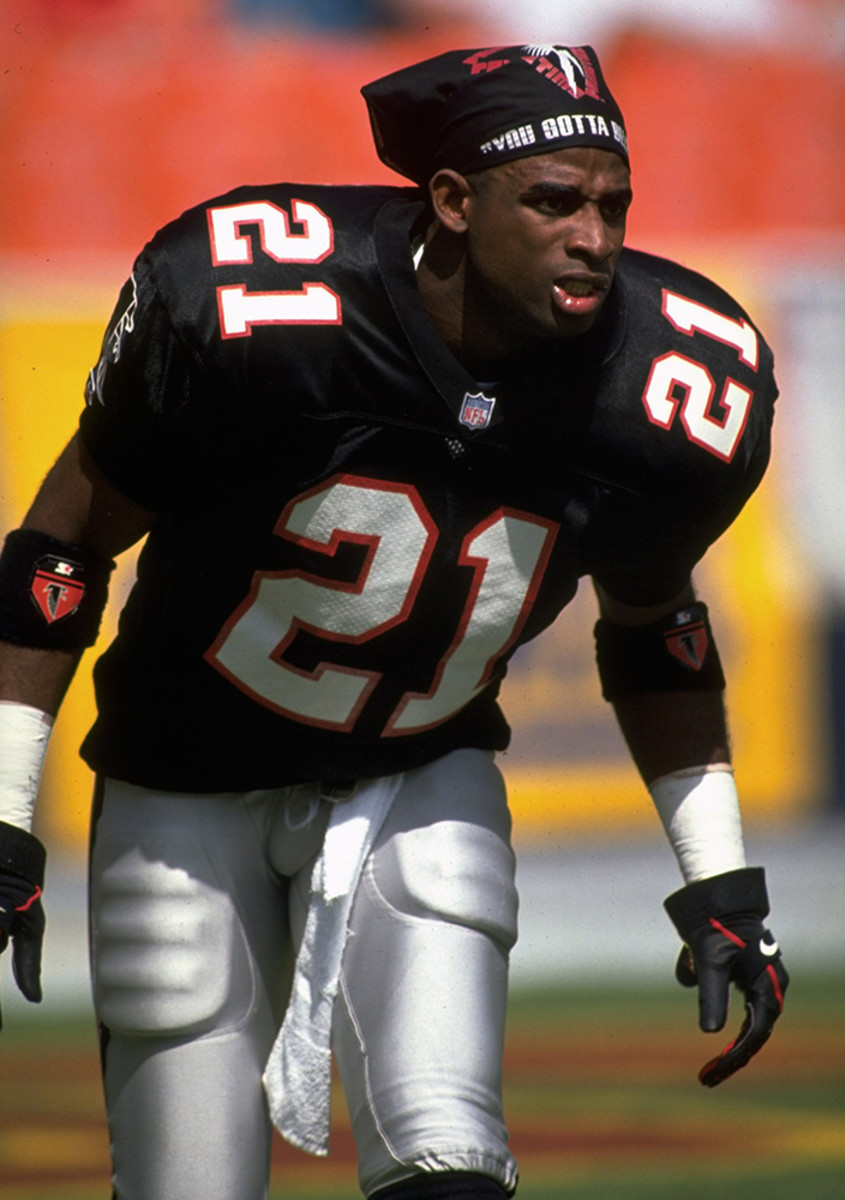
Deion Sanders’ Bandana
Who embodied the NFL in the 1990s better than Deion Sanders? Prime Time caught the self-promotion bug early; as a Florida State senior he showed up to a game against Florida in a tuxedo, via limousine. From the time he arrived in the NFL as a Falcon in 1989 until he left as a Raven in 2005, no player was louder, more talented or more divisive than Sanders.
“Neon Deion” says he gave up the flamboyant bit after a suicide attempt in 1997 and committed his life to religion. He gave hints about his fading taste for the spotlight earlier than that, telling the Associated Press in 1995, “In college, maybe you wanted the glamour and the limelight and all the interviews. But now I’d rather be away from it. Everybody wants exposure and endorsements and making a lot of money, but you can’t leave your hotel room… Once in my life, all this was cool. Now I just like to play the game and go home.”
In addition to the Falcons and Ravens, he played for the 49ers, Cowboys and Redskins, winning two Super Bowls and never spending more than five seasons in the same place. He changed bandana colors at each stop, famously breaking out a black one to tie around his Hall of Fame bust at his induction in 2011.

The AT&T Stadium Video Board
Leave it to Jerry Jones to build something that proves everything really is bigger in Texas.
The $1.3 billion AT&T Stadium, which opened in 2009 as Cowboys Stadium, resembles a palatial spaceship dropped into Arlington, in the middle of the Dallas-Fort Worth metroplex. No feature represents the structure’s grandiosity more than the 160-foot-long HD video board suspended over the center of the playing field. It was Guinness World Record-size at the time of its construction, and though other venues have since unveiled larger ones, the Cowboys owner’s video board remains the most famous. The giant flashing display is part of the show at “Jerry World” and has been struck by punts on occasion.
Bigger, though, isn’t always better. Super Bowl XLV, intended to be the showcase for the Cowboys’ mansion, instead turned calamitous—the incompletion of temporary seating areas left 400 fans without seats, and falling ice outside the stadium injured six people two days before the game. More disappointing for the Cowboys, while the flashy digs have hosted a Super Bowl, they have yet to see an NFC Championship Game.

Joe Namath’s Knee Brace
The white fur coat might have been his most famous accessory, but the knee brace was Broadway Joe’s most important.
The history Joe Namath made for the New York Jets, after all, depended on him playing on those wonky knees. His right knee was already gimpy when he signed his superstar-making $427,000 contract (record-setting money in those days) as the No. 1 pick in the 1965 AFL draft. Just a few weeks later, Jets team orthopedist James Nicholas operated on Namath for the first time, to fix the injury he’d suffered during his senior season at Alabama. Nicholas fashioned a special brace to protect Namath’s knee, with the help of Lenox Hill Hospital’s brace shop, and told the rookie quarterback he might be able to play four years.
Namath went on to play 13 seasons, though his knee problems only got worse—he needed four operations during his time with the Jets (two on each knee) and years later had a double knee replacement. That fourth season, though, did end up being significant: That was 1968, the year Namath made his famous guarantee to upset the Colts in Super Bowl III—still the Jets’ only championship.
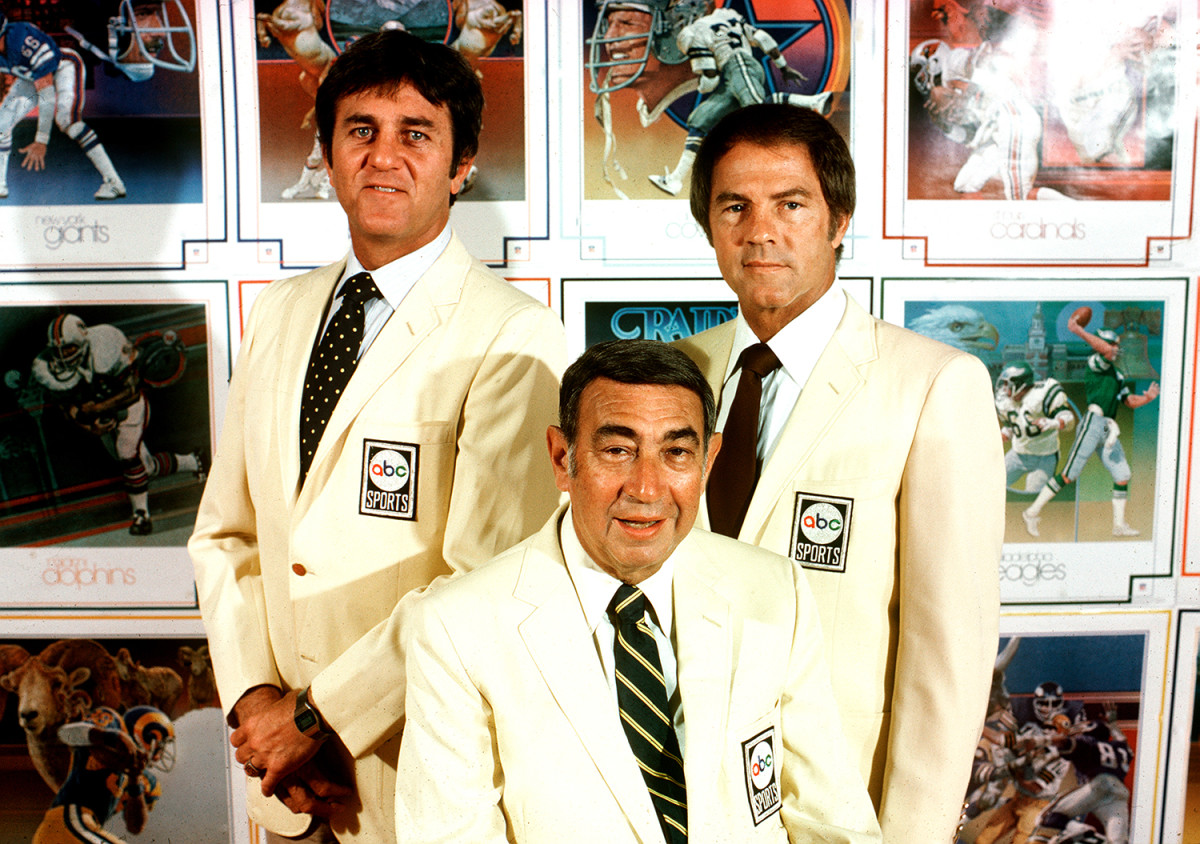
The Monday Night Football Blazers
Looking back on the lunacy that was the beginning of ABC’s Monday Night Football, those garish yellow blazers worn by the broadcasters and pioneered by the Wide World of Sports crew were the least outrageous thing. The day it was played, Monday, was an affront to some—weekday football had yet to be embraced by the public. Three announcers instead of two seemed excessive. And nine cameras instead of four? Sensory overload. ABC Sports president Roone Arledge’s plan: treat Monday Night Football like the Olympics.
We know now it was a pretty good idea. NFL commissioner Pete Rozelle sold a yearlong package beginning in 1970 to Arledge and ABC for $8.5 million, only after Sunday broadcast partners NBC and CBS passed on the unconventional football slot. Those same rights cost ESPN $1.1 billion in 2005. With the 500th broadcast in 2002, Al Michaels and John Madden donned the same canary yellow made famous by ABC’s original crew of Keith Jackson, Howard Cosell and Don Meredith.

The Wonderlic Test
The SAT is to college as the Wonderlic is to … ?
Answer: The NFL, for those brushing up on their analogy skills.
The 50-question, 12-minute test administered at the scouting combine is an entrance exam of sorts for the NFL—even if the scores aren’t publicly released and its impact on the draft is both uncertain and varied. The test was developed in the 1930s by a Northwestern graduate student, E.F. Wonderlic, as a short-term cognitive exam with which companies could screen potential employees. Cowboys coach Tom Landry is credited with introducing it to the NFL in the 1970s, to assess the mental aptitude of prospects. Test-takers answer questions related to math, vocabulary and reasoning, and receive a score between 0 and 50. The link between a player’s score and his career outlook is hotly debated, as are the ethics of teams or individuals leaking players’ results to the media. NFL teams have explored other means of testing a player’s off-field cognitive capabilities, but the Wonderlic is fast and simple—and, like the 40-yard dash, has been a customary part of the pre-draft mystique that builds every spring.
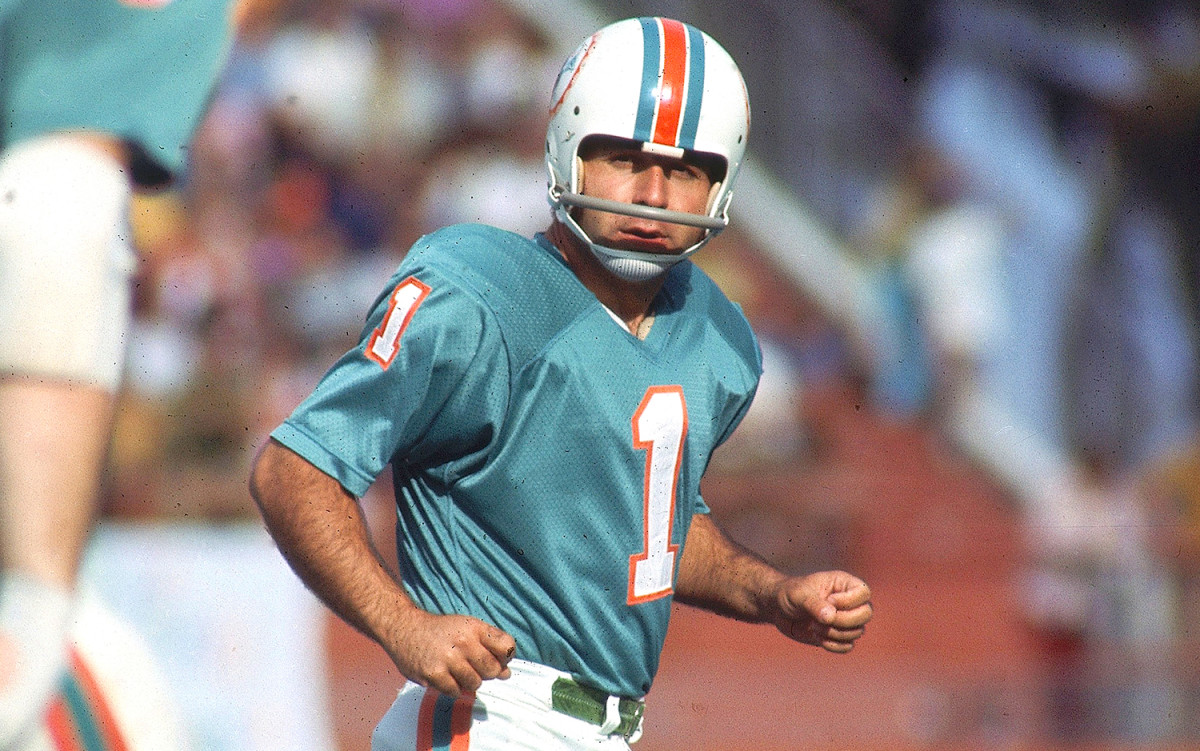
The Single-Bar Face Mask
Wearing full-cage face masks, some players are virtually unrecognizable on a football field. But it didn’t used to be that way.
Into the early 1950s, most players didn’t wear face masks at all, except for a few improvised materials that first appeared as early as the 1920s. The dedicated face mask wasn’t born until Cleveland Browns coach Paul Brown asked equipment manager Leo Murphy to come up with a device that would allow star quarterback Otto Graham to remain in a game in 1953. Graham had suffered a lacerated mouth, and soon after, Brown devised a mask that could be permanently affixed to the helmet.
Other teams adopted the practice and the face mask largely became part of the NFL uniform by 1955. Different species were created, and soon players became recognized by their distinct face wear, from Ernie Stautner’s beak-like model produced by Marietta to Larry Csonka’s nose guard. But some players continued to hold true to the old single-bar, preferring the better sightlines into the 1980s and beyond. Former Redskins quarterback Joe Theismann was the last non-kicker to wear the single bar, up until his retirement in 1985.
The single-bar face mask was officially ruled illegal in 2004, though players who wore it previously were grandfathered in. On Oct. 7, 2007, it made its final appearance on an NFL field when Scott Player of the Browns punted five times in a 34-17 loss to the Patriots at Gillette Stadium. That was the last game for Player, who was the last to wear the single bar. He was released the following training camp by the Patriots and their football history-loving coach, Bill Belichick.
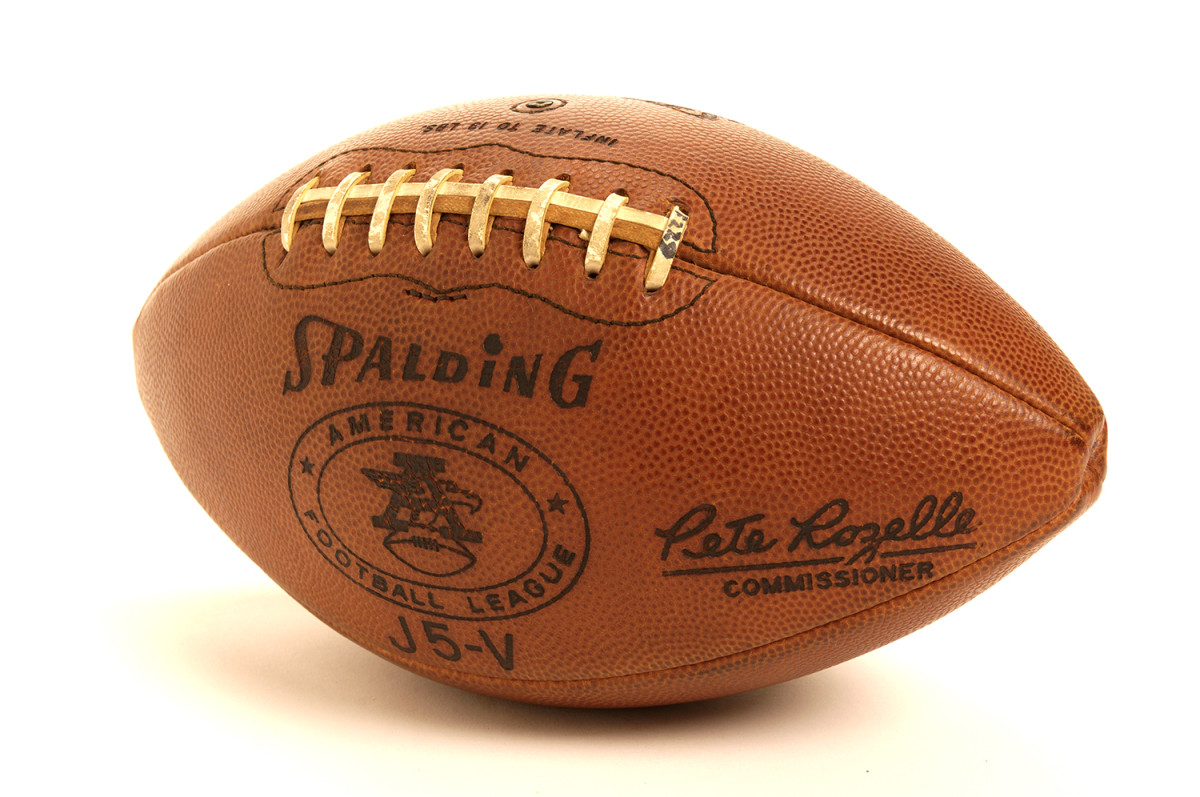
The AFL’s Skinny Football
Beloved by the likes of Len Dawson and George Blanda, the upstart American Football League’s official game ball—the J5-V by Spalding—was only a quarter-inch skinnier and longer than “The Duke” produced by Wilson and used by the NFL, but it represented to players the key difference between the two leagues.
Dawson and Blanda led vertical passing games envied by young AFL fans such as Terry Bradshaw, who, according to Ed Gruver’s historical account The American Football League, cherished his Spalding J5-V Christmas gift from his father as a 9-year-old. The AFL’s early popularity among young people stemmed from the wide-open offensive play, but that had less to do with the ball and more to do with the anti-establishment disposition of the Foolish Club, the adopted nickname of the AFL’s eight owners who eventually merged with the NFL in 1970.
The most significant transformation for the football happened in 1875, when college rules dictated the ball be egg-shaped, for carrying, rather than spherical, as it had been for the first seven years since the College of New Jersey and Rutgers played what is considered the first game in 1869. In 1912 the all-important circumference was defined and reduced to 22 1/2 inches. Still, it took several decades until long-fingered pioneer quarterbacks like Sammy Baugh redefined throwing accuracy. (At his first NFL practice in ’37, Baugh was challenged to hit a Washington receiver in the eye. Baugh asked, “Which eye?”). With the early success of “Slingin Sammy” and a long line of others, the ball grew ever svelter, eventually reaching the 21 1/4 inches mandated by the NFL today.
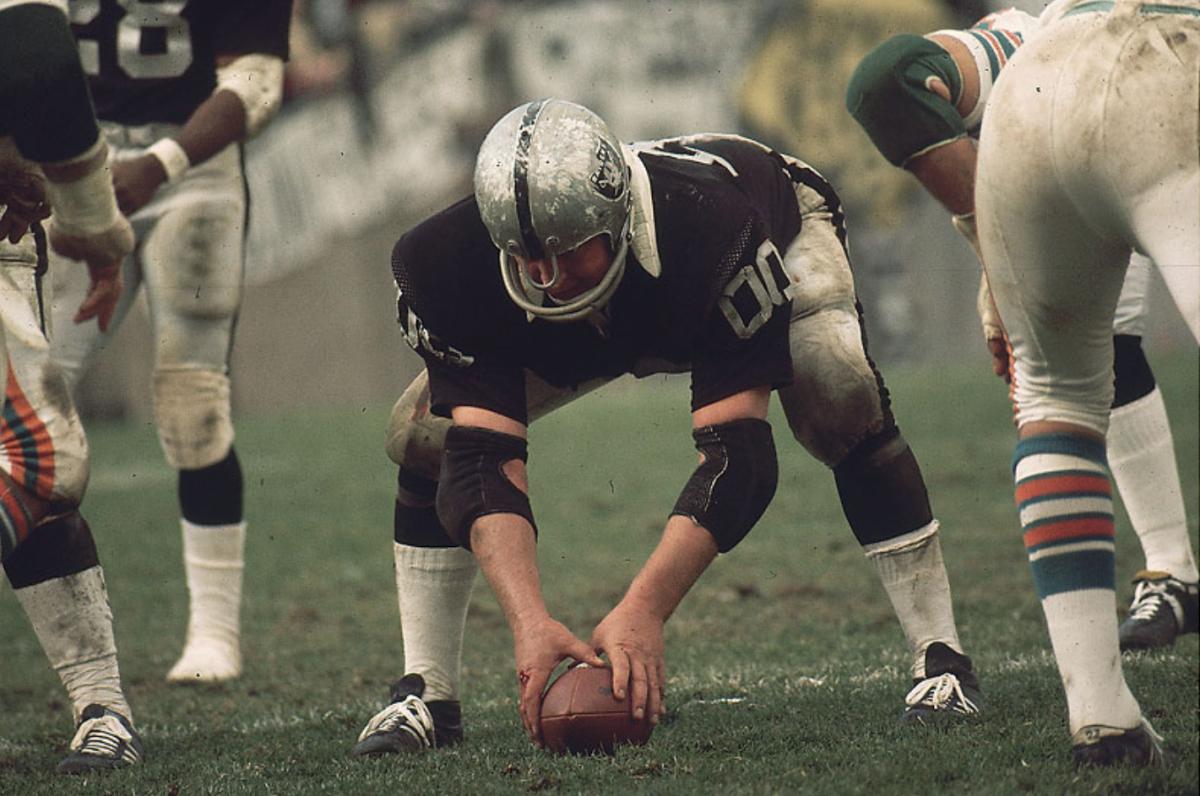
Jim Otto’s Helmet
As the NFL prepared for its 100th season, Oakland Raiders headwear was a hot topic, with receiver Antonio Brown fighting to keep the model he’s worn since entering the league in 2010 but which no longer meets the NFL’s upgraded safety standards. Brown might ask Raiders all-timer Jim Otto whether he’d have sacrificed familiarity for better protection.
Otto, a 10-time All-AFL selection and Pro Football Hall of Famer, played 15 seasons at center for the Raiders, 223 consecutive games’ worth of bashing and banging in the trenches. The man known as Double O “had a massive Prussian head, a perpetual sneer, and dark, menacing eyes,” author Gary Pomerantz wrote. “His nose, broken more than 20 times, curved like the letter ‘S,’ and his wife sometimes rearranged it in the stadium parking lot after games as if it were living room furniture. He wore a size 8 helmet, big as a bucket, largest on the Raiders, a battlefield relic with the signature pirate with an eye patch on its side covered over by a white splotch—the paint scratched off from Otto’s violent collisions with the likes of Curley Culp, Ernie Ladd, Buck Buchanan, Merlin Olsen and Mean Joe Greene.”
The price of all that punishment, inflicted and endured, was steep. “There were so many times that I would walk off the field and my eyes would be crossed,” Otto said in 2012 for Frontline’s League of Denial documentary. “Did you ever have that happen to you? Get hit in the head so hard your eyes were crossed? … Or what about if you had amnesia for two days? When you looked at your wife and you didn't know who she was, like, who’s this chick? And you couldn’t remember.” Otto related one play in which Packers linebacker Ray Nitschke shattered his helmet and facemask, breaking his nose, cheekbone and zygomatic arch and detaching his left retina, leaving Otto blind in one eye for six months. He didn’t even leave the game.
Otto said he suffered more than 20 concussions, no thanks to the rudimentary plastic helmet with sparse foam padding common in his era. And it wasn’t just his head. Double-0 underwent 74 surgeries, including 28 on his knees, as well as multiple joint replacements. In 2007, after several serious bouts with infection related to the surgeries, he had his right leg amputated. “I went to war, and I came out of the battle with what I’ve got,” he told Frontline. “And that’s the way it is.”

Johnny Unitas’s Black High-Tops
The shoes were black high-tops with long spikes and white laces. Johnny Unitas wore them for as long as he was a Baltimore Colt.
Even in the 1970s, when football fields were combed and trimmed like putting greens and even the linemen wore low-cut cleats, Unitas still wore the high-tops. He had to compromise though, in 1973, when the Chargers sported uniform powder-blue low-tops. The team ordered two pair special for Unitas and defensive tackle Dave Costa, who told Sports Illustrated’s Tex Maule he was a member of the “high-top society” chaired by Unitas. Said Johnny with a grin, “Jim Thorpe left me his shoes. They keep my ankles together.”
The high-top was resurrected in the 2013 season in the form of Carolina quarterback Cam Newton’s Under Armour super-high-tops, but it’s Unitas’s legacy of pushing the aerial envelope and putting the NFL on the map that endures more than 40 years after his retirement and 12 years following his death. Back when ground-and-pound offenses lacking modern-day finesse were all the NFL had known, Unitas led Baltimore to victory in the 1958 NFL Championship Game with 314 passing yards and a breathtaking two-minute drill. “You have to gamble or die in this league,” Unitas told Maule in 1959, weeks after the title match that was dubbed “The Greatest Game Ever Played.” “I don’t know if you can call something controlled gambling, but that’s how I look at my play-calling. I’m a little guy, comparatively, that’s why I gamble. It doesn’t give those giants a chance to bury me.”

Music from NFL Films, Vol. 1
On the back windowsill of NFL Films czar Steve Sabol’s office—which was preserved after his passing in 2012—sits a row of binders, many containing memos to his staff. One undated sheet, which features a large cartoon of a gladiator blowing a French horn, is headlined: “We need more inspirational music in our films. Heart-stirrers, pulse pounders!” Pick up a copy of Music From NFL Films, Vol. 1, and you’ll know exactly what Sabol was seeking.
NFL Films, a catalyst in mythologizing pro football, produces more than 1,000 hours of programming per year. Each show presents the sport through the lens of human drama, with its hallmark style of tight, low-angled shots, slow-motion action, exclusive sideline access and poetic prose. Binding it all together is the music. The orchestral sounds of Sam Spence evoke images of troops preparing for battle, spaghetti Westerns or grand literary romances. But if you close your eyes and listen to tracks such as “Gut Pride” or the up-tempo, jazzy “Ramblin’ Man from Gramblin’,” you might also see a football field.
Combined with booming narration from John Facenda (many of his scripts penned by Sabol), this soundtrack reveals how Americans began to appreciate football not only as a game of X’s and O’s but as a stage for human struggle and success. The tracks are heart-stirring, pulse-pounding and everything we have come to love about the sport.
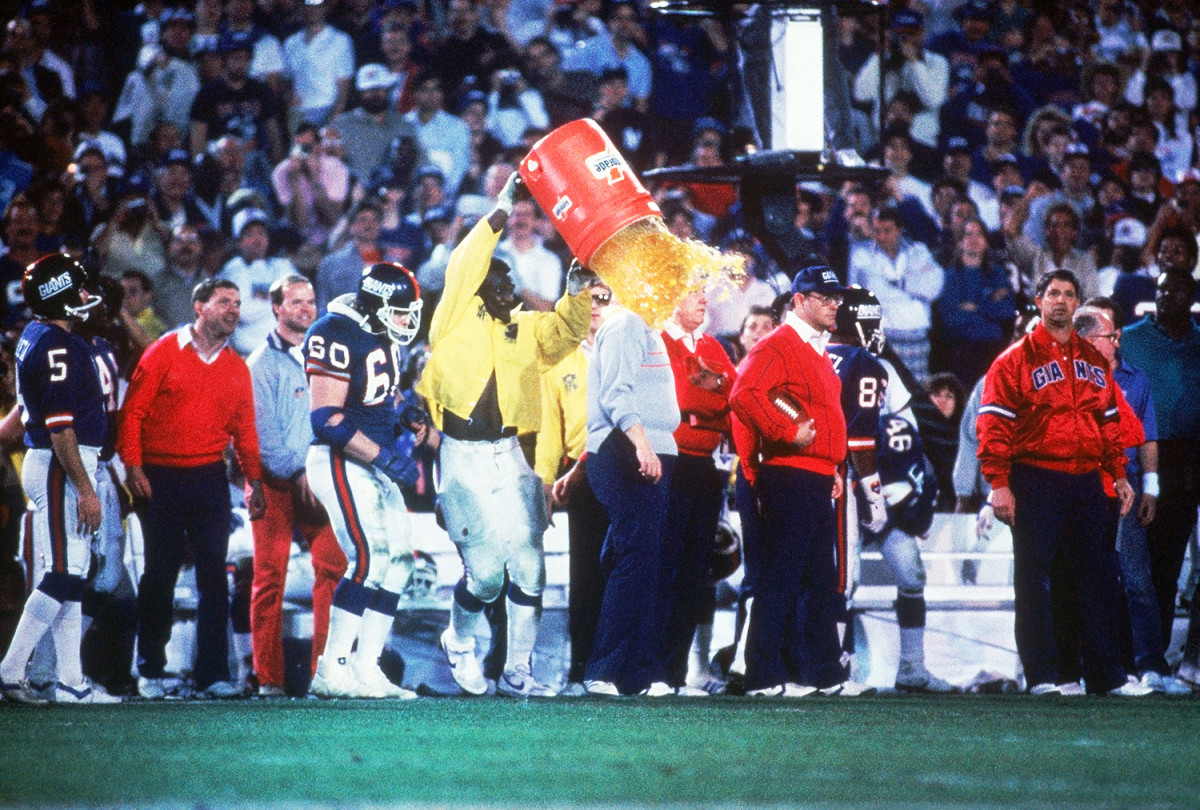
The Gatorade Bucket
There’s some dispute as to whether the Gatorade dunk started with the Bears in 1984 or the Giants in ’85, though it’s clear the Giants were most responsible for the tradition that stands today.
Teammates Jim Burt and Harry Carson turned the Gatorade bath of coach Bill Parcells into a special form of celebration on New York’s road to Super Bowl XXI. Parcells’ bonhomie in the matter didn’t hurt. When the season was over, the Giants having defeated Denver in Super Bowl XXI, Gatorade thanked Carson and Parcells for all the free publicity with $120,000 for the coach over three seasons and $20,000 to put Carson on a Gatorade poster, according to Darren Rovell in his 2005 book First in Thirst: How Gatorade Turned the Science of Sweat Into a Cultural Phenomenon.
“It’s really remarkable that people haven’t found anything else to do,” Rovell told the Washington Post in 2012. “The bullpen car is gone in baseball. Or how many people are really putting on eye black? Sports traditions don’t really last anymore.”

Mike Ditka’s Cigar
They don’t build ’em like the ‘85 Bears anymore. That started at the top with coach Mike Ditka, the gruff former NFL tight end whose penchant for cigars rubbed off on his team.
Ditka was beloved in the Windy City after a playing career that included Chicago’s NFL championship in 1963. He returned in ’82 as the Bears’ coach and made good on his promise to bring the team another title in short order. Ditka’s feud with defensive coordinator Buddy Ryan was as famous as Ryan’s 46 defense, but that simply added to the personality of a team that was cocky and fun-loving.
Ditka was often seen lighting up a cigar, and they were passed out in the locker room after the Bears blanked the Rams 24–0 in the NFC Championship Game. Chicago’s 46–10 demolition of the Patriots in Super Bowl XX two weeks later called for an even bigger celebration: cigars and champagne for one of the greatest teams of all time.
Though Ditka worship was at first limited to Chicagoland, his godhood went national with Saturday Night Live’s now legendary ”Superfans” skits—the cigar featured prominently, as did the trademark Ditka ’stache, the aviator shades and mounds of sausage. More than two decades after it first aired, the bratwurst-loving, Ditka-philic Superfans was resurrected in a series State Farm commercials. Talk about a legacy.
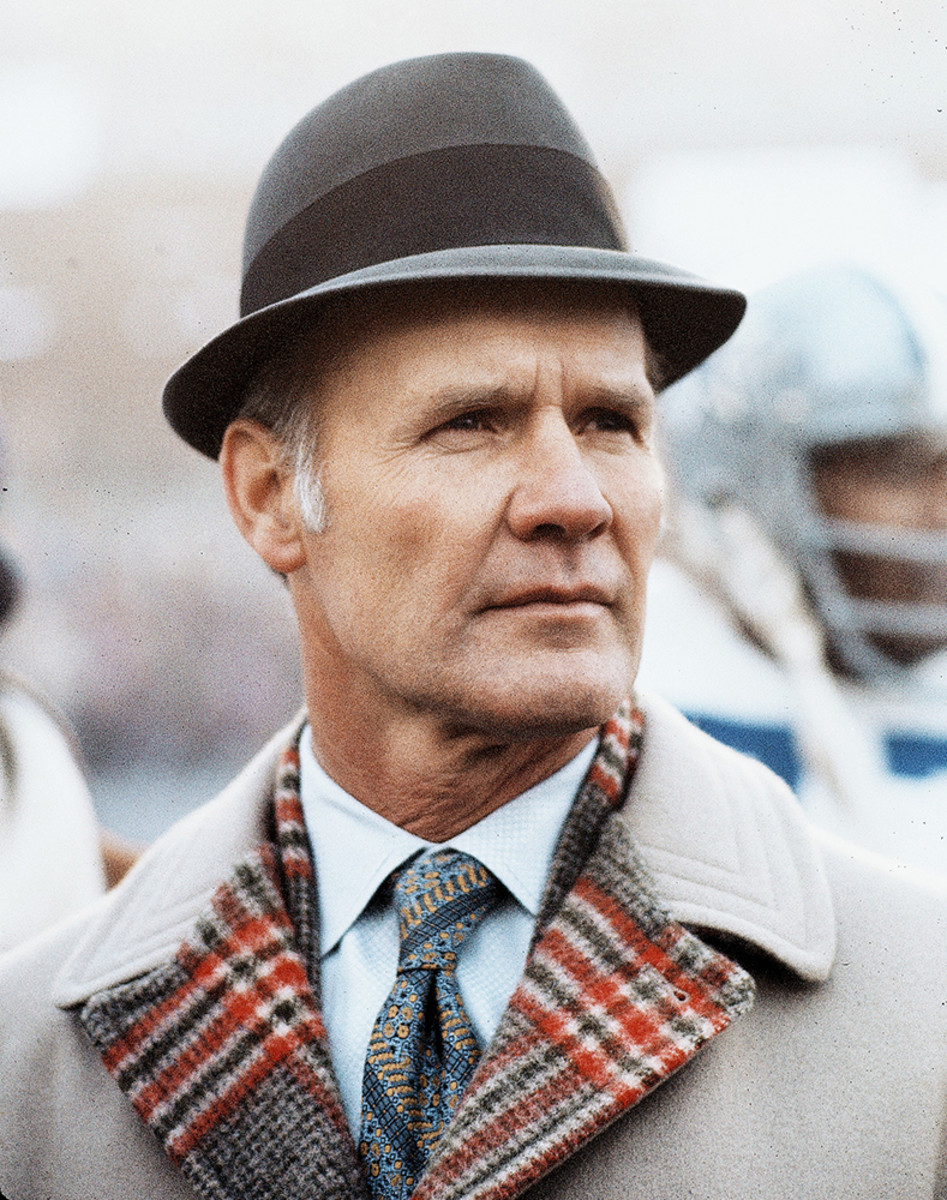
Tom Landry’s Fedora
Tom Landry always wore his Sunday best on the sidelines: suit, tie and his famous fedora. It was fitting for a man who always expected the Sunday best from his team.
The native of Mission, Texas, coached the Cowboys for 29 seasons. Under Landry’s watch, Dallas had a winning record in 20 straight years, from 1966 to 1985—a feat no other club has matched—and made five trips to the Super Bowl, winning twice. Landry won because he innovated, developing the “flex” variant of the 4-3 defense and popularizing the shotgun formation, allowing him to go toe-to-toe with contemporaries like Vince Lombardi and Don Shula. In fact, Shula, one of only three NFL coaches with more career wins than Landry’s 250 (George Halas and Bill Belichick are the others), considered Landry’s Cowboys to be the toughest foe he faced.
Landry played pro football in New York (with the Yankees and Giants) and began his coaching career there, too, as the Giants’ defensive coordinator in the late 1950s. But he returned to his home state in 1960 to make a star of the Cowboys. A Stetson would have been the obvious choice of headwear, but his fedora matched his memorably stoic demeanor. It was an unusual style, but it worked.

A Hy-Vee Shopping Bag
Before Kurt Warner caught on with the Rams, sparking a storied pro career that included two league MVP awards and a Super Bowl title, it was all nearly derailed by a spider. We all know the story of Warner bagging groceries and stocking shelves at a Hy-Vee in Cedar Falls, Iowa, before catching his big break. But did you know an arachnid’s bite interrupted plans for an NFL tryout a year earlier?
After two seasons with the Arena League’s Iowa Barnstormers, Warner earned a shot with the Chicago Bears but couldn’t attend the tryout after suffering a spider bite on his honeymoon. The Bears went another way, and the Rams came calling a year later. (Efforts to locate the spider were unsuccessful, so we went with the grocery bag.) Warner took the Rams to two Super Bowls, and bagged another Big Game trip with the Cardinals.
Warner is far from the only NFL great with a bizarre how-I-made-it story: Colts legend Johnny Unitas famously hitchhiked back to Pittsburgh from Steelers training camp, opting to save the bus fare the Steelers forked over after cutting him. He played semi-pro ball for $6 a game before getting his shot with Baltimore. The humble Warner can certainly relate.
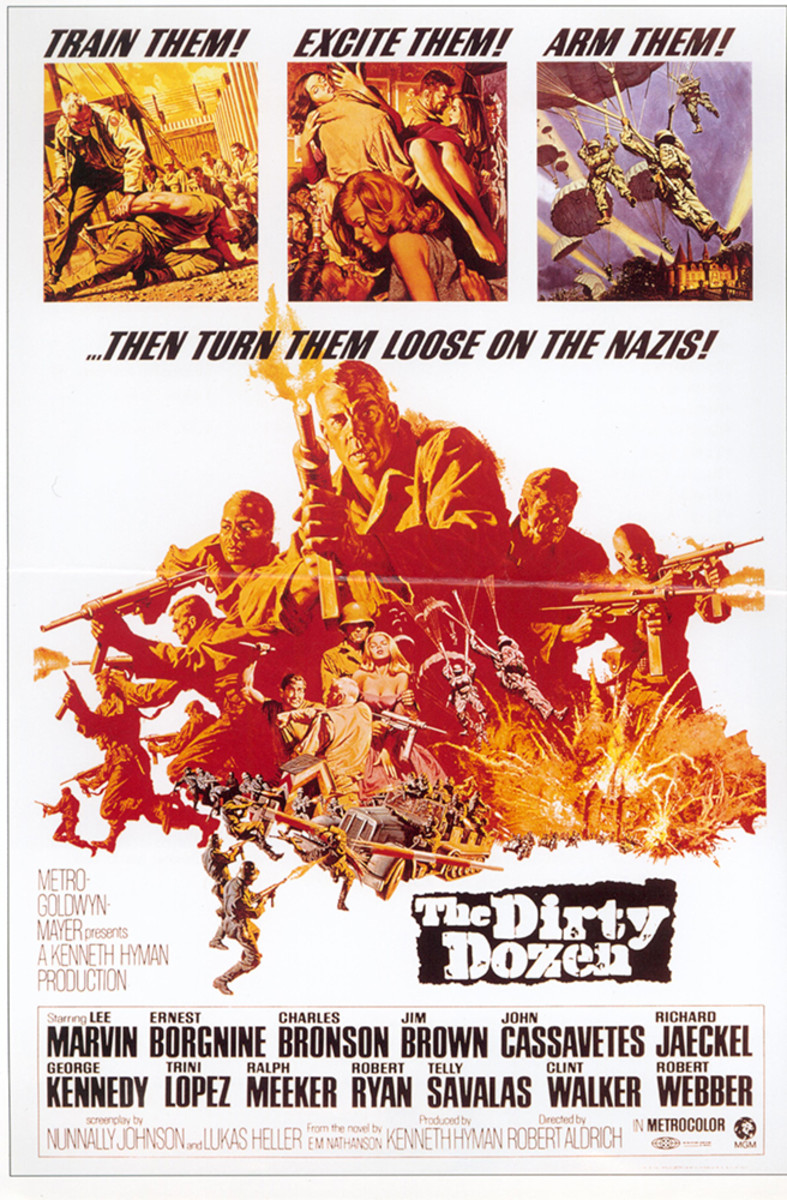
“The Dirty Dozen” Movie Poster
JIM BROWN QUITS FOOTBALL FOR THE MOVIES
The Associated Press headline wasn’t exactly true. Jim Brown quit football at 30 years old for Jim Brown, as he would later tell it. For starters he was bored, just a few months after winning the league’s MVP award for 1965. “I wanted more mental stimulation than I would have had playing football,” he said on July 13, 1966, the day of his retirement. And Brown, then the NFL’s all-time leading rusher, didn’t want to fade away in the manner of a Joe Louis or, later, a Muhammad Ali. “People had sympathy for them,” Brown would say in coming years, “and you should never have sympathy for a champion.”
And yes, he wanted to be a movie star. The Dirty Dozen, a World War II action film about a group of Army convicts who are turned into an elite commando unit for a suicide mission, set him on the right path: Brown filled director Robert Aldrich’s vision for the first militant black hero in an action film. As modern-day movie critic Gary Susman notes, before Brown’s Robert Jefferson role, audience-friendly black characters typically turned the other cheek. Jefferson, on the other hand, slugged a character who called him a “n-----.”
Dirty Dozen co-star Ernest Borgnine wrote years later that Aldrich was urged by MGM execs to drop Brown’s death scene, in which he is gunned down after laying waste to a chateau full of German officers. The film would win an Oscar, they told Aldrich, if he cut it. He refused, and the scene upset audiences across the nation. In that way, Aldrich’s film seemed to mimic Brown’s unpopular and unexpected choice to leave football after nine brilliant seasons. Dozen character Samson Posey, played by Clint Walker, may have said it best: “I reckon the folks’d be a sight happier if I died like a soldier. Can’t say I would.”

A Bottle of Toradol
The drug comes in pill form, but inject 30 to 60 mg into the butt and it will act even faster. Regular use could lead to gastrointestinal bleeding and kidney damage. Ketorolac Tromethamine (better known as Toradol) may sound dangerous, and it very well might be. But after being approved by the FDA in 1989, it became the NFL’s go-to wonder drug, an amped-up Aleve that numbs the pain—even if the pain doesn’t exist yet. As former Bears linebacker Brian Urlacher famously told HBO’s Real Sports in 2012: “It’s normal. You drop your pants, you get the alcohol [swab], they give you a shot, put the Band-Aid on and you go out and play.”
In a violent sport that lauds toughness, pain management has always been a complex issue. That’s why Toradol’s prevalence isn’t surprising. While the non-narcotic is not physically addictive, some doctors have raised questions about its long-term effects, especially when served with a cocktail of other drugs. Whether players are properly clued in on that is murky as well as a springboard for several lawsuits. Although some teams shy away from Toradol and other powerful painkillers, the ritual of players lining up for a pregame syringe has been commonplace for decades. Its full impact is still cloaked, for now.

The Astrodome Roof
Here sits the first domed stadium, gutted and unused but preserved—for now. Unique in every conceivable way, from luxury boxes decorated like living rooms to a $2 million scoreboard, the Astrodome opened in 1965 with an exhibition game between baseball’s Yankees and the Astros (formerly the Colt .45s, rechristened that year) watched by President Johnson and his wife, Ladybird, from the owner’s skybox. The “Eighth Wonder of the World” became home to the Oilers in 1968 and served both teams into the late ’90s, when the football team left for Tennessee and the baseball team into a new park.
When the NFL came knocking again with a new team in Houston the early 2000s, a retractable roof stadium went up right next to the old Astrodome. While the Astrodome has mostly sat idle for more than a decade and its future is unclear—it is listed on the National Register of Historic Places and is a Texas antiques landmark, but recent plans to turn it into a parking garage and multi-use venue hit a snag over cost—its legacy permeates the NFL. The Astrodome gave us Astroturf, guarded the field from the elements and introduced a new way to play football: fast, fast, fast. How would Warren Moon’s run-and-shoot Oilers have fared on natural grass chewed up by a season of football in the heat of Houston? Would the Greatest Show on Turf, the Kurt Warner-led Rams, have reached those unprecedented heights if not for the Edward Jones Dome, one of the Astrodome’s many progeny? Would Randy Moss have been great on the frozen tundra of old Met Stadium in Minnesota, or did the fast track of the Metrodome help him in December when it was 72 degrees inside instead of 2 degrees outside?
Traditionalists will argue that domes deprive us of the very conditions—ice, snow, fog, mud—that have given the game some of its most memorable moments. Whether that’s good or bad might depend on how you feel about watching football in sub-zero wind chill or sweltering humidity, versus the cool comfort of climate control.

The Colts’ Mayflower Trucks
Late Baltimore Sun photographer Lloyd Pearson, a travel nut who guessed he’d crossed the U.S. 73 times in 25 cars and was engaged to his sweetheart within weeks of meeting her after their WWII pen-palling, caught perhaps the most iconic photo of a team leaving behind a city in American sports history.
Early during the morning of March 28, 1984, with Phoenix representatives turning away Bob Irsay and his Colts and the Maryland state legislature on the verge of giving Baltimore eminent domain over the team, Irsay and Indianapolis mayor William Hudnut pulled the trigger on a move that would shake up the NFL and help shape its future: The Colts were headed to Indy. Mayflower, the trucking company chaired by Hudnut’s friend and neighbor, offered to do the move for free, enlisting a stable of Sigma Chi brothers from the University of Maryland to pull off the secret midnight escape. Word got around Baltimore, and Pearson, who died in 2012 at age 90, was dispatched to team headquarters in Owings Mills to capture a scene that would play out several more times in the league’s modern era, but never under such clandestine circumstances.
Wrote former Sun editor Ernest Imhoff of the picture Pearson snapped through the snowflakes: “This single photograph made owner Irsay the devil for many Baltimore fans and the hero of Indianapolis.”

The Madden Cruiser
CBS once rented Dolly Parton’s tour bus for John Madden, as a solution for his famous fear of flying. Soon after that he got his own vehicle, and The Madden Cruiser became an icon in itself. The custom bus debuted in the 1980s and logged 80,000 miles annually, transporting Madden to his broadcast gigs across the country.
It had all the essentials: a bed, a stocked refrigerator and a mobile office where Madden broke down film or got his coaching buddies on the horn. Madden already had plenty on his résumé when he became a broadcaster: During 10 seasons as the head coach of the Oakland Raiders, he won Super Bowl XI and was the youngest coach to reach 100 wins. But he earned the affection of fans nationwide in his second career, as a color commentator for all four major TV networks, with his coach’s eye and endearing Maddenisms—Boom! Doink!
Madden retired from broadcasting in 2009, after three decades, though his name is entrenched in American pop culture through the best-selling EA Sports video game that bears his name. And the Madden Cruiser remains a fond memory: Quirky and wildly popular, just like the man it carried.
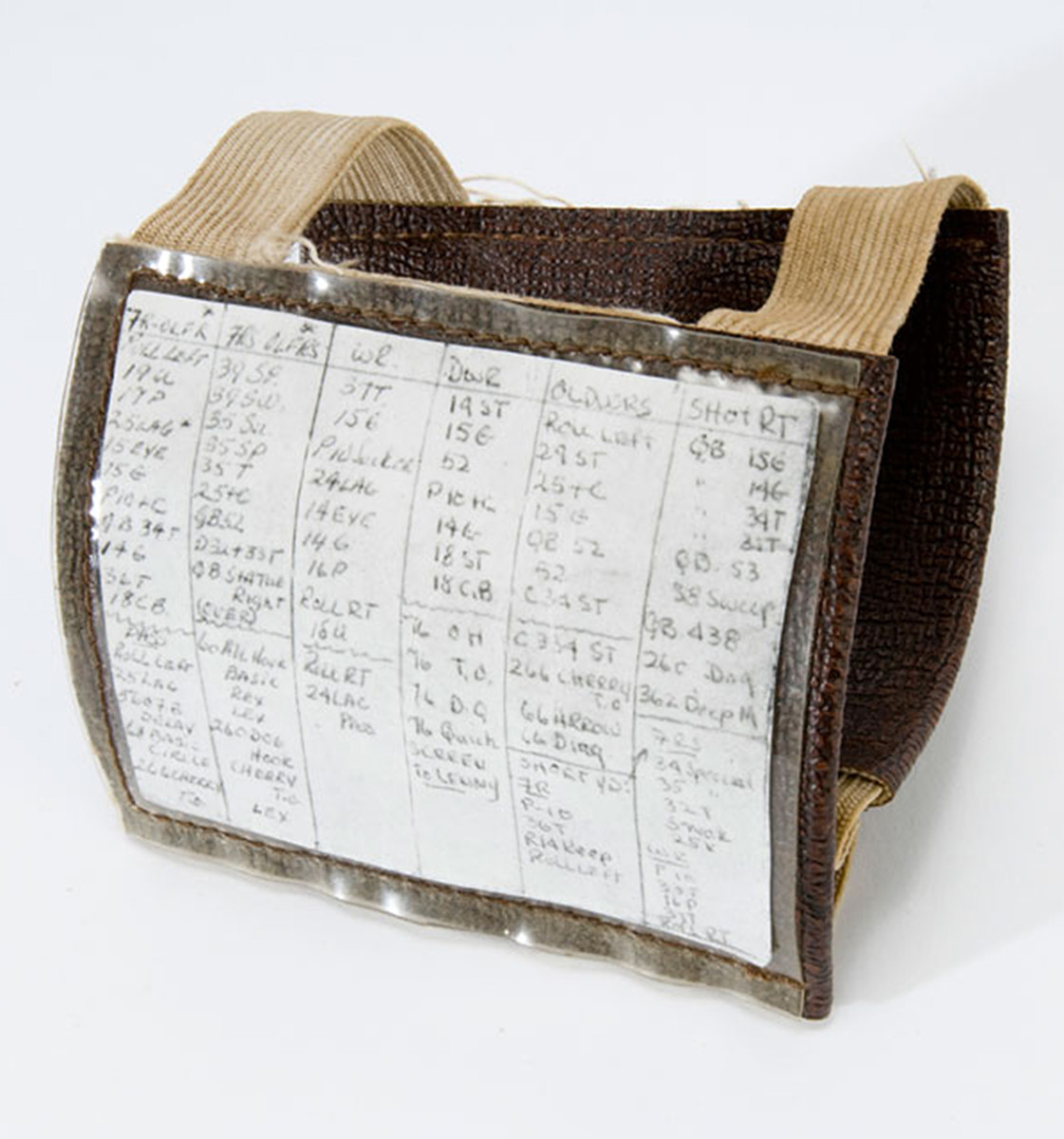
Tom Matte’s Playbook Wristband
Part of Don Shula’s success was adapting to each quarterback he coached—including the running back he was forced to play at quarterback.
Shula’s 1965 Baltimore Colts improbably lost both starting quarterback Johnny Unitas and back-up Gary Cuozzo right before the climax of their season. For the regular-season finale, and the Western Conference playoff, Shula turned to a running back who had never been a signal-caller in the pros: Tom Matte. Scrambling, Shula simplified the offense and gave Matte a makeshift plastic wristband with the Colts’ plays scrawled on a card underneath. Matte would have led his team to the NFL Championship Game that season were it not for a controversial fourth-quarter field goal by the Green Bay Packers—it appeared to sail wide of the upright—that gave Vince Lombardi’s squad the opportunity to win the conference playoff in overtime.
Matte returned to his preferred position of running back for the rest of his 12-year career, but in his brief three-game stint as an NFL quarterback, he turned out to be a trailblazer. The wristband, a novelty when Matte wore it, is commonplace among full-time quarterbacks today.

The White Football
Long before playing under the lights was considered prime time, it was an oddity that called for a most unusual piece of equipment. The Providence Steam Roller’s meeting with the Chicago Cardinals on Nov. 6, 1929, was the first NFL game played at night, and the teams used a white ball in case of foundering floodlights.
The white football—which a local newspaper compared to a large egg seeming apt to crack each time it was passed through the air—actually outlasted the Steam Roller franchise, being used well into the 1950s. It was showcased by Otto Graham and the Cleveland Browns on the evening of Sept. 16, 1950, when they made a roaring entrance into the NFL by stunning the defending champion Philadelphia Eagles; it even snuck onto a few football trading cards of that era.
But there were drawbacks: Players complained that it was slippery and hard to distinguish from white uniforms. By 1956, the white football was extinct in the NFL, rendered needless by high-watt floodlights and TV lighting requirements—a shame, if only for the fact that it could have been a star during the power outage of Super Bowl XLVII.

Dallas Cowboys Cheerleaders Uniform
So established are the Dallas Cowboys cheerleaders that even Jerry Jones couldn’t ruin them. Longtime Cowboys fans may remember a four-day offseason spat in June 1989 in which 14 cheerleaders quit when informed of new owner Jones’s plans to trim the cheerleaders’ uniforms and relax policies against fraternizing with team employees and promoting alcohol. The public outcry that ensued forced Jones to back off any changes to ex-general manager Tex Schramm’s brainchild.
In 1972, Schramm, the man who put the star on the Cowboys’ helmets, scrapped the high school boys and girls who cheered games in sweaters and long skirts and pants in favor of a handpicked dance team dressed in high-cut shorts and bare midriffs. They were going for a sexy-but-wholesome aesthetic, hiring young professionals and governing them with strict rules. The uniforms and the rules would remain largely the same, with the rest of the NFL taking note and modeling their cheerleaders after Schramm’s.
The team faced criticism from feminists who noted the most prominent females in pro football were scantily-clad side acts. But America embraced the new look, and the Cowboys cheerleaders became a cultural phenomenon—with their own posters, calendars, Making of . . . shows and even a full-length 1979 made-for-TV movie starring Bert Convy and Lauren (Love Boat) Tewes.
For better or worse, the cheerleading tradition has persevered in the NFL. As of 2019, 26 six teams had official squads—only the Bills, Bears, Browns, Giants, Packers and Steelers did not. In Buffalo, the team suspended operations of the Jills in 2014 after five cheerleaders filed a lawsuit over compensation and what the plaintiffs called degrading treatment. Several other teams, including the Raiders, Texans and Saints, have faced similar suits in recent years. Is the future of cheerleading in doubt? Hard to say—in 2016 the Lions, who hadn’t had official cheerleaders since 1974, added a squad.

Tau Protein
It’s not something the naked eye can see, and until recently it wasn’t detectable outside an autopsy room. Frankly, few of us know much about it. But the more scientists learn and tell us about the abnormal protein called tau—which can build up to cause Chronic Traumatic Encephalopathy (CTE), a deterioration of the brain—the more we realize that although microscopic, it could be one of the most important factors in the future of football.
Scientists at Boston University, notably Dr. Ann McKee, have been at the forefront of research into the relationship between CTE and sports. Their 2009 paper presented evidence of tau’s role in reducing neurological and cognitive function in football players and other athletes who suffer repetitive brain trauma. McKee’s team studied the brains of deceased former athletes who suffered cognitive impairment and discovered significant tau buildup in a majority of them.
Among the deceased players whose brains have been shown to have signs of CTE are Hall of Famers Mike Webster and Junior Seau, and living players including Tony Dorsett have been told they have the condition. CTE has been linked to memory loss, depression, and eventually, progressive dementia. As scientists explore these connections and delve into ways to can identify, treat and, ideally, prevent CTE, the football world has been forced to readjust long-embedded attitudes towards head injuries. We have already seen changes with rules, equipment and medical policies. Will truths about tau tell certain individuals they cannot play the sport? It’s daunting to imagine what a future NFL landscape might look like—it’s not something most of us can visualize, at least not yet.

The Super Bowl Ring
Franchises play for and receive the Vince Lombardi Trophy for winning football’s ultimate prize: a Super Bowl title. But since only one trophy is given to each champion, rings are given out to the players, coaches and other staff members. After the 1966 season, Lombardi himself designed the very first one with Jostens, which has created most of the Super Bowl rings. The first had just one diamond, was made of gold and was valued at $750. Inscribed on the inside were three important words to Lombardi’s Packers: harmony, courage and valor.
The NFL pays a small portion toward the creation of 150 rings; the rest of the bill is footed by the club. And sometimes the ring captures more than just abstract notions. After Super Bowl LI, in which the Patriots came back from a 28-3 deficit against Atlanta to win in overtime, the team created rings with 283 diamonds, “to tell the story of the game,” according to a Patriots spokesman Stacy James. That didn’t sit well with Falcons owner Arthur Blank, who confronted Robert Kraft about the bling. “It pissed me off,” Blank said.

The Hupmobile
Ralph Hay was a successful automobile dealer, but his showroom’s place in history far exceeds that of the Hupmobiles he sold. Pro football had existed since 1892 but lacked any real order during its first three decades. A pair of meetings in August and September 1920, in Hay’s showroom in Canton, Ohio, changed that: The American Professional Football Association, renamed the NFL two years later, was organized.
As the story goes, the founding fathers—including Hay, owner of the Canton Bulldogs, and George Halas, representing the Decatur Staleys—sat on the cars’ running boards and drank buckets of beer while devising the league that would become the crown jewel of American sports. Jim Thorpe was elected president, a $100 membership fee was set, and play began within a few weeks. Fourteen teams played that first season, only two of which still exist today: the Staleys, now the Chicago Bears, and the Chicago Cardinals, now in Arizona.
Hay’s Hupmobile showroom has long since been torn down, but at the site in downtown Canton (now the Frank T. Bow Federal Building) you can find a plaque identifying the hallowed ground as the birthplace of the NFL.
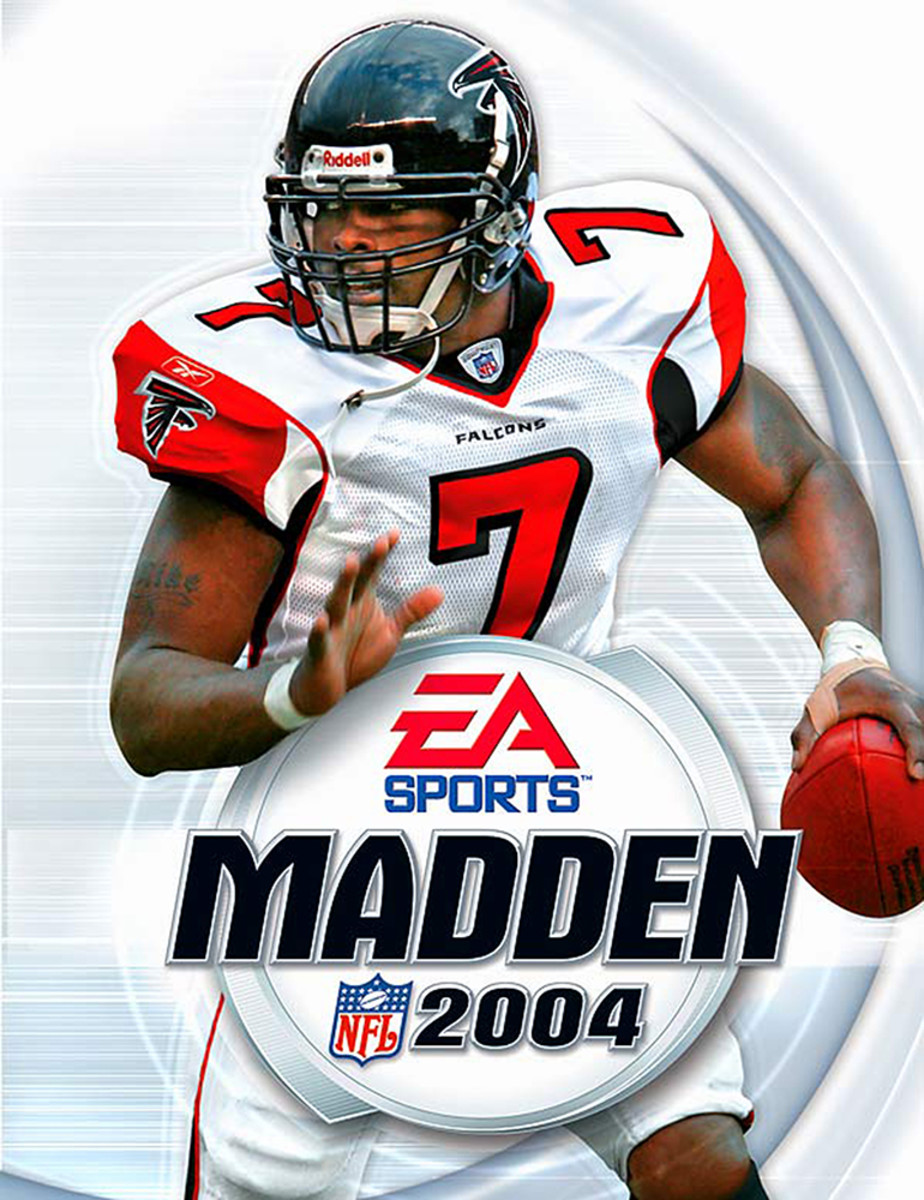
The Madden Video Game
The Madden football franchise, now more than three decades old, almost wasn’t Madden at all.
When the game that would be called Madden was taking shape under EA Sports in the late 1980s for use on the Apple II home computer, EA founder Trip Hawkins saw the former Oakland Raiders coach, broadcaster and robust pitchman as a third choice. The top pick was 49ers quarterback Joe Montana, at the height of his powers at the time and Hawkins’ boyhood idol growing up in Southern California. But Montana already had a deal with another video game maker, Atari. The second choice, Cal football coach Joe Kapp, wanted royalties on the title. So Hawkins went with Madden, and both were in for a crash course; Madden in the power and promise of technology and Hawkins in the game of football.
Madden insisted that if he was putting his name on it the game had to be 11-on-11, a major challenge considering the lack of computing power in late ’80s. As gaming consoles evolved Madden grew more realistic through the ’90s, with NFL teams and logos, and later player names (with the NFLPA’s blessing) becoming part of the game. With realistic playbooks and real-time roster updates, gamers playing current versions can feel like they’re a hoodie away from being the next Bill Belichick.
Through a partnership with the NFL, the franchise eventually brought an intersection of jock culture and gaming, no small feat in the pop-culture climate of the early ’90s. Today, each new version of Madden is unveiled to massive publicity and invariably sells a million copies in its first week on the shelves.

The White Ford Bronco
O.J. Simpson won the 1968 Heisman Trophy, became the first NFL player to rush for more than 2,000 yards in a season (during a 14-game slate in 1973 no less), starred alongside Arnold Palmer in commercials for Hertz, worked on Monday Night Football with Frank Gifford and Howard Cosell and appeared in Roots, The Towering Inferno and the Naked Gun movies. Today he may be the most notorious former athlete in America.
The Hall of Fame running back is now best known for the circumstances surrounding the deaths of his ex-wife, Nicole, and Ronald Goldman in June 1994. Charged with double murder in the case and given the chance to surrender to police on June 17, Simpson instead engaged in a “low-speed chase” with police along the freeways of L.A., in a white Ford Bronco owned and driven by former teammate Al Cowlings—a pursuit that was broadcast live on all three networks and on CNN, interrupting the NBA Finals on NBC. An estimated 95 million views watched the drama unfold. Simpson finally turned himself in later that evening, after reaching his house in Brentwood.
In a criminal case that dragged out for more than a year and that made household names of Johnnie Cochran and Kato Kaelin, introduced America to the Kardashians and brought the phrase “If it doesn’t fit, you must acquit” into the lexicon, Simpson was eventually found not guilty. However, he subsequently lost a wrongful death civil suit brought by the Goldmans and was ordered to pay $33 million. He later served nearly nine years in a Nevada state prison for felony armed robbery and kidnapping, after he tried to steal sports memorabilia at gunpoint that he said belonged to him. The mementos included his Hall of Fame certificate. The Bronco? Simpson’s former agent bought it from Cowlings for $75,000 and kept it in a garage for years, charging the battery every now and then to keep it running. It appeared on a 2017 episode of Pawn Stars and is now on display at the Alcatraz East Crime Museum in Tennessee.

The 1933 Rule Book
The rules have allowed the forward pass in the professional game since 1906. George “Peggy” Parratt of the Massillon (Ohio) Tigers is believed to be the first player to complete a pass in a pro game, with Dan “Bullet” Riley on the receiving end, against Benwood-Moundsville (W.Va.) on Oct. 25 of that year.
But it was hardly ever used because of stiff penalties for incomplete or illegally thrown passes. For instance, the passer had to be five yards behind the line of scrimmage, and the penalty for failing to do so was a turnover, whether the pass was complete or not. A controversy bubbled up in the 1932 championship game between the Chicago Bears and Portsmouth Spartans when Bears fullback Bronko Nagurski faked a run and then threw a touchdown to Red Grange. The Spartans protested that Nagurski wasn’t five yards behind the line of scrimmage. The play stood, and the Bears later won 9–0.
At the league meetings after the season, Spartans coach George “Potsy” Clark asked for a rule change to legalize any pass thrown from behind the line of scrimmage. The move, which would transform football and lead to the aerial show we see today, wasn’t meant to further the pro game, which had adopted the college rules to that point. It was because, Clark argued, “Nagurski would do it anyway!”

Ryan Leaf’s Colts Jersey
Here’s all you need to know about how inexact the science of drafting can be: In February 2013, the first overall pick in the 1998 draft, Peyton Manning, was playing for his second team in his third Super Bowl at the end of his fifth MVP season, in which he earned a $25 million salary.
The second overall pick from ’98, Ryan Leaf, was in a Montana prison, having flamed out of the NFL after five seasons. He was arrested twice in two days in 2012 and sentenced to five years on felony drug and burglary charges. During the sentencing, Leaf told the judge, “I’m lazy and dishonest and selfish. These were behaviors I had before my addiction kicked in.”
In Leigh Steinberg’s book The Agent: My 40-Year Career Making Deals and Changing the Game, Leaf’s representative revealed that the Washington State QB intentionally skipped his pre-draft meeting with the Colts in order to avoid being taken No. 1, leaving Indy and San Diego fans alike to wonder what might have been had the 1998 draft gone down differently. For one, the No. 16 Colts jersey pictured above would have been awarded to Leaf had Indianapolis called his name first at Madison Square Garden during the 1998 draft. Signed by Leaf, it hangs on the set of the Dan Patrick Show in Connecticut. Manning’s blue No. was 18 retired by the Colts in 2017 and hangs from the rafters in Indianapolis.

Tom Dempsey’s Boot
They called him Stumpy. Born without a right hand or toes on his right foot, Tom Dempsey had seemingly no future in professional sports. Yet on November 8, 1970, Dempsey kicked a 63-yard field goal—setting an NFL record that endured for 43 years—not in spite of his clubbed foot, but rather because of it.
Dempsey began his kicking career barefoot, simply wrapping athletic tape around the end of his right foot. Sid Gillman signed him to his Chargers taxi squad in 1968, and the coach helped develop a better tool for kicking. Dempsey’s new shoe was a $200 custom leather boot that featured a 1¾-inch leather block at the toe; it resembled (and struck like) a sledgehammer. Fast-forward two years and one team later, to Week 8 in 1970, as Dempsey and the 1-5-1 New Orleans Saints hosted the heavily favored Lions at Tulane Stadium. With the Saints down 17–16 and two seconds remaining, Dempsey took the field for what was considered an impossible attempt. It wasn’t. His 63-yard bullet snuck over the crossbar, winning the game and upping the ante for kickers—the previous record was 56 yards, set in 1953.
Stumpy became an enchanting folk hero for the four-year-old Saints. As for the boot: Though never proven, the NFL believed it created an advantage. In 1977 the “Tom Dempsey Rule” required players with artificial limbs to have footwear that conforms to the shape of a normal kicking shoe.

Arthur Blank’s Napkin
Atlanta’s transformation from a city of finicky football fans to fervent supporters, along with the Falcons’ shift from occasional playoff team to regular contender, can be traced to one white dinner napkin. Sound ridiculous? Consider what was written on it. Atlanta joined the NFL in 1965, making the playoffs six times under founding owner Rankin Smith (and later his son, Taylor). But the Falcons never recorded consecutive winning seasons, and the team’s lone Super Bowl appearance was marred by the arrest of safety Eugene Robinson for soliciting a prostitute the night before the game. Fan support was lukewarm.
In 2001, Taylor Smith decided to sell the franchise. Home Depot co-founder Arthur Blank was an eager suitor, and over dinner the men reached an agreement. To consummate the deal, Blank began writing the contract on a napkin. Initially, Smith was skeptical. Is this guy serious? Yet soon enough, both men scribbled their names on the makeshift contract, a $545 million deal. While the Falcons enjoyed immediate success under Blank, they endured a rough patch in the mid-2000s, especially after quarterback Michael Vick pleaded guilty for his role in operating a dog-fighting ring. With an emphasis on drafting homegrown talent and strengthening community ties, the Falcons have emerged as a model franchise, with a gleaming showcase stadium (shared with Blank’s wildly popular soccer team, Atlanta United FC) drawing sell-out crowds. The napkin, if you will, wiped a clean slate.
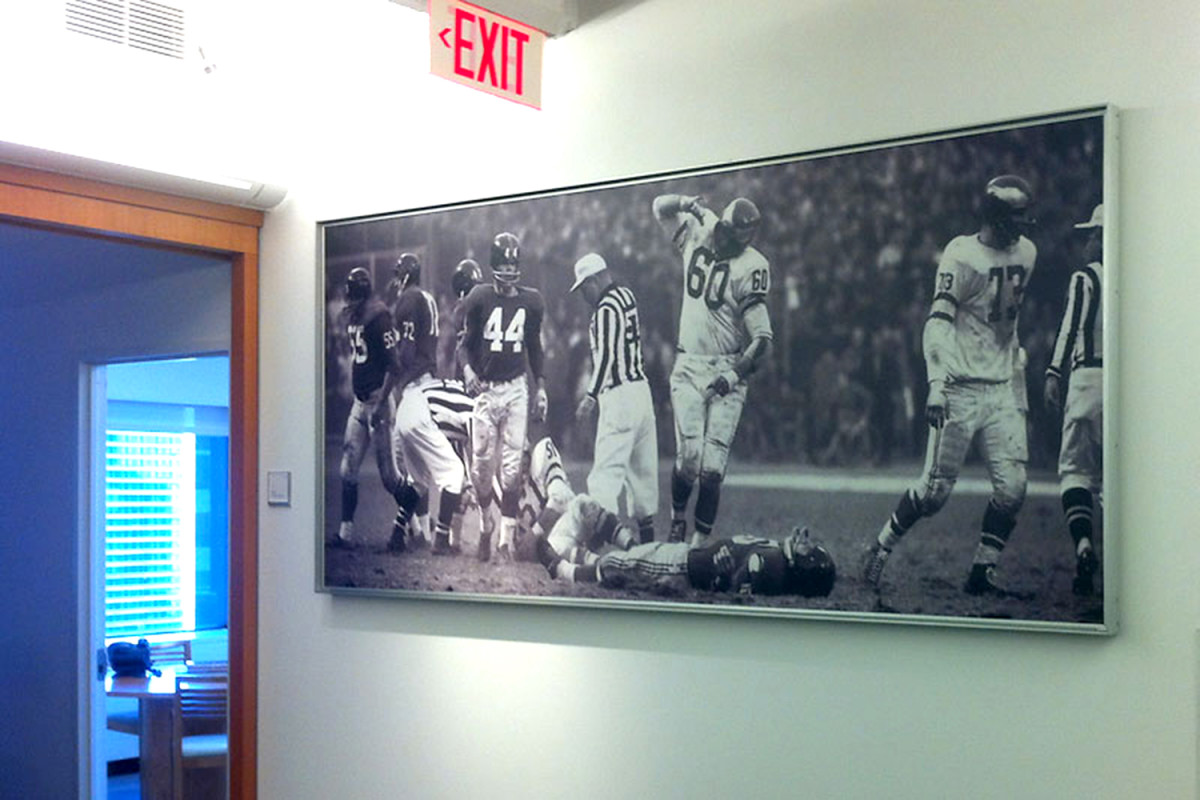
John Zimmerman’s Bednarik-Gifford Photo
Concern over player safety has become an integral part of the game in recent years, but the sheer brutality of football has undoubtedly fueled its popularity. One of the most famous hits, delivered and received by two future Hall of Famers, occurred on Nov. 20, 1960, at Yankee Stadium. It resonated at the time because the game was broadcast live on national TV; and it resonates today because of the photograph snapped by Sports Illustrated photographer John Zimmerman, which has become one of pro football’s iconic images.
With the Eagles leading the Giants 17-10 late in the game, New York quarterback George Shaw connected with flanker Frank Gifford on a slant. Gifford was leveled by Eagles linebacker Chuck Bednarik with a forearm to the chest. Knocked unconscious, Gifford was rushed to St. Elizabeth’s Hospital and wouldn’t play again for 18 months; the six-time All-Pro was diagnosed with a deep brain concussion at the time, but he learned decades later that what he actually suffered was a spinal concussion. The hit paved the way for Philadelphia to win the East conference: Gifford fumbled on the play, the Eagles recovered to seal the victory, and they won the rematch against the Gifford-less Giants the following week on the way to 1960 NFL title.
Bednarik caught grief from Giants players and fans for apparently celebrating over Gifford in the scene captured in Zimmerman’s photo. But Bednarik always maintained that he was merely celebrating the recovered fumble and didn’t even see Gifford lying at his feet until afterward.
Zimmerman continued to shoot for SI, as well as many other major publications, through his retirement in 1991. He is credited with 107 SI covers, included five for the swimsuit issue. A blow-up of his Bednarik-Gifford photo hangs in the offices of SI.
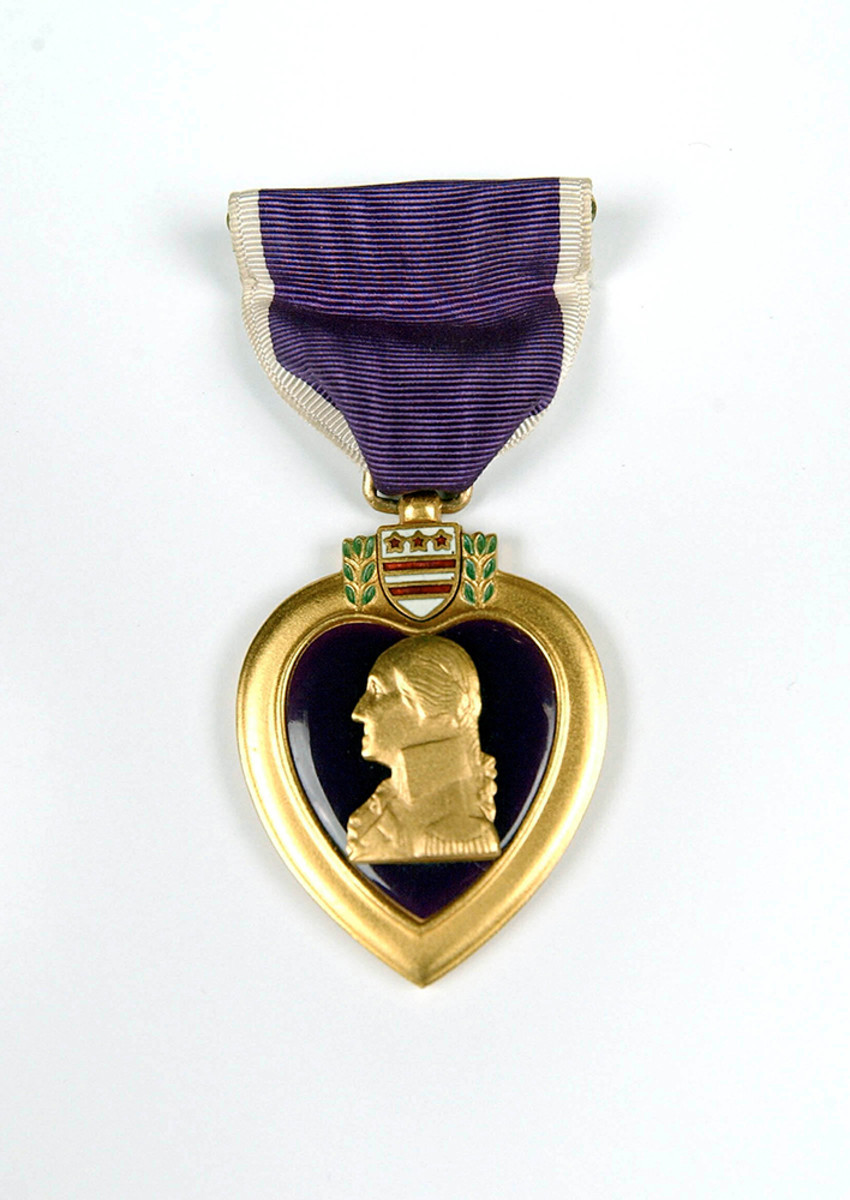
Rocky Bleier’s Purple Heart
Dozens of NFL players, coaches and team personnel have fought in American conflicts overseas, but few have told their stories as eloquently and grippingly as Pittsburgh Steelers running back Rocky Bleier did in the June 9, 1975, issue of Sports Illustrated. A 14th-round pick out of Notre Dame in 1968, Bleier had been drafted into the Army in December of that year, after his rookie season, and was sent to Vietnam in May 1969. In the SI piece, Bleier shares a graphic tale of being wounded at the hands of the North Vietnamese in August ’69, preceded by a growing sense of moral disenchantment with the American war effort. Bleier writes:
I took off the sterile gauze and found a gash four inches long and an inch deep on the outer edge of my thigh, about halfway from the knee to the waist. There was no bone damage. The bullet had simply sheared off a piece of muscle and flesh. I never thought about my football career. It was all I could do to consider the immediate options. What if the enemy saw the lieutenant yelling to me? They could tear up that hedgerow in a hail of machine-gun fire and me with it.
Bleier recovered from the gunshot and grenade injuries, for which he received the Purple Heart and the Bronze Star, and returned to the Steelers following his service. After several seasons fighting for a roster spot, he became a starter in 1974 and went on to win four Super Bowl rings with Pittsburgh, playing in the backfield alongside Franco Harris.
The Hall of Fame says 21 players, an ex-head coach and a team executive died in World War II, and two ex-players died in Vietnam. A 24th player, former Cardinals safety Pat Tillman, died from friendly fire in Afghanistan in April 2004, after leaving a $3.6 million contract to fight in the war on terror.
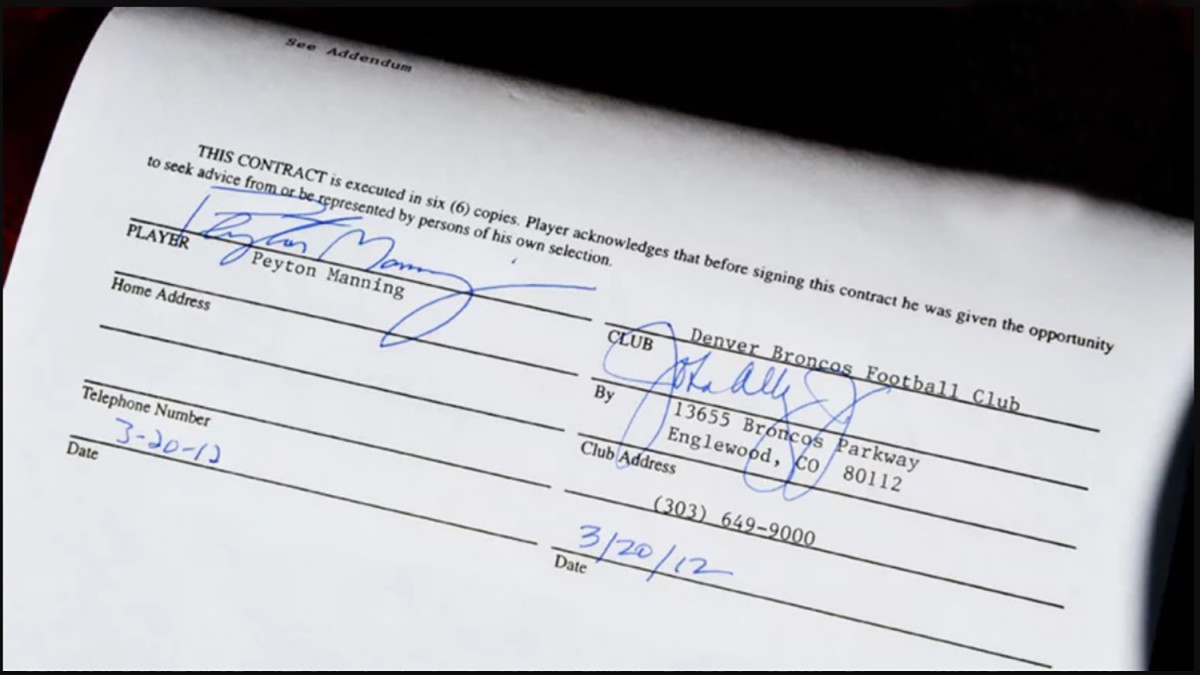
Peyton Manning’s Broncos Contract
In 1993, the NFL birthed unrestricted free agency. And two decades apart, the two biggest fish were landed: Hall of Fame defensive end Reggie White by the Packers in 1993, and future Hall of Fame quarterback Peyton Manning by the Broncos in 2012.
No one ever thought Manning wouldn’t retire a Colt—until four neck surgeries put his future in question, and the Colts could draft wunderkind Andrew Luck. Manning a free agent? Bizarre. The specter of him flying from city to city for teams to woo him was a great modern-media/TMZ-like spectacle, but Elway won him the old-fashioned way: no pressure. “There’s got to be a dagger in your gut right now,” Elway said to Manning on his recruiting visit to Denver. “Take your time. Be thorough. Make the right decision, whether it’s us or someone else.” It was one legend treating another the way he’d want to be treated, and it worked. Four seasons for Manning in Denver, two Super Bowl appearances and a Lombardi Trophy to cap off a career.
Free agency worked for White and Manning, but it’s been mostly hit-and-miss with other stars who hit the market. Would that every team find its Manning.
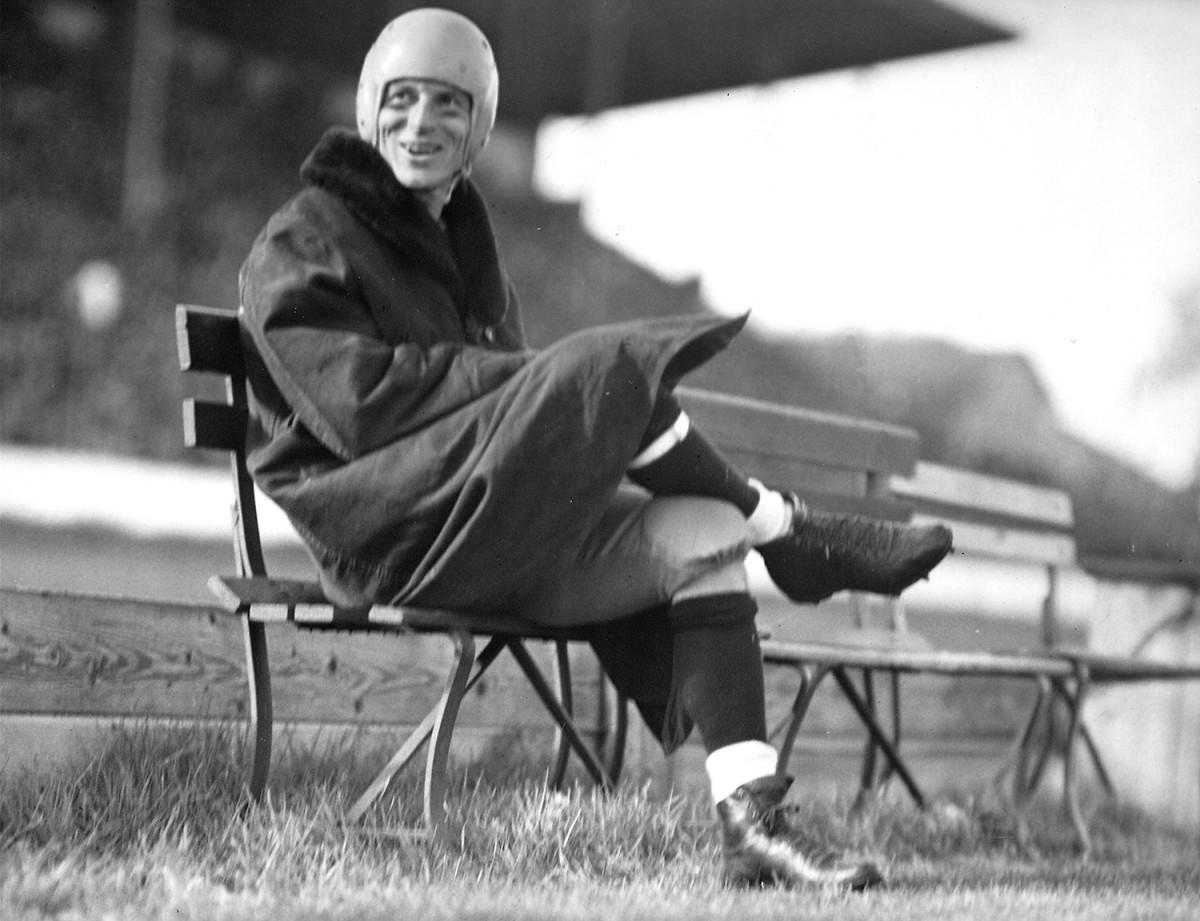
Don Hutson’s Cape
Best wide receiver in NFL history? It’s a no-brainer, right? Like the answer to the question, “Who’s the greatest basketball player ever?” Jerry Rice, like Michael Jordan, resides in a class of his own for most fans who’ve followed football over the past 50 years. But consider this: The wearer of one Superman cape didn’t play wide receiver the way we think of it, yet was every bit the difference-maker Rice was for the 49ers. Don Hutson lined up at “offensive end” for the Packers from 1935 to 1945, and when he retired he had three times as many receptions, yards and touchdowns as any other man who had played to that point.
This was an age in which a defender could hit a receiver regardless of where he was on the field, whether the ball was in the air or not; receivers were permanently defenseless. Additionally, offensive linemen could only block with closed fists or hands held near their chests, arms waving about like flightless birds. And they were turkeys in more ways than one; The statistically average New York Giants of 1935 managed 20 touchdowns in a 5-5-1 season—less than two per game. The Packers led the league that season with 1,449 passing yards with rookie Hutson—the reigning SEC 100-yard dash champion—contributing a team-best 420 yards. In 1942, Hutson had 1,211 receiving yards by himself, just over half of Green Bay’s passing offense. That would be like Rice going for 2,400 yards in 1995 (his best season), and not the measly 1,848 he had in reality. Our point: Jerry Rice may be the GOAT receiver, but the revolutionary Hutson should be in the conversation.

Tom Brady’s Draft Card
The Patriots wrote “Brady, Tom” on the card, the 199the pick in the 2000 draft, and thereby changed the course of their franchise and of league history. That selection in the sixth round was a compensatory pick, one of the four awarded to New England for losing linebacker Todd Collins, punter Tom Tupa, defensive tackle Mark Wheeler and center Dave Wohlabaugh in free agency. That’s what’s called a good return.
Brady, of course, stepped in as the starting quarterback when Drew Bledsoe was injured early in the 2001 season, and he finished that year as the Super Bowl XXXVI MVP. Five more Super Bowl rings later, the slow-footed, overlooked Michigan kid will be hard to top as the greatest draft steal ever. It’s no wonder Bill Belichick has developed a habit of hoarding draft picks. As conventional wisdom goes, though, the Patriots didn’t know what they were getting either, or else they wouldn’t have waited until the sixth round.
Brady is hardly alone as a late-rounder who rose to stardom: Richard Dent (eighth round, Bears, 1983), Terrell Davis (sixth round, 1995, Broncos) and Shannon Sharpe (seventh round, 1990, Broncos) preceded him as late-round picks who featured prominently on Super Bowl winners. And there have been great players who were never drafted at all—from Emlen Tunnell to Antonio Gates. Brady’s draft day might have been an ordeal, but his Canton induction won’t be.

A Ticket to Super Bowl I
How much has the Super Bowl grown since that first AFL-NFL Championship in 1967? The median offering for a ticket at Super Bowl I in Los Angeles was $10 dollars, and even that was apparently too expensive. Despite ticket prices of $6, $10, and $12, more than 30,000 seats at the Los Angeles Coliseum went empty for the “world championship.” Today, Super Bowl ticket inventory is controlled by the league, which allocates percentages to participating teams, the host club and the other 29 teams, as well as the league office, sponsors and business partners. Outside of some season-ticket holders, the general public typically can only get their hands on Super Bowl tickets as part of pricy “hospitality packages” or on the secondary market, for amounts that can range into the high four or even low five figures.
And look at the game now, all grown up. The Super Bowl is broadcast around the globe, in dozens of languages. It’s a metaphor for the ultimate event in any field. Every year, it’s the highest-rated television program in America. And, well, it’s the Super Bowl of advertising. Turns out $10 can go a long way.

Terrell Owens’ Sharpie
No matter the team, no matter the opponent, Terrell Owens always was confident in his capabilities as a game-changer. This is the man, after all, who professed: “I love me some me.” But tucking a Sharpie into his sock in case he scores, then having the audacity to whip it out after a touchdown, sign a football and hand it to his financial advisor sitting in a field-level box? That’s brazen, bold—and ultimately became signature Owens.
The incident, which occurred in a 2002 Monday night game between Owens’ 49ers and the Seahawks, ignited the debate on whether touchdown celebrations are creative and harmless or a poor display of sportsmanship.
Owens, of course, wasn’t the first player to exercise flare after a score. Elmo Wright, a University of Houston receiver who played five seasons in the NFL from 1971 to ’75, is widely considered the inventor of the end zone dance, and wideout and return man Billy “White Shoes” Johnson became its most famous early practitioner. Bengals running back Ickey Woods (1988-91) was synonymous with the “Ickey Shuffle,” while Jamal Anderson and the 1998 Falcons introduced Atlanta to “the Dirty Bird” dance. Yet Sharpie-gate upped the ante for end zone antics; it preceded Joe Horn brandishing a cell phone for an on-field call in 2003 and Randy Moss faux-mooning at Lambeau in the 2005 playoffs. Both Horn and Moss were fined, and the NFL has re-amended its post-touchdown celebration rules several times to add 15-yard penalties for specific actions, including “using any object [other than the football] as a prop, or possessing any foreign or extraneous object(s) that are not part of the uniform on the field.” But while the fine print may change, the memories remain, and a Sharpie is forever inscribed in the legacy of end zone celebrations.

Jim Kelly’s Houston Gamblers Helmet
The NFL wasn’t always the cash cow that ruled over all other professional sports like it does today, even after the AFL and NFL merged in 1966. The World Football League appeared in 1974-75 as a potential rival, but it wasn’t until the founding of the United States Football League, in 1982, that the NFL had a bona fide challenger. The brainchild of New Orleans businessman David Dixon, the USFL signed television contracts with ABC and then-fledgling ESPN and began play in 1983 by fielding 12 teams, with 10 in the top 13 TV markets.
The USFL would play in the spring and summer, not head-to-head with the NFL, and feature a salary cap for each team. It targeted big-name players both from the college ranks (Kelvin Bryant, Herschel Walker, Jim Kelly, Reggie White, Steve Young, Gary Zimmerman, Anthony Carter, Craig James, Mike Rozier) and the NFL (Doug Williams, Brian Sipe, Joe Cribbs), as well as future Hall of Fame coaches Marv Levy and George Allen.
The league was well received by fans, who enjoyed the forward-thinking game. Not only did the USFL have two-point conversions, video replay and true free agency well before the NFL, but it featured African-American quarterbacks. And even though the league struggled—as all new ventures do—it appeared that the USFL might survive as a spring alternative to the NFL. However, when then-New York/New Jersey Generals owner Donald Trump convinced his fellow owners to compete head-to-head with the NFL starting in the fall of 1986 and to file an antitrust lawsuit against the NFL (eventually won, for a grand total of $3 in damages), the downfall began. The ’86 season would never be played, and the league’s three-year history would end up little more than a footnote to some great NFL careers.

Sammy Baugh’s Hands
Sammy Baugh wasn’t the greatest thing in pro football since the advent of the forward pass, but he was one of the first quarterbacks to use the forward pass as a consistent weapon. Washington’s marquee player, a lanky Texan who played from 1937 to 1952, demontrated to a ground-and-pound league that the pass wasn’t just something to be used with caution or in desperation.
But the legend of “Slingin’ Sammy” is about more than just slinging—namely, his 1943 season, the likes of which we’re all but certain never to again see in pro football. World War II had drawn away many players to serve, so the NFL reduced its rosters from 33 players to 28, and Baugh often played the full 60 minutes in games. He led the league in passing, punting and picking off opposing quarterbacks (his 11 interceptions were tops among all defensive backs). In one game that season, a 42-20 win against the Detroit Lions on Nov. 14, he threw four touchdowns, intercepted four passes and booted the longest punt of the NFL season, for 81 yards.
The greatest seasons by passers today, like Peyton Manning’s record 5,477 yards in 2013, may far exceed Baugh’s 1,754 passing yards. But no player has come close to the all-around excellence of Baugh in that one stellar year.

Chicago Bears 1933 Championship Bearskin
Today’s NFL teams are driven by the quest for a Lombardi Trophy and Super Bowl rings so extravagant that, as the Giants’ Michael Strahan once said, they could be gawked at 10 tables away in a restaurant. But bling wasn’t always the reward for winning a league title. After the NFL’s first official championship game, the Chicago Bears’ 23-21 win over the New York Giants in 1933, Bears owner George Halas presented each player with an unusual memento: a custom-made bearskin, inscribed with the team’s numerical roster and painted to read, “Professional Football Champions of the World.”
Beginning the following season, 1934, champions earned the Ed Thorp Memorial Trophy, named for a deceased NFL referee and friend to many team owners. It was last awarded to the 1969 Vikings, and as legend has it, the Minnesota organization lost the trophy and has been cursed ever since. The Super Bowl era brought a new bauble—a trophy originally designed by Tiffany & Co. in 1966 and renamed in honor of legendary Packers coach Vince Lombardi after his death in 1970. And, of course, there’s the tradition of rings now given to every player on a winning Super Bowl side.
Photograph courtesy of the Pro Football Hall of Fame.
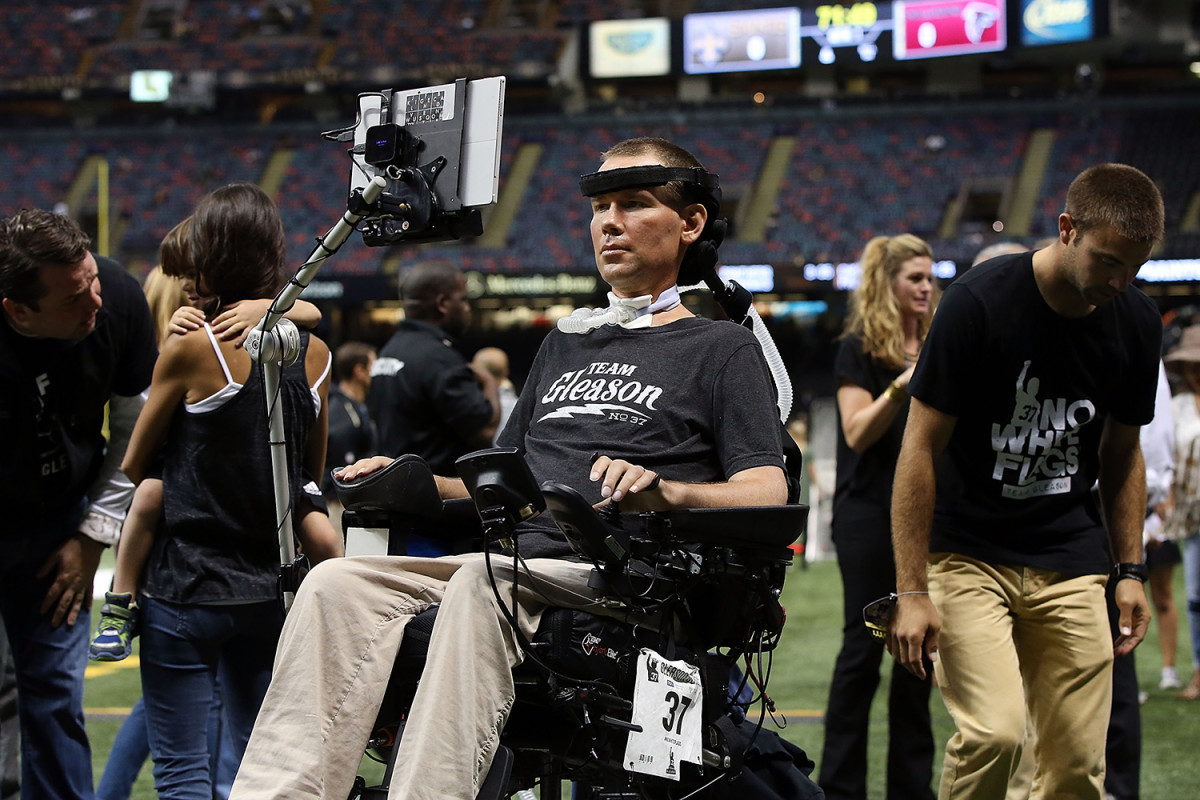
Steve Gleason’s Wheelchair
New Orleans’ NFL team hadn’t played a game at the Superdome in more than a year. After Hurricane Katrina turned their home stadium into an evacuation site, the Saints had to spend all of 2005 away from the Big Easy. In Week 3 of the 2006 season, the Saints returned to NOLA, and it took less than 90 seconds for defensive back and special teams ace Steve Gleason to ignite the Superdome crowd, blocking a punt that Curtis Deloatch recovered for a touchdown—the most memorable moment of Gleason’s seven NFL seasons. The moment is now commemorated in bronze outside the stadium.
But Gleason is best known to the wider football audience for what came after his playing days ended, when he revealed in 2011 that he was battling amyotrophic lateral sclerosis, better known as ALS or Lou Gehrig’s disease. To a certain degree, Gleason has become the face of ALS in America, the most prominent spokesman for those suffering from the disease, and an activist in the search for better treatment and management methods and, ultimately, a cure.
Although the condition has significantly limited Gleason’s physical abilities, he still completes most of his day-to-day tasks using his eyes to type words onto a small tablet attached to his wheelchair. Team Gleason, the foundation started by the former Saint’s family, has funded more than $3 million in assistive technology to help others with ALS work through similar challenges. A 2016 film documented his day-to-day battle.
Throughout it all, Gleason’s spirits have remained high and his outlook positive. “My medical prognosis is that I should’ve died five or six years ago,” he told NFL Network in an interview earlier this year. “In many ways, I feel like I’ve conquered ALS.”

Program from the Notre Dame-New York Giants 1930 Exhibition
In the throes of the Great Depression, New York City mayor Jimmy Walker issued a call for help. The New York Giants responded in a big way.
On Dec. 14, 1930, the Giants played a postseason exhibition game to raise funds for New Yorkers hit hard by hard times—and their opponent was not just any team. Across from captain Benny Friedman and his Giants was an All-Star squad of past and present Notre Dame greats, from coach Knute Rockne to the Four Horsemen of the Apocalypse: Harry Stuhldreher, Jim Crowley, Don Miller and Elmer Layden. The Giants couldn’t be stopped at the packed Polo Grounds, besting the All-Stars, 22–0. But the biggest victory was the check that Giants team founder Tim Mara presented to Walker at City Hall four days later: $115,153, the game’s entire revenue.
From its earliest days, the NFL has used its popularity for good. During World War II the league sold war bonds and contributed revenues from 15 exhibition games to service charities. In this generation, the NFL and the players union established a Disaster Relief Fund after the Sept. 11 terrorist attacks, which has since been used to contribute millions to relief efforts after Hurricane Katrina, the 2010 Haiti earthquake and Hurricane Sandy.
Photograph courtesy of the Pro Football Hall of Fame.

Akron Pros Championship Fob
Super Bowl winners in recent years have been identified by the gaudy, diamond-studded rings given to the victors. There were no garish pieces of jewelry for the Akron Pros. The first champions of the NFL (then known as the American Professional Football Association) instead received a gold fob, shaped like a football.
The first NFL championship game didn’t arrive until 1933, so the first 13 NFL champions were awarded based on record. No official league standings were maintained in 1920, but the Pros were given the title, with an 8-0-3 record, at a league meeting on April 30, 1921. The decision was protested by the Decatur Staleys (10-1-2) and Buffalo All-Americans (9-1-1), who both played the Pros to scoreless ties.
The star running back of the Pros was Brown graduate Fritz Pollard, who the following season would become the first African-American coach and would continue playing until 1926. He was one of several African-American players in the NFL’s first decade, but by the 1934 season there were none—the league would be segregated from ’34 until 1946.

Thelma Elkjer’s Vase
The AFL-NFL merger in 1970 settled the rivalry between the two leagues, but one epic fight only led to others. Such as: How would the new National Conference be realigned? This was hotly debated for eight months, until commissioner Pete Rozelle’s longtime secretary, Thelma Elkjer, reached into a cut glass flower vase at 11:26 a.m. on Jan. 17, 1970.
Three NFL clubs had agreed to join the 10 AFL clubs in the American Conference, but it was the 13 teams in the National Conference that couldn’t agree on how they’d be assigned to divisions. Rozelle drew up five possible alignments and dropped a tag for each into the vase (similar to the one pictured), leaving the teams’ rivalries and travel schedules up to chance—or, rather, Elkjer’s hand.
She picked Plan 3, which included “East” and “Central” divisions whose rivalries remain intact today in the NFC East and NFC North (except for the Cardinals having left the “East”). Most of the owners were satisfied, meaning that games could be scheduled and the new NFL had a structure. “Pete Rozelle should get the Medal of Honor,” Sid Gillman, then general manager of the San Diego Chargers, told the Associated Press.
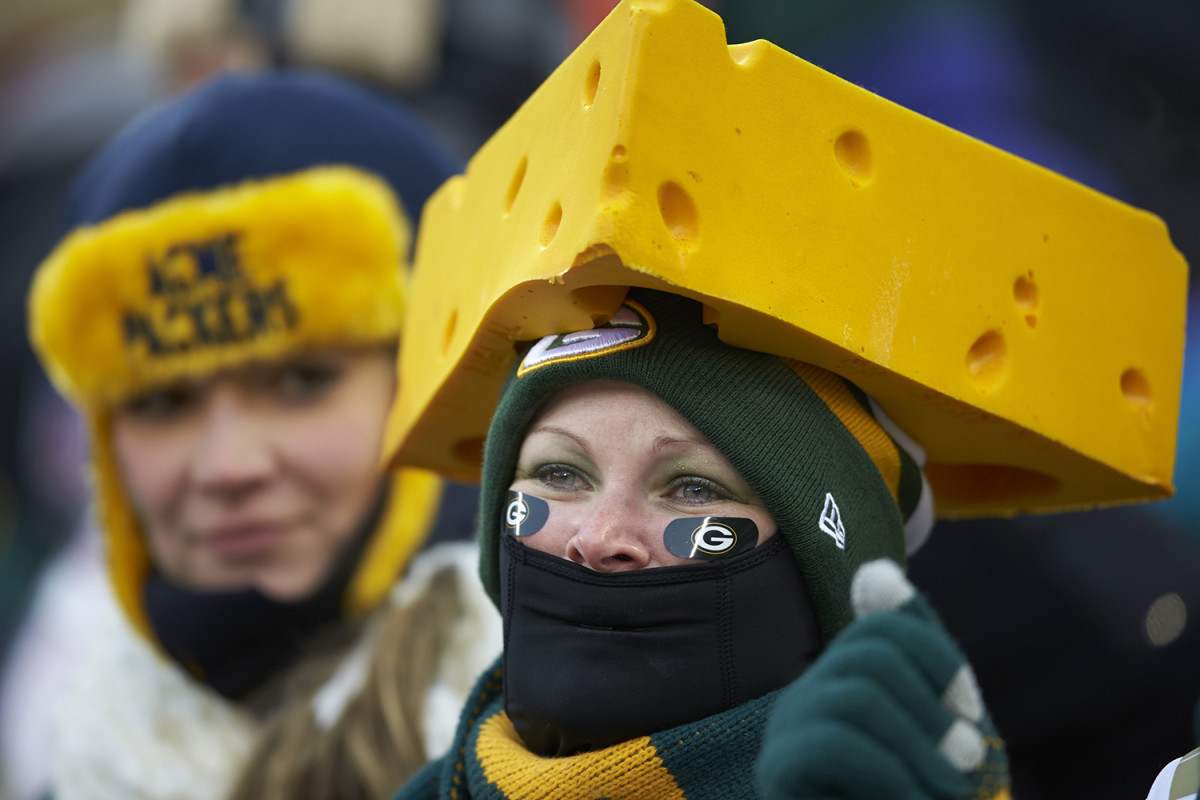
A Cheesehead
First used by in 1985 by Super Bowl champion Chicago Bears fans as an insult to supporters of the rival Green Bay Packers, the “cheesehead” label was quickly co-opted by Pack fans into a term of endearment. It turns out Wisconsinites take pride in hailing from the nation’s top cheese-producing state, which churns out about a quarter of all America’s curds.
The headpiece has humble beginnings: When reupholstering his mother’s couch in 1987, former apprentice pattern-maker Ralph Bruno found himself with some spare foam. He cut it into a wedge, burned a few holes, painted it cheddar yellow, and wore it to a Brewers-White Sox game. The next thing he knew, he was selling the hats out of a bag at sporting events. Now he owns the trademark and a factory that produces a plethora of cheesy souvenirs, including but not limited to: sombreros, crowns, bowties, footballs and even earmuffs. “Cheese is comfort food,” Bruno told ESPN in 2011. “It’s like glue that holds everything together.”
These days hordes of Packer fans don the garish gouda, at once symbolizing state, team and sport pride. No one is too good to wear a cheesehead, and that’s a major part of its charm; athletes, politicians and celebrities—from Lil Wayne to Jodie Foster—have embraced the tradition.

Roger Goodell Clown-Nose Shirt
Roger Goodell is not a fan favorite. Any issue fans have with the NFL—from suspensions to scandals to scheduling—they blame on the commissioner. At the the NFL draft, it’s a nationally televised tradition now for the commissioner’s appearance to be met by a hearty chorus of boos. You wonder why the league subjects its top man to such a reception.
For the website Barstool Sports, founded by Patriots fans, there’s a special disdain for Goodell, whom the site holds in disregard particularly for his treatment of Tom Brady and the team in the Deflategate controversy. In response, Barstool designed a t-shirt (now a best-seller on the site) that depicts Goodell wearing a clown nose. The description of the shirt reads “The biggest clown on Earth #FireGoodell.” For Goodell’s first regular-season return to Gillette Stadium after he issued Brady’s four-game suspension, Barstool printed up and handed out tens of thousands of turquoise towels with the clown-nose image. Welcome, commissioner!
Such hijinks could be dismissed as the petty protests of crass, grudge-holding fanboys if it weren’t for the fact that the sentiment expressed in the image seems to be supported by some prominent figures in the league. After the Patriots’ Super Bowl LI victory, defensive coordinator Matt Patricia (now coach of the Lions) was spotted getting off the team plane sporting the clown shirt. (Goodell was reportedly quite unhappy with the gesture.) And following the controversial ending to the NFC Championship Game in January 2019, Saints coach Sean Payton (also the target of a Goodell suspension in Bountygate) appeared to be wearing the hard-to-miss teal colored T under his jacket at a press conference. Long after Roger Goodell retires from his position as the NFL’s commissioner, fans will still recognize his face. For some, it might have a clown nose.

Marshawn Lynch’s Skittles
How do you take a kid from Oakland and turn him into a five-time Pro Bowler? Better yet, how do you take a Super Bowl champ, notorious for hating the media, and get him to open up? The answer is the same: Skittles.
While the solution might not be quite that simple, for Marshawn Lynch the treats were an integral component of his game and his NFL persona. Lynch’s mom introduced him to the candy, which she called “power pellets,” during his Pop Warner days. Lynch’s penchant for the sweets continued through college and beyond.
Lynch arrived in Seattle in a 2010 midseason trade and endeared himself to the fans with his Beast Mode touchdown run the playoffs that season. Then during a 2011 game against the Eagles, TV cameras caught him munching on Skittles between plays. Soon Lynch earned his first endorsement from parent company Mars, which included a two-year supply of Skittles and a personal dispenser for his locker. In 2014, Mars and Lynch agreed on a formal deal, which, in addition to personal compensation, provided $10,000 for Lynch’s Fam First Foundation for every touchdown he scored in Super Bowl XLVIII (he found the end zone once in the victory).
Off the field Lynch has famously avoided the media—he answered every question for Super Bowl XLIX media day with some variation of “I’m just here so I won’t get fined.” But, regarding Skittles, he’s an open book. His media silence was broken with an exclusive Skittles interview in 2015 in which he answered lighthearted questions about cat videos and jetpacks, all while munching on the snack. Later that year he appeared on Conan, jumping into an end zone filled with Skittles alongside the late night host.
Candy might not be the recommended snack for most professional athletes, but for Marshawn Lynch it might have been the secret ingredient.

Dayton Triangles Helmet and Uniform
On October 3, 1920, the first full Sunday of games in NFL history, the Dayton Triangles hosted the Columbus Panhandles at Triangle Park in what is considered the first NFL game (Rock Island had played a week earlier against non-league competition). Unsurprisingly, the gear worn by Dayton and Columbus players that day was a far cry from what we’ve become accustomed to. The Triangles sported brown, husky pants that featured a blue belt slightly above the waist. The jersey? A plain blue long-sleeved shirt that with a number on the back. Under the jersey were small shoulder pads with no braces.
But the biggest difference in equipment from the ’20s to today is the headwear. Today’s helmets are custom-fit, with multiple layers of space-age materials intended to absorb, deflect and redistribute, deal with rotational motion of the head, and protect the chin and face. The Triangles’ helmets were essentially leather shells with a chin strap clamping on below the throat. There were no face masks or mouth guards.
Lou Partlow, one of the most famous Triangles, scored both touchdowns in Dayton’s 14-0 victory that day, but that’s not what he is remembered for. Teammates said that Partlow—who was known as “the West Carrollton Battering Ram”—would run into a tree to practice blocking and build strength. Presumably he didn’t lead with the head.

Tom Brady’s Stolen Super Bowl Jersey
“Did anyone see it?!”
Tom Brady, freshly crowned as a Super Bowl champion for the fifth time in his career, was at his locker at NRG Stadium in Houston, looking for his jersey—one that had been part of the most miraculous comeback in Super Bowl history. He couldn’t find it.
A little more than a month later, that game-worn No. 12 uniform turned up at the Mexico City home of Martín Mauricio Ortega, editor of a Mexican tabloid newspaper. Not only did the police recover Brady’s jersey from the previous month, but they also left Ortega’s home with Brady’s Super Bowl XLIX uniform and Von Miller’s Super Bowl 50 helmet.
According to the original complaint from the Monday after Super Bowl LII, the Houston Police Department valued the game-worn uni at $500,000. "It is a jersey," said Art Acevedo, the Houston police chief, after it was recovered in Mexico. "But this is supposed to be the most secure environment of any sporting event in the world other than the Olympics, and some guy came and walked off with something valued at half a million dollars under the nose of NFL security.”
How? As seen on video footage captured by Fox, Ortega was on the field after the game and trailed the Patriots into the locker room. He then lingered for a few minutes, getting close enough to Brady’s locker to swipe the jersey and sneak out without being noticed.
Brady got the jerseys back, and Ortega never went to jail (part of the agreement for him to turn over the jerseys without police needing to search his house). But he won’t ever attend, much less be credentialed for, an NFL game again.
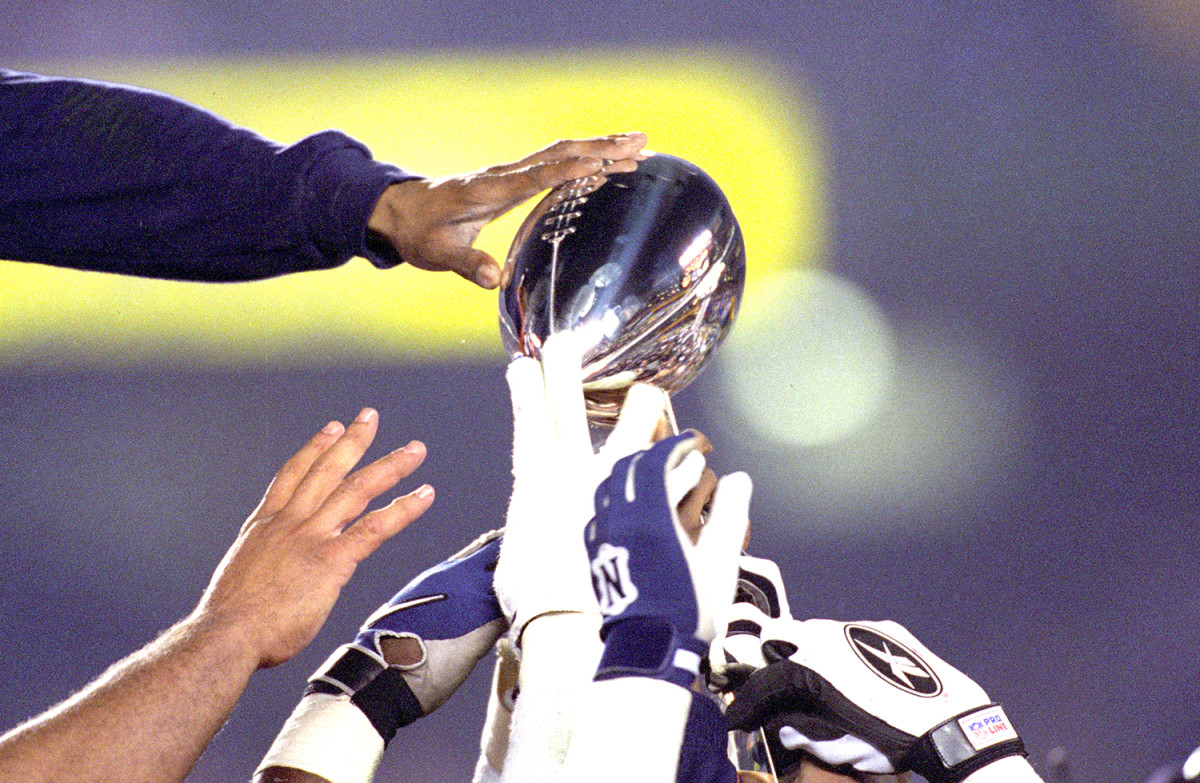
The Lombardi Trophy
In January 1967 the Green Bay Packers defeated the Kansas City Chiefs in the first “championship” game between the NFL and AFL. To the victor went the spoils, including the World Professional Football Championship Trophy, a bauble featuring a regulation-size football in a kicking position set on a pyramid-like stand with three concave sides, all done up in sterling silver.
Oscar Reidner, a vice president at Tiffany & Co., had drawn up the design on a napkin in 1966 during a meeting with NFL commissioner Pete Rozelle, and it persists to this day. The trophy is 22 inches tall, weighs seven pounds and takes about four months to make. Renamed the Lombardi Trophy in 1970 after the death of the great Packers coach, it was crafted each year at Tiffany facilities in New Jersey until 2017, when production moved to a workshop in Rhode Island.
The trophy is delivered to the Super Bowl city during the week of the game, where it typically goes on display for fans. As the game’s conclusion appraoches, it’s taken to field level in preparation for victory ceremonies. In recent years, after the final whistle the Lombardi has been carried by a series of prominent former players who make their way through the horde on the field toward the podium, where the commissioner presents it to the winning owner, coach and players. Then the Lombardi gets paraded around the field and into the winning locker room, in scenes of riotous celebration. Afterward the trophy is shipped back to Tiffany to be cleaned, repaired (if needed) and engraved with the game’s details, before returning to the Super Bowl champ for prominent display.
The silver in the trophy is worth a couple thousand dollars, depending on the spot price of the metal; with the labor involved, the trophy itself is estimated at about $50,000. Of course, any football player will tell you that the Lombardi’s real value is priceless.

The Luxury Box
A dome and fake grass weren’t the only groundbreaking innovations that the Astrodome brought to professional sports. You can also credit Roy Hofheinz and crew with introducing the idea of the luxury box to stadium design and the owners’ bottom line. These money-making suites, separating the high-rollers from the hoi polloi, became de rigeur in new and retrofitted stadiums, one reason for the massive turnover in venues in the NFL over the past few decades. “Most new stadiums are built not because they are physically obsolete, but because they are financially obsolete,” Emily Sparvero, a sports economist at Temple, told CNBC in 2012.
As free agency drove up player costs and altered the financial landscape of the league, ownership sought new revenues and found them in these sweet suite deals. AT&T Stadium, Jerry Jones’s pleasure dome in Arlington, boasts 342 “executive suites,” some of them at field level. Prices for such privacy vary around the league, with some boxes pushing seven figures for the season, limiting candidates to the ultra-wealthy or corporations, which use the boxes to court business or as a perk for employees. Adding to the appeal in the NFL was that, until the new CBA in 2011, revenues from luxury suites were not shared with the rest of the league. Owners kept all that dough.
But are the suites really a better place to see a game? Sure, the seats are cushy, the food is catered, the climate is controlled, and big-screen TVs mean you’ll never miss the action when the guy in front of you gets up for a beer. But something is lost, too—the sense of camaraderie among a fan base, the shared experience of victory or defeat that binds a community. Exclusive entrances allow occupants to avoid the riff-raff, and the glass windows of the luxury box, while they protect from the elements, are also a barrier that divides fans into the haves and have-nots.
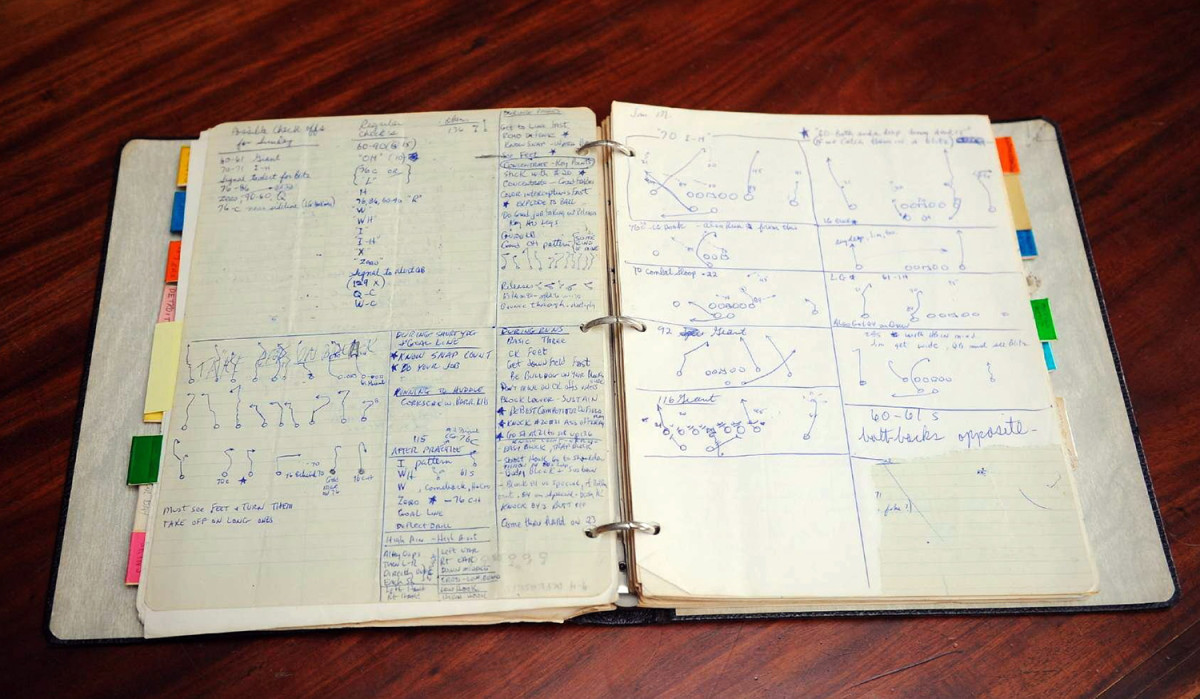
Raymond Berry’s Notebooks
From the outside looking in, the game of football may seem brutal, even barbaric—the crashing of helmets and bodies to score arbitrary points for entertainment. But for many players, the path to each touchdown is intricately planned out. Every snap is filled with dozens of moving pieces and twice as many potential routes.
In the 1950s and ’60s, Hall of Fame receiver Raymond Berry redefined what it meant to be a cerebral player. Following daily practices and team meetings, he would watch film on his own 16mm projector, carefully analyzing the timing and routes taken on each play. Focusing intently on his position alone, he studied the cornerbacks, linebackers and safeties who would be defending him. Then he would seek out the film of other receivers, most notably Harlon Hill, and take note of what made them successful. These notes filled page after page of a loose-leaf binder, meticulous handwritten observations to refer to and learn from. He would often leave notes for himself to read when he would face specific opponents, such as “WHEN YOU SQUAT TO BLOCK 71 HE WILL GRAB YOU” and “WATCH YOUR FOOTING ON STARTS.”
The borderline-obsessive notes paid off in 1958 when the Colts took on the Giants in the NFL Championship Game. His careful scouting of the opponent and the field conditions at Yankee Stadium allowed him to run the exact right routes; Berry had 12 catches for championship game-record 178 yards and one touchdown in the 23-17 win.
Berry led the league in receptions in ’58 with 56, then again the next two seasons (66 and 74). Over the course of his career, in which he had 9,275 receiving yards and 68 touchdowns on 631 receptions, Berry fumbled but once. “Raymond and Raymond alone turned himself into the receiver he became,” said his Colts coach Weeb Ewbank at his induction.
Berry, now 86, has kept those building blocks of his career ever since. Thirteen loose-leaf binders, one for every season he spent in the NFL, fill an entire shelf at his home. They represent the blueprint of every game, every play, of an illustrious career.

Shad Khan’s Yacht
Jaguars owner Shahid “Shad” Khan appeared on a 2012 cover of Forbes, the physical embodiment of the American Dream. Born to a middle-class family in Lahore, Pakistan, he moved to the U.S. at 16 and attended the University of Illinois, where he received a degree in Industrial Engineering in 1971. In the ’70s Khan developed an automobile bumper that revolutionized the industry. He then bought Flex-N-Gate, an auto parts manufacturer, and turned it into a billion-dollar business. By 2018, according to Forbes, it was the 49th-largest private company in America, with annual revenues of $7.5 billion.
After a failed bid to buy the Rams in 2010, Khan purchased the Jaguars in 2011, entering one of America’s most exclusive clubs: NFL owner. Since then he has joined an even more exclusive fraternity, dubbed by Forbes the “NFL Owners Superyacht Club.” In 2014, Khan bought Kismet, a $200 million luxury craft that, at 312 feet, is longer than a football field. As The MMQB’s Tim Rohan noted in a 2017 story, it boasts “three full bars; two hot tubs; a swimming pool; an exercise room; a barbershop; a full spa complete with a sauna, a steam room and massage table; two helipads; an 18-person dining room table; a sundeck; a band stage; and a four-story elevator.” Khan uses the ship for pleasure, sure, but also to entertain business partners and potential clients. It has a full-time staff of 28 and can be rented for $1.2 milllion a week. Bill Gates took it to Cabo, and Beyoncé and Jay-Z were on board in 2018.
You might think owning an NFL team would be enough for billionaire bragging rights, but the allure of these big ships has created a bit of a superyacht battle among NFL owners. The Falcons’ Arthur Blank recently launched the 295-foot DreAMBoat; the Cowboys’ Jerry Jones has a 357-footer called Bravo Eugenia; and Washington’s Daniel Snyder has the Lady S, complete with its own IMAX theater. Owners looking to track their rivals’ craft can always check out their location on marinetraffic.com.
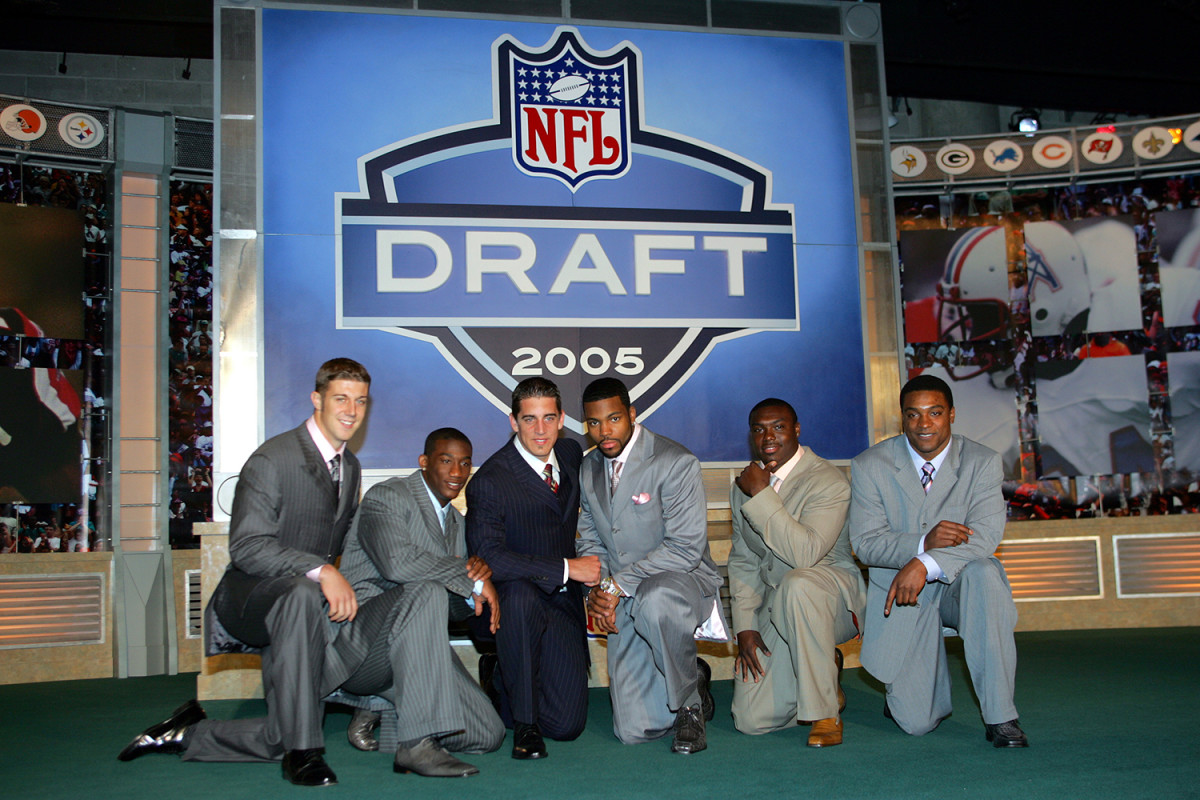
Aaron Rodgers’ Draft Suit
It’s become a tradition for top prospects to dress to the nines for the NFL draft. After all, this is their moment in the spotlight, and they want to stand out—especially since the next time most fans see them, they’ll be in the same uniform as dozens of teammates, their faces hidden behind a mask.
Six players were invited to the Green Room in 2005—Alex Smith, Antrel Rolle, Aaron Rodgers, Braylon Edwards, Ronnie Brown and Cedric Benson. Five of them were selected within the first eight picks. The other was Rodgers, who sat for more than four hours, in a dapper blue suit with white pinstripes, as cameras cut to his disgruntled face with each passing selection. Finally, after one of the most excruciating draft-day slides ever televised, Green Bay selected Rodgers with 24th pick.
Rodgers’ fall will go down as one of the most awkward, and in hindsight dumbest, in NFL history. Multiple mocks had him going No. 1 in the days before the draft—Rodgers, a California native and Cal QB, seemed a perfect fit for the 49ers at the top of the draft. Instead, San Francisco took Utah’s Smith, and a number of other quarterback-needy teams—notably Miami at 2, and Cleveland at 3—passed on Rodgers as well. Two others were the division-rival Bears, who’d started four different quarterbacks the season before, and the Lions, where Joey Harrington would last just one more season. Scouts before the draft had knocked Rodgers as merely a product of Jeff Tedford’s “system” at Cal, comparing him to Harrington and Kyle Boller and calling him “mechanically rigid” and “robotic.”
Rodgers, of course, has made the teams that passed on him pay for it. Among other accolades, he has two NFL MVP awards, a Super Bowl ring and the best quarterback rating in NFL history. Turns out Rodgers was dressed for success on draft night in 2005; it’s just that a lot of teams were fashion-blind.

Mobile Phone with Twitter, Instagram, Fantasy Football App …
Forgot to check your fantasy lineup precisely one minute before opening kickoff on Sunday? Need the most recent injury update for your beloved team? Stuck in Sunday evening traffic and can’t stop worrying about how your undefeated club is doing against its archrival? No problem. Thanks to technological advances and social media, the NFL has never been more accessible—anytime, anywhere.
Since the smart phone’s inception in the early 2000s, the NFL has been riding a digital revolution—sometimes in fits and starts, and often with outside forces leading the way, but ever forward nonetheless. With the touch of a finger, fans across the country now get minute-by-minute updates on players, teams, and front offices, and depending on their carrier or subscriptions, can watch NFL action on the fishing boat, at a backyard barbecue or on the sly during a parent-teacher conference. Twitter and Instagram have allowed for the kind of direct, unfiltered connection between fans and players that would have been unheard of in an earlier era. Stars take to social media to promote their own brand, pump up their sponsorships and charitable efforts, and maybe argue for a new contract or a way out of town. The media hop on Twitter to break news, promote stories, engage in debate—and sometimes make fools of themselves.
Die-hard fans aren’t the only ones taking advantage of the digital age. The NFL itself has capitalized on new technological capabilities, and discovered new revenue streams—actual and potential—in the process, with gambling, now mostly legal, the next big thing. Where’s it all headed? Check back in 30 seconds.

Joe Theismann’s Fractured Tibia and Fibula
Fans know football is a brutal sport, with the constant threat of debilitating injury. In 1985, that point was driven home in gruesome fashion on what was at the time the NFL’s biggest regular-season stage.
In Week 11 that year, the Redskins hosted the division-rival Giants on Monday Night Football. In the second half, with the score tied 7–7, Washington quarterback Joe Theismann handed the ball off to John Riggins, who then tossed it back to Theismann for an attempted flea-flicker. The blitzing Giants weren’t fooled, and as linebacker Lawrence Taylor hit Theismann, his knee came down on the quarterback’s lower leg, which buckled instantly. Theismann crumpled to the ground, his tibia and fibula fractured. While he later said he didn’t feel the pain as endorphins kicked in, Taylor himself screamed in horror and gestured to the Washington sideline for help.
On first viewing, the nature of the injury wasn’t immediately clear to the millions of MNF viewers. But the reverse angle of the play showed the brutal break. As players and medical staff huddled around Theismann, MNF announcer Frank Gifford intoned solemnly, “I’m sure that the word will be coming up very shortly that Theismann’s season is over.” Not just his season—Theismann’s leg didn’t heal properly, and he never played again.
Theismann’s injury was far from the first to be telecast live, and of course it wasn’t the last. But it was one of the most memorable of those many NFL moments when fans, announcers and television viewers can do nothing but sit in pained, uncomfortable silence, contemplating the toll of the game.

Bill Belichick’s Jets Resignation Napkin
Before he won six Super Bowls in 18 years and became the winningest playoff coach in history, Bill Belichick was head coach of the New York Jets—twice, in fact, without ever coaching a single game. The first stint came with an interim label as the team negotiated to bring on his mentor Bill Parcells, and only lasted six games. Parcells stepped down two seasons later, during which time Belichick stayed on as an assistant, and the team promoted him for the 2000 season.
But when Belichick stepped up to the podium for his introductory press conference just a day later, things took a surprise turn: He announced his resignation. It turned out that just moments earlier, Belichick, no stranger to making decisions under pressure, had hastily scrawled on a spare paper napkin, “I resign as HC of the NYJ.” And an instant legend was born. Belichick went on to give a 30-plus-minute speech about the decision, hinting that he was worried about the team’s future as a sale to a yet-to-be-determined owner was looming.
The situation shocked and incensed long-suffering Jets fans, who feel the pain to this day. Said ESPN host Mike Greenberg, a lifelong Jets supporter, on a 30-for-30 doc, “We don’t even mean enough to him to actually write out the words.” That bizarre moment defined the modern Jets-Patriots rivalry. New York is on its sixth coach since that day. Belichick and the Patriots just won their sixth Super Bowl. And it all goes back to that fateful napkin.

A 65-inch HDTV
For nearly 80 years, NFL fans haven’t needed to go to the stadium to watch their team play. Thanks to television, the game can be seen from the comfort of their very own living rooms.
But no longer are games single-camera events; most are captured from 12 to 20 different angles, broadcasting the sport in high-definition all over the country. Super Bowl LIII this past February featured 115 different cameras—including three 8K cameras, even though few viewers have access to such technology.
Football fans have loaded up on bigger and bigger TVs, putting multiple screens in the same room so they can watch several games simultaneously on Sunday afternoons. Many folks would rather watch from home than spend the time and money it takes to go to an NFL game. That includes Michael Puck, a social media marketer from outside Pittsburgh who has two 75-inch screens in his basement along with a subscription to DirecTV’s Sunday Ticket.“I will be honest with you,” Puck told The MMQB in 2014. “You could not pay me to go to the games.”
The broadcasting of pro football has evolved even in the last few years. Although CBS, Fox, NBC and ESPN are the primary rights-holders and pay about $6 billion per year, the NFL has worked out streaming deals in the last few seasons—Amazon paid $130 million in 2018 for the chance to broadcast Thursday night games, just a year after Twitter did the same.
And it’s not unlikely that things could change again soon. Disney’s Monday night deal runs out after the 2021 season, and the Sunday packages expire the year after that. But what remains the same is the fact that for however many fans teams keep packing into the seats, millions more will be watching at home.

The Arthroscope
When you hear the words “knee injury” and “Dr. James Andrews” in the same sentence, it’s usual not a good sign. Andrews, an orthopedic surgeon based in Gulf Breeze, Fla., has been one of the premier docs for more than three decades.
His job has been improved dramatically, though, as a result of the arthroscope, a device created in Japan just after World War II. Masaki Watanabe developed the instrument—a small tube no longer than foot with a light and a magnifying lens to allow injuries to be easily examined and cleaned without much invasion—before Robert Jackson brought the technology back to North America.
Adrian Peterson, now with the Washington Redskins, has about as much experience with the arthroscope as anyone. He tore his LCL in 2007, then his ACL in 2011, and most recently, his meniscus in 2016. Thanks to the arthroscope, Peterson was able to use his quadriceps muscle above his operated knee the morning after surgery and returned the following season to post an MVP year.
As Andrews explained in 2014, Peterson might not have been able to bounce back in the same dramatic manner had it been three or four decades earlier. “A good athlete like that may have been able to compromise and make some adjustments and still be competitive,” Andrews said. “But it certainly wouldn’t be as good of an outcome as you have today.”
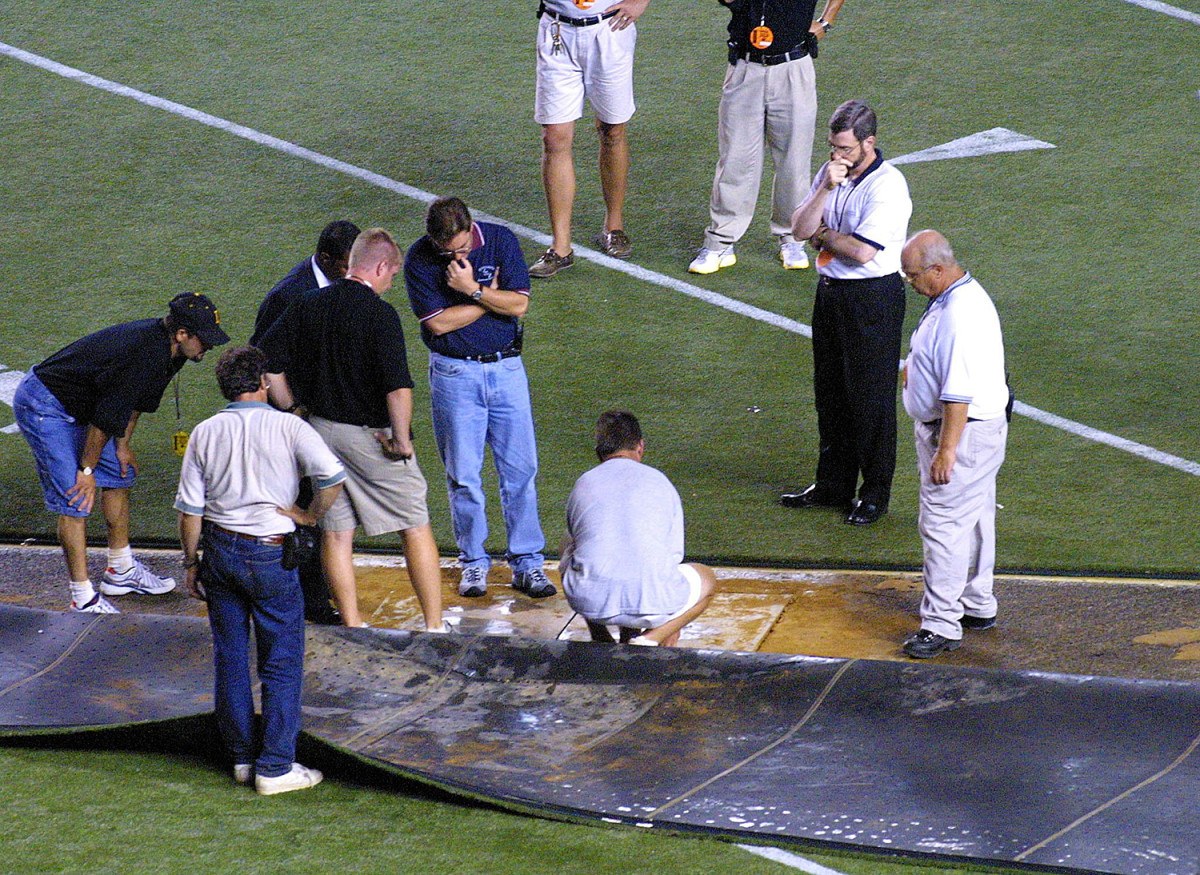
The Vet’s Artificial Turf
In 1966, Houston had a problem—the Houston Astros, that is. Their newly built Astrodome was killing the grass field, as the Lucite panels didn’t allow enough sunlight through the stadium’s roof.
Monsanto, the agrochemical company, thus developed what would later become known as Astroturf, and the artificial surface soon took off across pro sports. The Oilers began sharing a home with the Astros in 1968, becoming the first American football team to play on turf, and the Philadelphia Eagles became the first NFL team to do so when the University of Pennsylvania’s Franklin Field switched to synthetic surface a year later.
One of the big pluses of Astroturf was the ability to easily convert multipurpose stadiums. The Eagles moved to Veterans Stadium in 1971 and shared it with the Phillies, and other venues like Three Rivers Stadium and the Kingdome utilized the versatile material.
The downside, however, was the physical impact it had on players’ bodies. “I don’t’ know anybody who liked playing on the artificial turf that we had back then,” Herman Edwards, who spent all but one of his 10 seasons in the NFL on the notorious carpet at Veterans Stadium in Philadelphia, told The MMQB in 2014. “It was like playing football on concrete.” Most famously, Bears receiver Wendell Davis went up for a pass in a game at the Vet in 1993 and ruptured both of his patella tendons. He never played another NFL game.
The synthetic fields of today are much improved, designed to feel like real grass and not have nearly the wear and tear on players they did in decades past. Most players still say they’d rather avoid the turf, but its place in the history of the game is, well, cemented.

The Baltimore Colts Band Drum
Since 1947, when it first represented a team in the All-America Football Conference, the Baltimore Colts’ Marching Band has played continuously, whether its city had a football team or not. In that way, the band represents the undying passion of a city for its team, and the hopes of jilted fans everywhere that someday football will return.
The Colts franchise was canceled by the NFL in 1950 but resurrected three years later, when the Dallas Texans and their blue-and-white colors were transferred to Charm City. In between, the band played on. For the next 30 years the Colts thrived, winning four NFL championships during an era that featured quarterback Johnny Unitas and head coach Don Shula. But in 1984, after a dispute over building a stadium, the Irsay family packed up overnight and moved the franchise to Indianapolis. Again, the band played on, this time as the symbol of a devastated city. The band practiced regularly over the next 11 years, performing at NFL and CFL halftime shows and at the 1991 Pro Football Hall of Fame enshrinement. Like the band, Baltimore never let the Colts go, and the musical ambassadors joined the city’s fight to bring pro football back.
In 1996 the city was part of another controversial team move—this time when the Cleveland Browns were lured to Baltimore by funding for a new stadium. The band kept its name at first, but at the opening of the city’s new stadium in 1998, it was announced as Baltimore’s Marching Ravens.

The First Helmet Radio
Cleveland coach Paul Brown had already come up with an innovative way to communicate with his quarterback: Brown was the first coach to use “messenger” guards, alternating players who would shuttle play calls in from Brown on the sideline. But he was looking for something quicker and more direct, and in 1956 two electronics experts, George Sarles and John Campbell, devised a radio system that would let Brown talk directly to his QB through a receiver in his helmet. Brown embraced the idea—he even thought it might extend someday to communication between the sideline and assistants high up in the stands—and deployed it surreptitiously in a preseason game against the Lions (after first being granted a call number from the FCC). Detroit coaches figured it out in the second half when they noticed Brown wasn’t using his messenger guards, and found a transmitter on a pole behind the Cleveland bench.
Brown used the system over the next three games, while opponents objected—as did Cleveland quarterback George Ratterman, who would pick up not just his coach’s play calls over the radio, but taxi dispatches and police chatter. In a game against the Giants at Yankee Stadium, Ratterman finally pulled off his helmet and said, “Coach, some guy just got stabbed over on Fifth Avenue.” The Giants had been intercepting the signals as well, and anticipating the plays. Brown had Ratterman go back to the traditional helmet, and three days later commissioner Bert Bell banned radio-equipped headgear.
It wouldn’t be until 1994, three years after Brown’s death and nearly four decades after he came up with the idea, that the NFL allowed the reintroduction of radio communication—scrambled now, so opponents couldn’t listen in—between the sideline and the quarterback. This quickened the pace of the game (the play clock had been reduced to 40 seconds from 45 the previous season, resulting in more timeouts) and has created extra layers of tactical maneuvering. Since communication cuts off with 15 seconds left on the play clock, teams can shift out of the looks they were giving—since 2008, a defensive player is also equipped with a radio helmet—leaving the opponent with a new read and no help from the sideline. And of course, there have been complaints about radio shenanigans—use of multiple frequencies to bypass the cutoff, home teams fiddling with the opponent’s signal, deliberately malfunctioning headsets. The Patriots have denied the accusations.
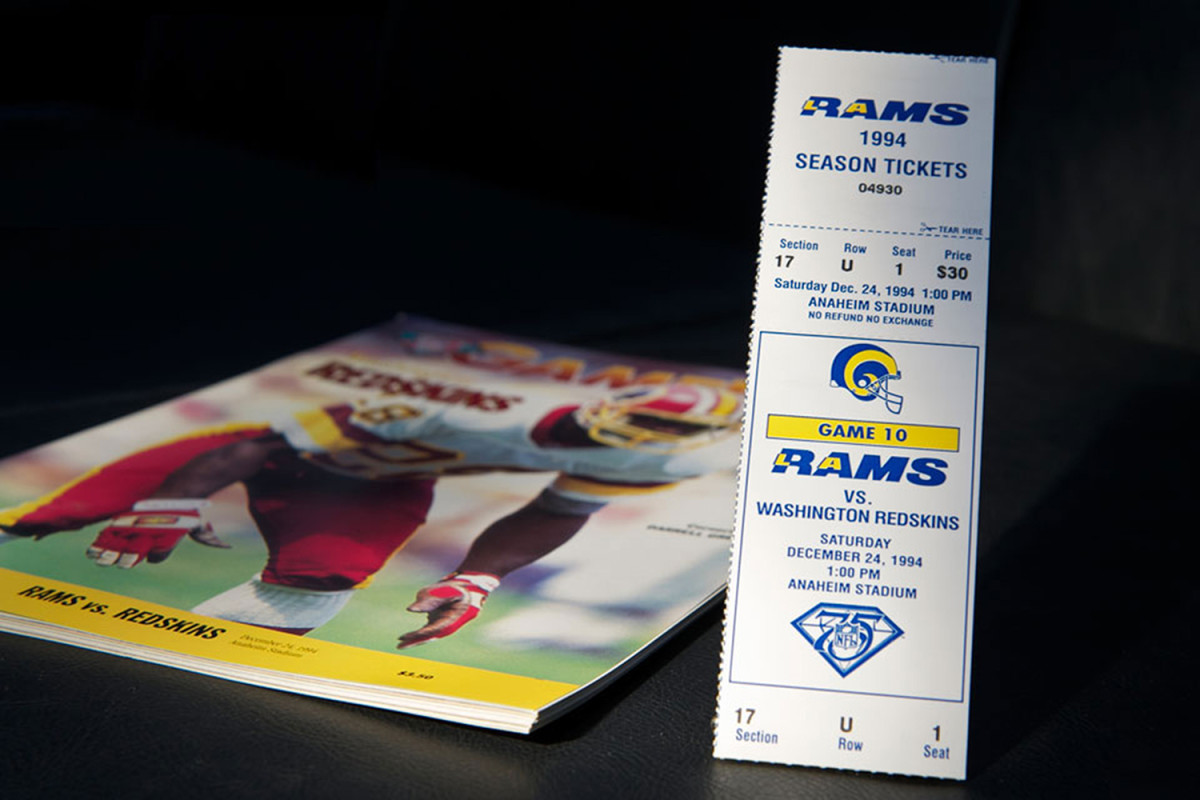
A Ticket from the Rams’ Final Game of 1994
Christmas Eve 1994 was no holiday for pro football fans in Southern California. Because Santa wasn’t delivering that year; he was taking away.
The Rams were born in Cleveland but moved to Los Angeles in 1946, the NFL’s first West Coast venture. The Raiders, founded in Oakland in 1960, came south in ’82 as Al Davis looked for greener pastures and to fill the vacuum in L.A. left by the Rams’ shift to Anaheim two years earlier. For 13 seasons the Los Angeles area boasted two NFL teams, fitting for the nation’s second-largest conurbation. Then, suddenly, it had none.
The Rams were a wounded franchise in ’94, suffering their fifth straight losing season and drawing sparse crowds at their baseball stadium in Orange County. One reason people weren’t turning up—besides the wealth of other things to do in California in the winter—was that owner Georgia Frontiere was clearly looking to relocate. When she threatened to sue to league if it blocked a move to St. Louis, the NFL acquiesced.
The Raiders were a different story. Their excellence continued in the Southland—they won the Super Bowl in the second season there—and they became part of the ’80s vibe in L.A. The influential rap group N.W.A., from nearby Compton, adopted their renegade logo, and silver and black merchandise began showing up all over urban America. Still, Davis wanted a better, more lucrative stadium, and when he couldn’t get approval, he packed up the team and moved it back to Oakland in 1995.
That last Sunday of 1994 in Southern California witnessed Joe Montana’s final NFL touchdown pass (for the Chiefs against the Raiders at the Coliseuym) and Chuck Knox’s final game as an NFL coach, in a contest at Anaheim Stadium that drew fewer fans than a high school game played in the same stadium eight days earlier. It was the end of an era, and L.A. would have to wait 22 years for the NFL to return. Now, of course, there are two teams again in L.A., the relocated Rams and Chargers. Their joint stadium at Hollywood Park is set to host Super Bowl LVI in February 2022. Maybe the Las Vegas Raiders will win a title there.
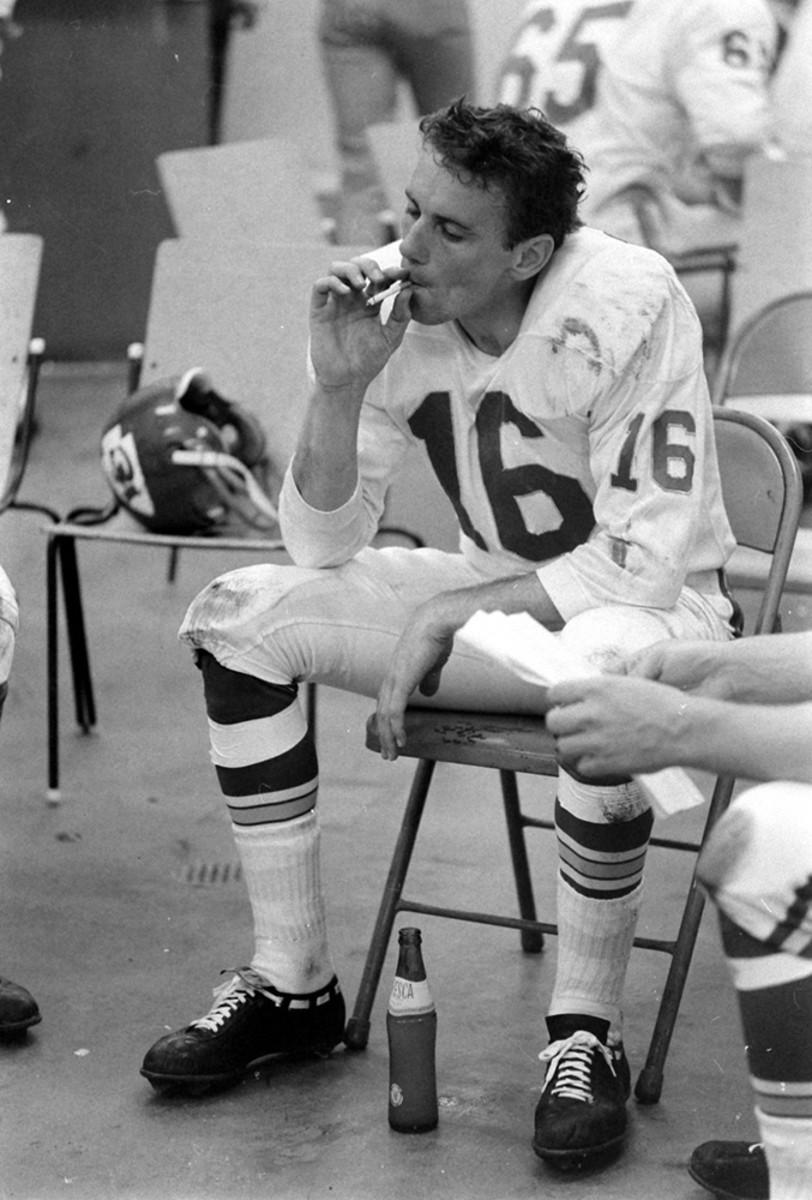
Len Dawson’s Super Bowl Halftime Cigarette
Quarterbacks these days are fanatical in their devotion to fitness. Drew Brees stays in condition with core workouts and “joint integrity” drills, and keeps his fridge filled with turkey jerky, yogurt and coconut milk. More famously, Tom Brady has his own sports therapy center and espouses the TB12 Method, which he credits with allowing him to play into his 40s, focusing as it does on such issues as “tissue pliability” and brain exercise. Brady avoids sugar, dairy and carbs and heralds the benefits of avocado ice cream and minimally processed “anti-inflammatory” foods. His TB12 website sells Cacao Goji Superfood Bites and Whey Protein Isolates. The six-time Super Bowl champion has said he’s never had coffee, and he ate his first strawberry in 2018. He didn’t like it.
In that context, the image of Len Dawson at halftime of Super Bowl I casually taking a drag on a cigarette is remarkable to modern fans accustomed to sanitized images of and stage-managed access to their heroes. In January 1967, Bill Ray had been sent by Life magazine to document the first NFL-AFL World Championship Game, and the Chiefs allowed him and his camera behind the scenes (why not?). He and colleague Art Rickerby snapped a series of photos that captured the no-frills feel of that first Super Bowl, though they were never published by the magazine.
The game was still in the balance when Dawson tugged on that cig—the Chiefs trailed just 14-10 at the half, and Dawson was 11 for 15, with a touchdown pass. Green Bay, however, opened it up in the final 30 minutes, scoring 21 unanswered points to win 35-10. The star of the game was little-used Packers receiver Max McGee, who had seven catches for 138 yards and two touchdowns. Not expecting to play, he’d snuck out of the team hotel after the 11 p.m. bed check the previous night and partied until 6:30 the morning of the game. The man was famously hung over on Super Bowl Sunday.
Dawson returned to the Super Bowl three years later, and he and the Chiefs smoked the Vikings, 23-7. The Hall of Famer played until he was 40, enjoying the highest completion percentage of his 19-year career in his final season. Patrick Mahomes paid special tribute to his cigarette-puffing predecessor before the Rams-Chargers game in December 2018.

Dan Marino’s 1987 Strike Placard
You thought replacement refs were bad? Well, lest we forget, there once were replacement players. Just after the second week of the 1987 season, players—both the rank-and-file and stars such as Dolphins QB Dan Marino—hit the picket lines when the union and league failed to agree on a new collective bargaining agreement. The players’ chief goal was free agency.
Week 3 was canceled, but the NFL insisted that the games would go on after that. Teams hastily assembled rosters of former CFLers, castoffs from the dissolved USFL and other random guys who hadn’t seen a pro football field in years, if ever. Future Saints coach Sean Payton, undrafted out of Eastern Illinois the previous spring, quarterbacked Chicago’s “Spare Bears,” the only NFL action of his playing career.
What few fans turned up were treated to the sight of NFL players picketing outside stadiums and awful play inside, though a few established players—most notably Jets pass rusher Mark Gastineau—crossed the picket line that first week. But the games still counted, the league wouldn’t budge, and players started trickling back over the next two weeks. Eventually the strike came to an end, 24 days after it began, but a cloud remained over the shortened 15-game season and the “scab” football the league resorted to. Unable to defeat the NFL through labor action, the NFLPA decertified and turned to anti-trust litigation to force free agency. After lengthy legal jostling, the players finally got what they wanted in 1993.
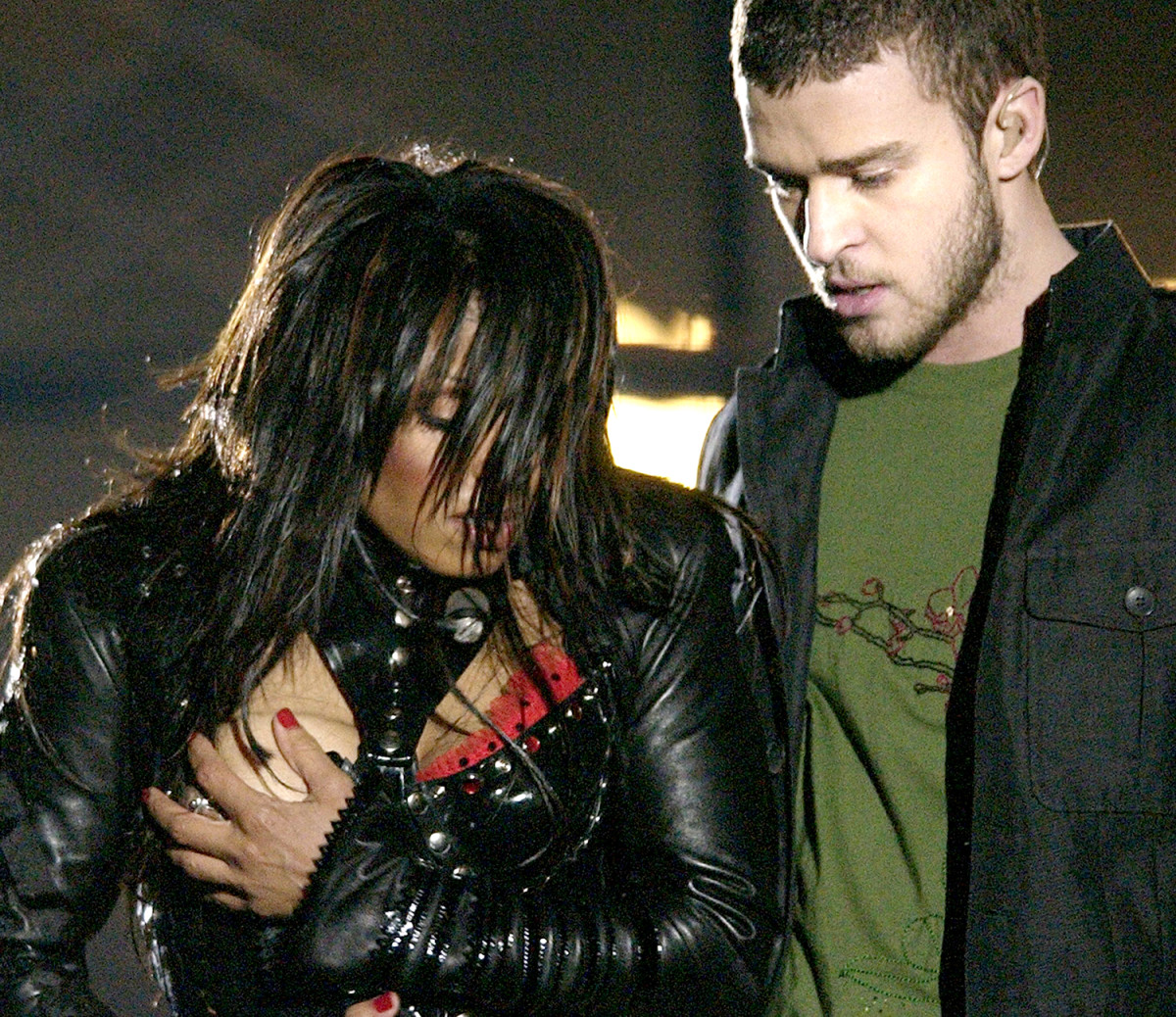
Janet Jackson’s Malfunctioning Wardrobe
The most memorable and influential Super Bowl halftime show of the 21st century will be seared into the minds of football fans not for thrill of the performance but for what was revealed of the performer. Janet Jackson, playing football’s biggest stage 11 years after her brother Michael did, joined Justin Timberlake, P. Diddy, Nelly and Kid Rock at Super Bowl XXXVIII in Houston on February 1, 2004, for the MTV-produced extravaganza. Everything was going just fine until the final song.
Timberlake and Jackson performed a duet of the former NSYNC star’s hit “Rock Your Body,” featuring plenty of edgy dance movements, all of which led up to the final line, “I’m gonna have you naked by the end of this song.” At that point Timberlake ripped off a piece of Jackson’s corset, revealing her right breast. CBS quickly cut away, but not before more than 100 million television viewers were exposed to Jackson’s silver-shielded nipple. The horror!
Was it an orchestrated stunt, or an embarrassing accident? In an apology afterward, Jackson called it a “costume reveal” and said, “It was not my intention that it go as far as it did.” Her spokesman said Timberlake was “supposed to pull away the bustier and leave the red-lace bra.” Timberlake, in his apology, said, “I am sorry if anyone was offended by the wardrobe malfunction.” Thus did a new phrase enter the lexicon.
Outraged viewers deluged CBS with calls. “This is something we would have never approved,” a network spokesman said the next day. “We are angry and embarrassed.” The FCC received more than a half-million complaints, and chairman Michael Powell called the incident “a new low for prime-time television.” He ultimately issued the network’s parent company a $550,000 fine, which a federal appeals court tossed out. The case reached the Supreme Court, which sent it back to a lower court, where it was again dismissed, creating new precedent in the government’s attempts to control “indecency” on the airwaves. The incident had wider, if more nebulous, tentacles. In a presidential election year, during the increasingly unpopular and misguided occupation of Iraq, the issue of public morality was thrust to the forefront. YouTube founder Jawed Karim said he was influenced to create the now-ubiquitous platform in part by his inability to find the Janet Jackson clip online.
In the aftermath of “Nipplegate,” the NFL drew up stricter guidelines for its halftime performers. Five of the next six shows featured older white male acts—including Paul McCartney, the Rolling Stones, Bruce Springsteen and the Who. Justin Timberlake returned to halftime for Super Bowl LII. Janet Jackson has not been invited back.

Steve Sabol’s Index Cards
When The MMQB explored the history of football in 2014, one of the most compelling and unique stories was that of Steve Sabol’s office at NFL Films headquarters in Mt. Laurel, N.J. Sabol, the Emmy award-winning NFL documentarian, died of a brain tumor in 2012, and so esteemed was he by his colleagues and protégés at the company he and his father created that his office was left untouched since the day he passed.
Among the treasures preserved in that room were box after box of index cards on which Sabol recorded thoughts that struck him, quotes he’d read or clips he came across during his prolific reading—not just football writing, but history, poetry, novels. As he prepared his scripts, he could turn to an unparalleled bank of commentary, his own and others’, to enliven the narration and imbue NFL Films with the distinct, authoritative and offbeat voice that fans have come to know and love.
The note cards were indexed and categorized according to theme, team or player, the topics and sources as diverse as Sabol’s fascination:
Under Late Season: “I like a look of agony,” wrote Emily Dickinson, “Because I know it’s true.”
Under Brett Favre: Mondrian, Van Gogh, Picasso, Renoir.
Under Ray Lewis: Greatness does not mean perfection. Many great men were flawed.
Under Playoffs: “The Emperor does not share your optimistic appraisal of the situation” —Darth Vader
Under Analysis: “There is nothing more deceptive than an obvious fact.” —Sherlock Holmes
Under Lombardi, who had a box of all to himself: The story now is not Lombardi in his time, but how he lives in ours. His spirit still summons up the best we have to offer.
Ed and Steve Sabol, through NFL Films, shaped the image of professional football for generations, and the league continues to honor his spirit and his legacy. Steve Sabol was unapologetic in his love for the game, and his mythologizing of it.

Tottenham Hotspur Stadium
The NFL played its first game in London in August 1983, an exhibition between the Vikings and Cardinals at Wembley Stadium that left the participating players mostly puzzled but piqued the interest of the league on the U.K.’s potential. Three seasons later the Cowboys and Bears—with William “The Refrigerator Perry” now a global phenomenon—met at Wembley in the first “American Bowl.” The preseason exhibitions would continue for the next seven years as the NFL, focused now on expanding markets, contemplated a wider international audience. NFL Europe’s launch (as WLAF, the World League of American Football) in 1991 made the American Bowl a bit redundant, and it ended after 1993. But over the course of the ’90s and 2000s, as U.K. fans became more knowledgeable and sophisticated, was clear that real NFL games were what the audience demanded. NFL Europe folded in the spring of 2007, and in October of that year the NFL staged its first regular-season game in London, between the Dolphins and Giants. The International Series was born.
The crowds were there. The London games regularly sold out, a mix of U.K. and European fans and Americans abroad packing Wembley, eager to see meaningful NFL action. The effort expanded to two London games in 2013, then three in ’14 and four games by 2017. Jaguars owner Shad Kahn, who also owns London soccer club F.C. Fulham, committed his team to the U.K. effort, making London a de facto second home for the Jags. The inevitable next question is whether the NFL will put a franchise—the Jaguars, some other existing team, or an expansion outfit—in the U.K. at some point.
While the logistics of such a move are daunting, the stadium question at least won’t be a problem. In 2015, Premier League team Tottenham Hotspur announced a 10-year agreement with the NFL to host two games annually, and unveiled plans for a new North London stadium specifically designed to accommodate both soccer and American football. After some delays, the stadium—which has a retractable grass field for soccer, with an artificial surface underneath for American football, as well as expanded locker rooms to fit larger NFL squads—opened for footy in March 2019 and was scheduled to host two NFL games in the 2019 season. “What we have done,” Spurs executive director Donna-Maria Cullen told The MMQB’s Jenny Vrentas in 2017, “is bring together the two most popular sports in the world.”

The Telestrator
It was January 1982, and Super Bowl viewers were to see NFL football in a way they never had before on television, a window that would open up the tactical elements of the game and allow fans to understand the action on the field the way a coach does. On that 49ers-Bengals Super Bowl XVI broadcast, John Madden unveiled the Telestrator to its widest audience.
Since joining CBS in 1979, the former Raiders coach had proven to be a popular and engaging color commentator, punctuating his trenchant analysis with booms! and bams! and doinks! The new device allowed him to get more technical, using a stylus to draw lines and circles on the monitor, illustrating a play’s development, blocking schemes, receiver routes and other insider aspects of the game that announcers previously had to convey through description.
Physicist Leonard Reiffel had developed the device while hosting a children’s science program in Chicago in the ’60s. He pitched the tool to the local CBS station, WBBM, which adopted it for its weather reporting. But former Bears back Johnny Morris, WBBM’s sports anchor at the time, saw its potential for football. He and Reiffel experimented with the device on a few Bears broadcasts, and it was adopted by CBS for the 1981 postseason. Reiffel—who as a researcher in the ’50s was once tasked with exploring the possibility of exploding an atomic bomb on the moon—was in the booth with Madden for those first playoff games with the Telestrator. “I soon learned that he got very excited when on air,” Reiffel said. “As he jumped around and pointed and drew his telesteration, there were times when he almost knocked me right out of the announcers booth.”
Reiffel won a 2004 Emmy Award for the Telestrator, which is now a broadcasting staple. And he never did blow up the moon.

The College All-Star Uniform
Remember, just at the start of 2019 training camps, when Kyler Murray, Nick Bosa and the rest of the big names from the draft faced off against the Patriots in an exhibition match at Soldier Field? No? Well, for four decades the Chicago College All-Star Game was a significant event on the NFL calendar, pitting college seniors from the previous year, decked out in blue and white unis with stars on the shoulders, against the champions of pro football.
Back in the ’30s, when the college game was ascendant, the collegians vs. pros matchup was a way to showcase the NFL and promote the amateur stars who were making the jump to the professional ranks. The brainchild of Chicago Tribune sports editor Arch Ward, who’d also devised baseball’s All-Star Game, the first matchup was played at Soldier Field in 1934—a scoreless tie in front of nearly 80,000 fans. The annual game, which benefited Chicago charities, grew in popularity in the ’40s, with crowds numbering more than 100,000 on occasion, but by the ’60s it had become less competitive (the collegians won just once after 1958), and NFL coaches were increasingly wary of subjecting their new draft picks to potential injury and getting them late to camp. The last game, in 1976, was suspended in the second half due to a torrential downpour and unruly fans.
The idea seems unthinkable now, but every summer for four decades, stars of the college game, from Michigan center (and future U.S. president) Gerald R. Ford to Jackson State’s Walter Payton, showed their stuff against the NFL’s best.

A Press Credential From the 2019 Combine
The NFL combine wasn’t always the six-day nationally televised underwear Olympics it is now. In fact, it wasn’t even called the combine when it launched in 1982.
NFL teams had been pooling their information on potential draft picks since the early 1960s, when the Lions, Eagles and Steelers formed the LESTO (later BLESTO and then BLESTO-VIII) scouting service. Other teams soon followed suit—the Cowboys, Rams and 49ers created Troika, which became Quadra with the arrival of the Saints, and eventually National Football Scouting, which now serves a majority of NFL teams. In ’82, Cowboys GM Tex Schramm proposed that the National (as it’s known) should stage a combined camp for its member teams for the purpose of conducting medical evaluations of prospects, rather than each team having to fly in players to do its own tests. By ’85 all 28 teams were participating in the National Invitational Camp. In ’87 the operation moved to Indianapolis, which appeals to teams for its centralized location and compact downtown facilities.
Over the years, workouts were added to the medical evaluations (which are still the priority), and football journalists began to turn up, since it was a target-rich environment, with coaches, GMs, agents and staffers from every team and around the league all gathered in one place, in a relaxed, offseason environment. Stories could be found and sources mined late into the night, in hotspots such as St. Elmo’s and Prime 47. From a few dozen writers in the ’90s, the media horde grew to 500 by the mid-2000s, with the explosion of internet football sites and fans’ seemingly insatiable appetite for news and info.
In 2004 the newly launched NFL Network, hungry for programming, started televising the combine with hour-long recaps. By 2019 it was airing nine to 10 hours a day live over the four days of workouts; ESPN joined the coverage in ’19, with ABC also airing two hours of QB and receiver drills.
Most reporters and other insiders will tell you that little that viewers at home see on the screen really matters—it’s the closed-door interviews and the medicals that really count. Nevertheless, from its humble roots, the combine has only grown bigger every year—in 2018, the NFL issued 1,351 media credentials, and there has been talk that the league might move the event, now one of the biggest on its 24/7, 365-day calendar, to Los Angeles to boost its profile even more.

The Draft Clock
The phrase “on the clock” has been synonymous with the NFL draft since the league’s annual player selection meeting boomed in popularity in the 1990s. Above the NFL’s draft stage at Madison Square Garden (1995-2004), the Javits Convention Center (2005) and Radio City Music Hall (2006-12) hung a 4½-foot-by-5½-foot old-school stadium scoreboard clock, tracking the amount of time each team had to make its selection in each round—15 minutes in the first round back then.
You’d think an NFL team, accustomed as it is to hurry-up offenses and two-minute drills, would be able to make a decision on a player in that 15-minute allotment, especially since the draft is the culmination of months of scouting and evaluation, and staffs draw up big boards in their draft rooms and even run their own simulations. But teams have been beaten by the buzzer on occasion. In 2003 the Vikings, holding the seventh pick, were entertaining offers from three clubs looking to move up. Minnesota thought it had a deal with the Ravens at 10, but the clock ran out on them. (The Vikes insisted they had turned in their card, but the league said it didn’t have verification of the deal from Baltimore.) The Jaguars and Panthers jumped in, taking quarterback Byron Leftwich and and tackle Jordan Gross, respectively, before the Vikings could get their pick in; they ultimately took defensive tackle Kevin Williams (whom they said they’d wanted all along). The previous year, the Vikings thought they’d caught the Chiefs in a similar situation and turned in their card for defensive tackle Ryan Sims, only to be told that Kansas City had in fact gotten its pick in on time. Minnesota settled for offensive lineman Bryant McKinnie that year.
Hard luck? Williams played 11 seasons for the Vikings, as a five-time All-Pro and one of the NFL’s best interior lineman of his era. McKinnie, after a slow beginning, was an eight-year starter on the Vikes’ O-line. Sometimes the draft buzzer can be your friend.
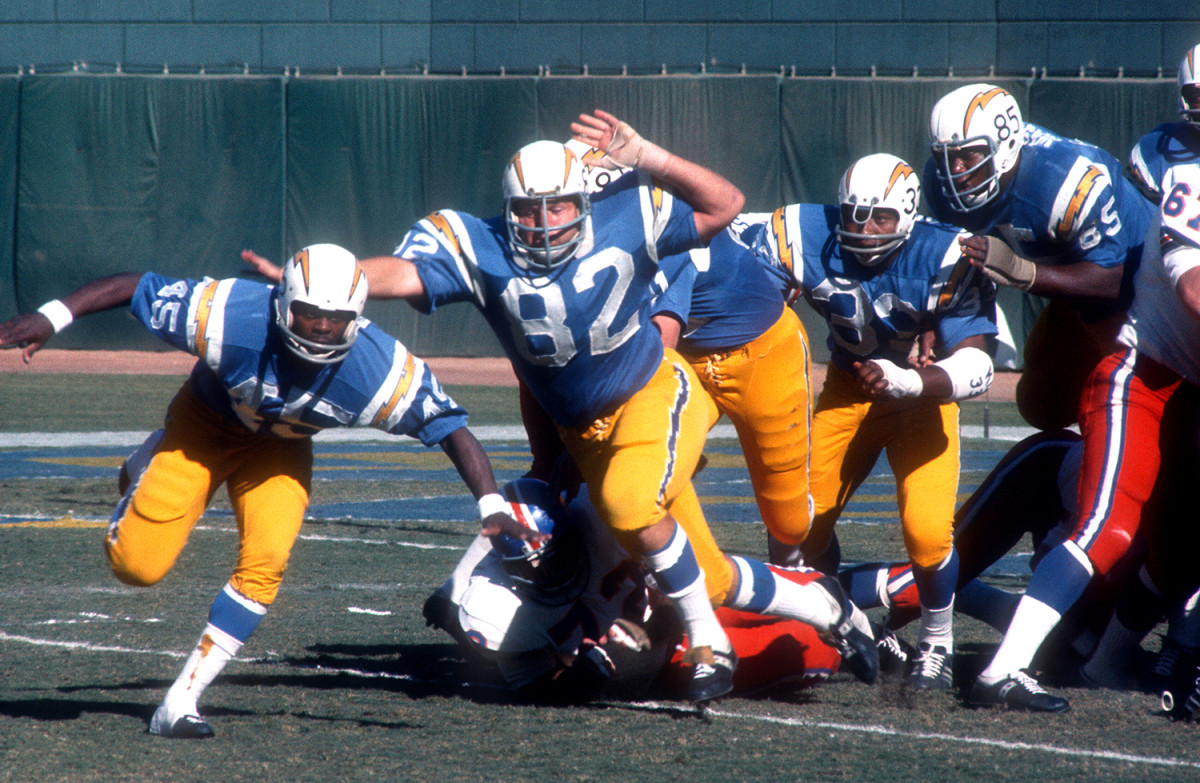
The Chargers’ Powder-Blue Uniforms
There’ve been plenty of distinctive uniforms—good and bad—in the NFL over the years, but none to top the Chargers’ powder blues. Something about the shade evokes the California sky, with the yellow trim suggesting sunniness and the lightning bolts on the helmets, sleeves and pants adding an extra jolt of cool. Aficionados also love the numbers on the side of the helmet, the only NFL team that would regularly boast that feature.
The Chargers employed some shade of the powder blue from their inception in 1960 up through the 1973 season—the lightest colors coming in the late ’60s, when John Hadl was launching bombs to Lance “Bambi” Alworth. “Everybody looks like Bambi” in those Chargers powder blues, sportswriter Joe Posnanski told NFL Films in a 2011 countdown of the league’s all-time best unis, a list that had the Chargers No. 1, of course.
Bafflingly, San Diego dropped the color for the ’74 season, changing to a deeper blue in hopes of a change of fate after four losing campaigns. Thus did the Chargers blend back into the NFL fashion pack, except for those occasions when they’d break out the throwback look for some historical commemoration, as during the NFL’s 75th season in 1994 and the team’s 40th in 2000. In 2002 the powder blues were added as an official third jersey.
“When you’ve got the best uniform in the world, you should use the best uniform in the world,” San Diego columnist Nick Tanepa opined in that NFL Films doc. The Chargers finally listened to the fashion faithful. The team, which returned to its L.A. roots in 2017, announced that the iconic powder blues would be their primary home uniform for 2019.

Walter Payton’s Forearm
There were a lot of elements to Walter Payton’s greatness on the football field. His legendary hill sprints. His passion and competitiveness. His joy for the game. His power, speed and willingness to fill any role. One overlooked characteristic of the soft-spoken man they called Sweetness was this: his commitment to violence.
Payton learned from an early age that to succeed as a running back, he needed to dish out as much punishment as he received. His weapon was the forearm. Growing up in Columbia, Miss., Payton was told by his high school coach, Charles Boston, that “when I could no longer successfully elude a tackler, I should let the man have a memory of the tackle as vivid as my own.” And in college at Jackson State, his coach, Bob Hill, taught him one way to do that. As Jeff Pearlman recounts in his monumental biography, Sweetness, Hill told Payton how in his own playing days he’d wrap cardboard around his forearm, tape it up, and use it to clobber would-be tacklers. The next game Payton turned up with a knee pad covering his arm. “From that day forward, Payton’s forearm served as a cement block,” Pearlman writes. “He raised it, then slammed it down upon an opponent’s head. He used it like a club and gnashed it into an oncoming tackler’s jaw. Whereas defenders once only had to worry about Walter’s speed and toughness, they now had to concern themselves with assault and battery.” After games, one teammate noted, Payton’s elbows would be the size of grapefruit.
Payton brought that ruthlessness to the NFL when he was drafted in 1975, fourth overall, by the Bears. And he honed that physicality during his early years, when he found he’d need more than speed and elusiveness if he was going to survive behind a mediocre offensive line on some talent-poor Bears teams. Through the years, Payton would often wear thick elbow pads to protect from both Soldier Field’s abrasive, rock-hard artificial surface and the impact of the blows he’d be delivering. Walter Payton’s smile is etched in the memory of fans, but it’s his iron forearm that left perhaps the strongest impression on opponents.
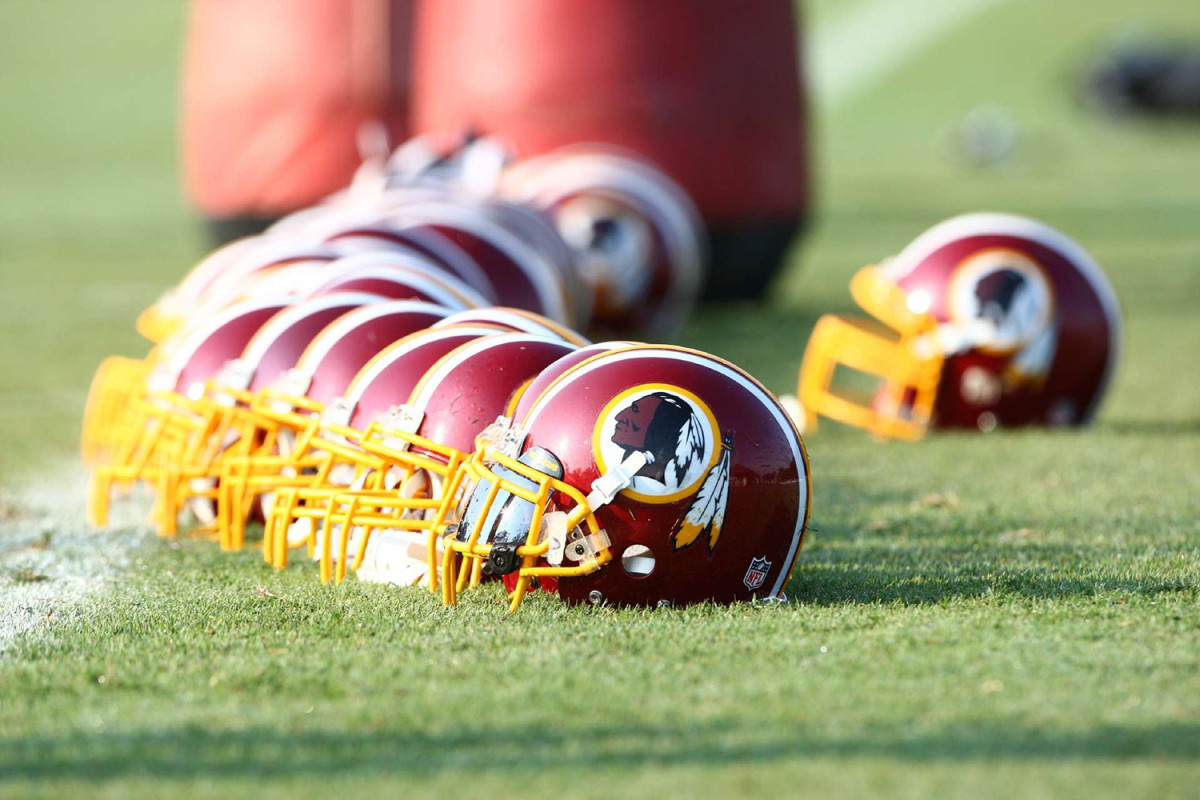
A Washington Redskins Helmet
In an earlier time, few if anyone found offense in Native American imagery and names being used for sports teams. Across the nation in the 20th century, football squads from the pee wees to the pros took the field as Indians, Braves, Chiefs, Apaches, Seminoles, Sioux. Gradually though, as Native Americans gained a greater cultural voice, there began a pushback against the use of such iconography. In recent years the issue has become one of the most volatile in sports. Proponents of the existing names and images say they honor Native American tradition and point to support from some Native American groups; opponents, including Native American activist groups, see them as disparaging stereotypes.
The names that have been the most controversial are those such as Redskins and Redmen, seen by opponents not just as exploitative or insensitive, but as racial slurs. In 1995 St. John’s University changed its nickname from Redmen to Red Storm; in ’96 the University of Miami in Ohio went from Redskins to RedHawks. Other images—the Atlanta Braves’ war-dancing Chief Noc-a-homa, the Cleveland Indians’ grinning Chief Wahoo—have been retired or moved to the background.
Washington’s NFL team has been at the heart of the controversy, given its high profile as representing the nation’s capital in America’s most popular sport. Team officials have claimed there’s widespread support for the name “Redskins” among Native Americans; organizations such as the National Council of American Indians say otherwise. As the issue heated up in the mid-2010s, team owner Dan Snyder made outreach efforts to Native American communities and honored four Navajo Code Talkers, World War II heroes, at a game. A lawsuit that petitioned to strip the team’s right to use “Redskins” as a trademark was ultimately made moot when the U.S. Supreme Court ruled that trademarks are constitutionally protected free speech. While school districts, universities and other organizations around the country are increasingly retiring Native American sports mascots and names, Snyder and the Redskins are standing firm. In 2013 he told USA Today, “We’ll never change the name. It’s that simple. NEVER—you can use caps.” Or helmets, if you wish.

A Giant American Flag
The American flag has been an integral part of the ritual of sporting events for generations. Baseball has decked itself out in bunting on big occasions since its earliest days, and the tradition of singing the national anthem while facing the flag, hand over heart, began during the 1918 World Series, in the midst of World War I. Football, of course, has long been in on the patriotic displays. Over the last few decades the ceremonies have gotten ever more grandiose, and the flags ever more enormous.
Field-size flags have been around since the 1980s, but it was after the 9/11 attacks that they became ubiquitous. They also became good business for a few small companies. An outfit called 50 Star Productions in Salt Lake City provides more than 100 giants flags per year for sporting events, ranging in size up to 150 by 300 feet (a full football field) and weighing more than half a ton. The massive flag isn’t one giant roll of fabric, though—the largest version is made up of 14 pieces, for ease of handling. It wasn’t always this way with big flags, though. Super Bowl XXII in 1988 boasted a flag made of balloons for Herb Alpert’s “Star-Spangled Banner,” and during Whitney Houston’s famed rendition of the anthem at Super Bowl XXV in January ’91, the “flag” was formed by dozens of volunteers holding red, white or blue umbrellas.
Why are football and the flag so interwoven? Given the rarity of major events in which tens of thousands of Americans gather together in ritualized fashion, the NFL offers one of the biggest arenas in which to affirm our common bond. But that can be problematic when some Americans feel the bond has been broken. In 2016, after a series of police shootings of unarmed black men, 49ers quarterback Colin Kaepernick began making a gesture of silent protest during the unfurling of the flag and the playing of the anthem. Suddenly the pregame ritual became a point of division rather than unity. Kaepernick’s kneeling gesture, in which he was joined by dozens of other NFL players, raised thorny questions about the intersection of sports and politics. Is a protest during such a display disrespectful—to the country, to “the troops”—or does it go to the heart of the American tradition of free expression? Does the flag only stand for a certain kind of patriotism? As we contemplate these questions, it’s worth noting: The NFL shield itself is a version of the Stars and Stripes.

George Halas’s Film Projector
George Halas was a pioneer on multiple fronts. The NFL’s co-founder and longtime Bears boss was the first to institute daily practices, put coaches in the press box and have his team’s games broadcast on radio. He was also the league’s first film buff. To prepare for upcoming matchups, Halas hit on the idea of studying footage of his opponents, to familiarize himself with their plays, gauge their tendencies and prepare his own team.
The practice was soon adopted by everyone, and advances in technology—first tape, and now digital video—have allowed teams to vastly expand the amount of video they can study. Teams now employ armies of assistants to cup up video of opponents weeks in advance. Film study has also turned into its own branch of media specialization. ESPN’s long-running NFL Matchup brought X’s and O’s analysis to TV, and Jon Gruden turned his mania for tape study into engaging programming during his coaching hiatus, with his popular if sometimes campy QB Camp. NFL’s Game Pass platform gives fans the option of watching the “All-22” angle that coaching staffs use to study formations and schemes. Most NFL websites, as well, have a “tape” person, who specializes in breaking down the game from a tactical standpoint. These days even casual fans can recognize a spread formation or a Cover 2 defense. Ultimately they have Papa Bear to thank.
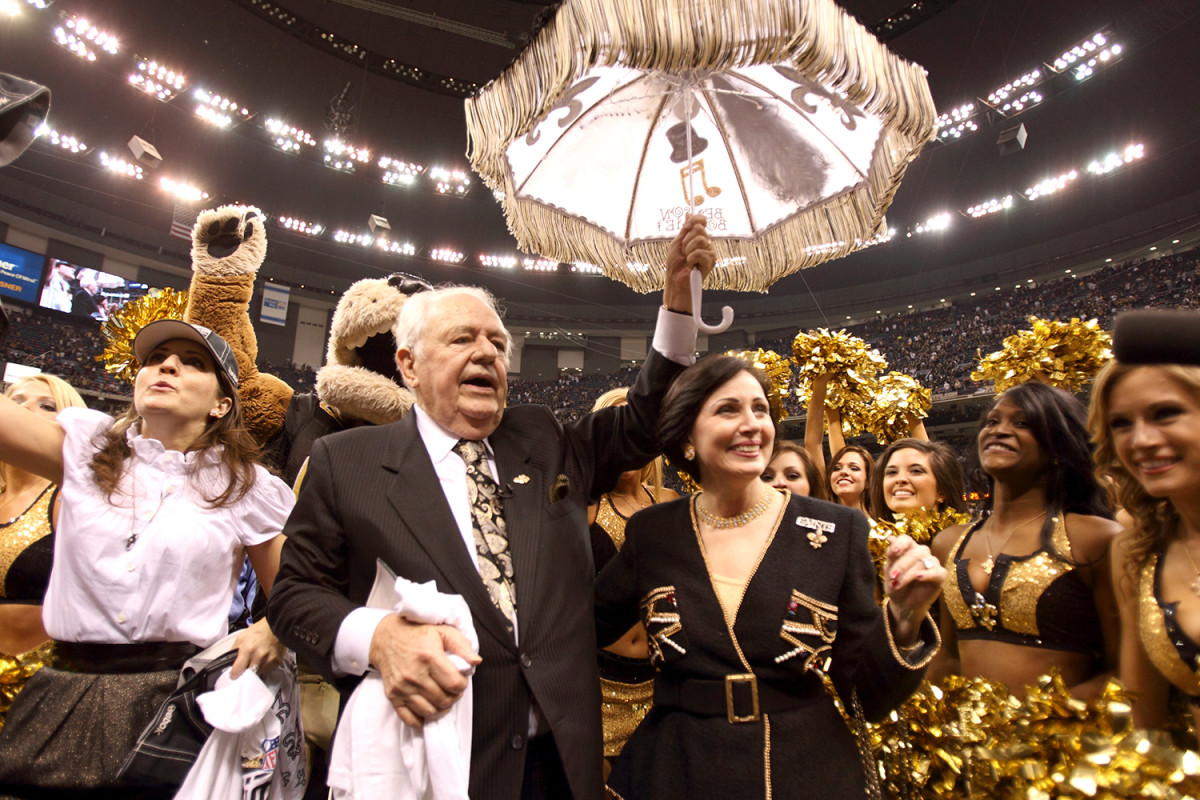
Tom Benson’s Parasol
The Saints have always been a little … different. Joining the NFL in 1967, they seemed to flout the league’s rigid, disciplined demeanor, a mostly hapless but wildly entertaining representative of the Big Easy’s motto, “Laissez les bon temps rouler.” But while Saints games carried the Mardi Gras atmosphere to the football field, what the team couldn’t generate was a tradition of success. New Orleans failed to win more than five games in a season for its first decade, and by the early ’80s fans, at the prompting of local sportscaster Buddy Dilberto, had adopted the “Aints” look, wearing paper bags over their heads in response to the team’s futility. The franchise seemed on the brink of relocating in 1985 when Tom Benson, a New Orleans native who made his money in auto dealerships and banking, headed up a group to buy the team and keep it in town.
That’s when the Big Easy found out that winning could be even more fun than losing. Under Benson’s ownership, the Saints made the playoffs for the first time in ’87, and three more times in the next five years. The arrival of quarterback Drew Brees and coach Sean Payton in 2006 turned them into perennial contenders, and they won their first Super Bowl in the 2009 season, a powerful symbolic moment in the city’s post-Katrina recovery.
Through it all, there was Benson, celebrating Superdome wins with a little on-field jig—the Benson Boogie—hoisting and twirling his trademark gold-and-black parasol as if he were in one of the city’s famed Second Line parades. As an expression of simple joy, especially among the NFL’s often curmudgeonly ownership group, Benson’s dance was a perfect embodiment of the spirit of New Orleans. After he died in March 2018, Saints players wore a helmet decal the following season with the late owner’s initials—and, of course, an outline of him dancing with his parasol.

Al Davis’s Glasses
For an iconoclast, Al Davis sported an iconic look. In public, the longtime Oakland honcho was almost always decked out in silver and black, with slicked-back hair, Super Bowl ring with three diamonds, a Raiders jacket bearing the fabled piratical logo patch, and stylish sunglasses: aviators in the old days, then later a silver-framed pair attached to a silver chain. What did Davis see through those shades? Opportunity.
From his earliest days as a kid in Brooklyn, Davis was a guy on the make. Though he never played organized football, he became fascinated by strategy. After college at Syracuse he talked his way into a coaching job at Adelphi, then was hired as a freelance scout by the Colts in the ’50s and assistant at the Citadel and USC, before signing on with Sid Gillman’s Chargers in the fledgling AFL. To stand out against the established league, Gillman and Davis offered a new style of football focusing on the passing game, and the long ball. And when Davis took over the Raiders as coach and GM at age 33, he jolted the franchise into relevance, bringing with him his vertical-attack philosophy, as well as his own approach to personnel. Davis saw talent where others didn’t—at historically black colleges, or among the castoffs from other teams—and broke barriers regarding coaching and front-office staff, hiring the first Latino and African-American head coaches and the first high-ranking women executive. He also saw untapped revenue and the chance to lift his team’s profile through threats to relocate, and carried through on those threats in the face of league opposition. The Raiders were rebels, and Al Davis looked the part.
Davis was one of a kind, so as you might expect, those who want to see the world through his lenses might find it tough: The sunglasses he wore in his later years, according to one men’s lifestyle site, had the look of French-made Alain Mikli 614s. A similar pair on Ebay was selling for $1,200. If you can’t find the glasses, you might try the t-shirt. But even if the look could be replicated, no one will ever come close to Al Davis’s inimitable personal style.
Question or comment? Email us at talkback@themmqb.com.
